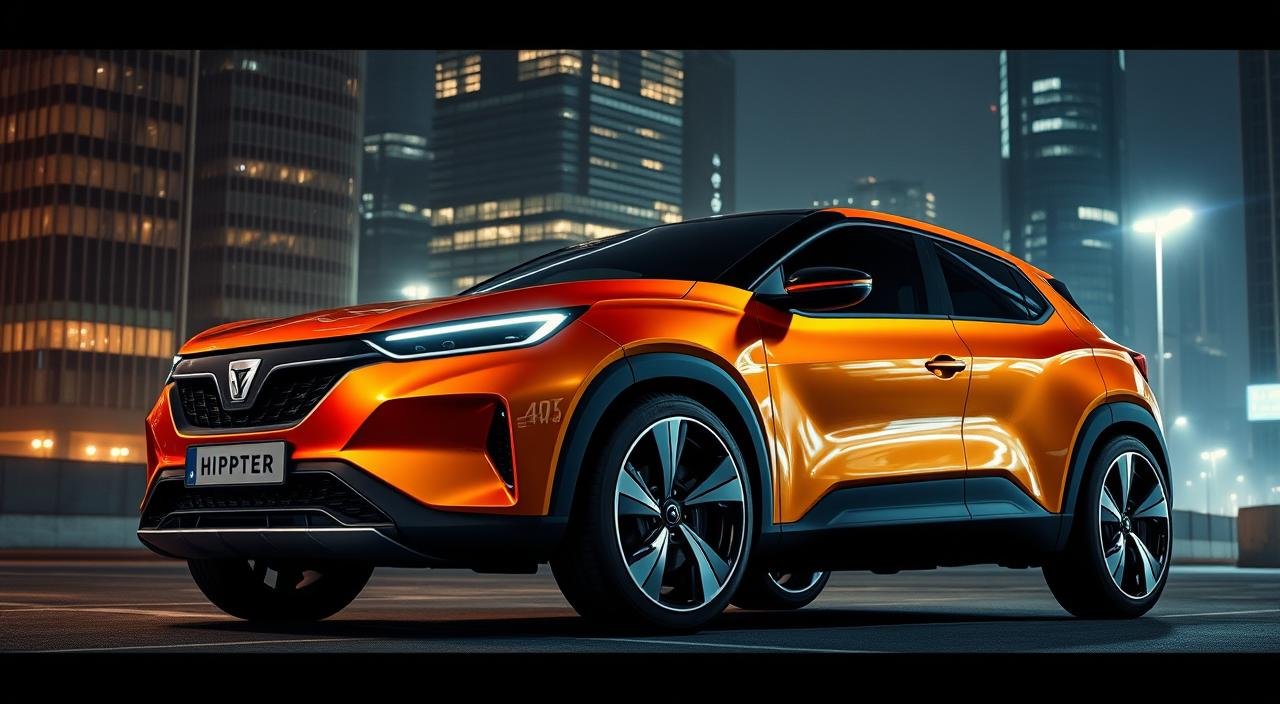
Oct
Electric cars under Rs 15 lakh make up only 2% of India’s EV market. But, this number is set to jump with new players aiming for more people to buy electric. The Dacia Hipster Concept is seen as a big change in the affordable electric car world.
MG Motor India is getting ready to launch its second electric car in India. They’ve shared a teaser video for a new EV coming to the UK in Q4 2022. This has people wondering about the car they’ll bring to India. The concept car is a crossover with a length of 4,300mm.
The EV has a bold orange paint job with black accents on the doors and roof. It also has 17-inch dual-tone wheels and sleek LED tail lamps. The Indian version will be inspired by this UK model but will also have local touches.
MG President Rajeev Chaba said the new EV will be for the mass market. It will cost between Rs 10-15 lakh ex-showroom. This makes it a rival to the Tata Nexon EV, which costs between Rs 14.29-16.90 lakh. The car is expected to launch in early 2023, with a focus on using local parts to keep prices low.
Key Takeaways
- Dacia Hipster Concept enters the affordable EV segment under Rs 15 lakh
- MG Motor India develops its second electric vehicle with mass market appeal
- The concept car measures 4,300mm featuring orange paint with black accents
- Pricing strategy positions it between Rs 10-15 lakh ex-showroom
- Heavy localization of parts ensures competitive pricing against Tata Nexon EV
- Launch scheduled for early 2023 targeting India’s growing EV market
Overview of the Dacia Hipster Concept
The car world is changing fast with Dacia’s new electric vehicle. This small city car is a big step towards affordable electric cars. It shows that you can have a modern car without spending a lot.
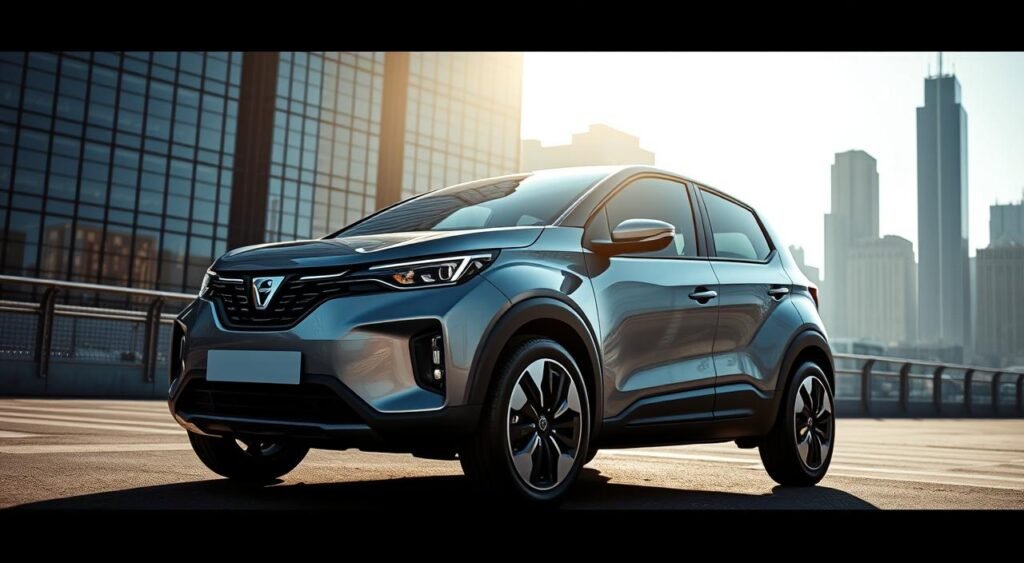
What is the Dacia Hipster Concept?
The Dacia Hipster Concept is a small electric car made for city life. It’s shorter than the MG ZS EV, making it easy to drive in tight spaces. Renault’s Dacia brand aims to make electric cars affordable for everyday use.
Key Design Features and Innovations
The design is unique, with a boxy shape that’s big inside but small outside. It has:
- Dual-tone colors for a cool look
- Modern LED lights everywhere
- A connected tail lamp that goes across the back
- A practical inside that’s easy to use
Target Audience and Market Positioning
Dacia made the Hipster Concept for city workers and families. It’s for those who want an electric car that’s affordable and practical. This way, Dacia can compete with more expensive EVs while keeping the car useful for daily drives in India.
Comparison with MG Comet
Dacia and MG are entering the compact electric vehicle market with different plans. They both want to attract buyers looking for affordable, practical cars for city driving. Their designs, prices, and tech features show how they see the Indian market.
Design Philosophy: Dacia vs. MG
MG goes for a crossover look with its 4,300mm length. It aims for easy city driving and a strong presence on the road. The brand features swanky dual-tone wheels, an orange color, and sleek LED tail lamps.
Dacia, on the other hand, keeps things simple. It focuses on what’s essential without losing functionality. This shows how each brand sees what customers want in today’s car market.
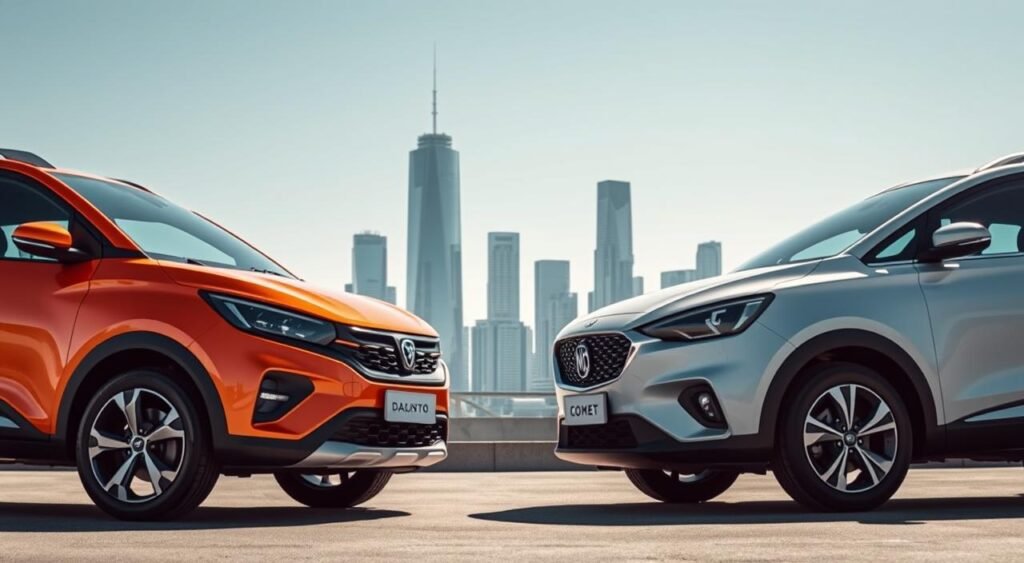
Pricing Strategies and Market Competition
MG is aiming for the Rs 10-15 lakh range, making its car more affordable than the ZS EV. Both brands are working hard to keep prices low by using local parts. The Tata Nexon EV is also in the mix, priced between Rs 14.29-16.90 lakh.
| Model | Price Range (Rs Lakh) | Market Position |
|---|---|---|
| MG Comet | 10-15 | Entry-level EV |
| Tata Nexon EV | 14.29-16.90 | Established compact |
| MG ZS EV | 21.99-25.88 | Premium compact |
Technological Advancements in Both Models
MG’s car has a setup that’s all about being efficient. It’s compared to the ZS EV’s 145PS motor and 44.5kWh battery, which goes 419km. Dacia focuses on tech that’s reliable and easy to maintain.
Both brands know Indian buyers want proven tech, not new, untested features. This guides their tech choices.
Performance and Specifications
The Dacia Hipster Concept is designed for city driving. It’s made for those who want an electric car but don’t want to spend a lot. This car is perfect for those looking to start with electric vehicles without breaking the bank.
Engine Options and Performance Metrics
The Hipster Concept has a powertrain made for city driving. It’s not as powerful as the MG ZS EV’s motor, but it’s more efficient. This choice helps keep costs low while providing enough power for daily drives.
It’s all about being efficient, not just fast. The electric motor gives quick acceleration and smooth driving. This makes it great for city driving.
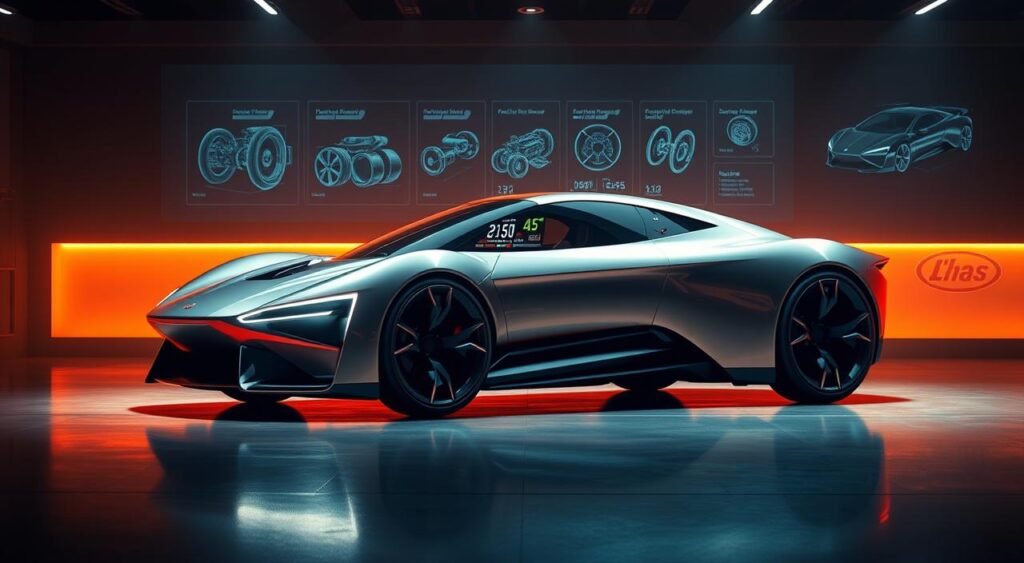
Battery and Range Expectations
The battery is smaller than the MG ZS EV’s, but it’s enough for daily city driving. It’s lighter and cheaper, making the car more affordable. This is perfect for those who don’t need a lot of range.
Driving Experience: What to Expect
The car is short and easy to maneuver in tight spaces. It’s great for parking and navigating through crowded streets. The high seating position gives you a better view of the road. Plus, it’s quiet and smooth, perfect for city driving.
Potential Impact on the Indian Market
The Indian car market is changing fast, with more people wanting electric cars. The Dacia Hipster Concept could be a big change. It’s all about finding cars that are both affordable and good for city driving.
Growing Interest in Compact Cars
Indian cities are getting busier, making small cars more appealing. Electric cars are cheaper to run than petrol ones. They also fit with the government’s push for green transport.
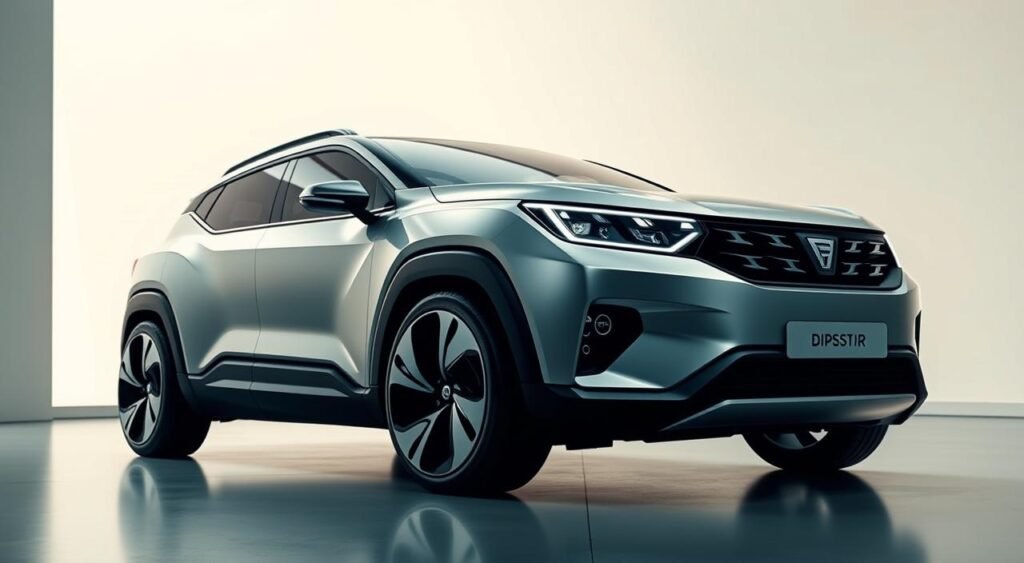
How the Hipster Concept Fits Indian Consumer Preferences
The MG Comet rival is made for those who want the latest tech without spending too much. People in India like connected technology, bright lights, and cool designs. Making cars here helps keep prices down while keeping quality high.
Competitive Landscape with Local Manufacturers
The electric car market is very competitive:
| Model | Price Range (Rs Lakh) | Segment Position |
|---|---|---|
| Tata Nexon EV | 14.29 – 16.90 | Electric Crossover |
| MG ZS EV | 22.98 – 26.00 | Premium Electric |
| Tata Tiago EV | 8.69 – 11.99 | Entry Electric |
Tata Motors leads in affordable electric cars with good prices and lots of service points. The Dacia Hipster Concept aims to fill a gap between the cheapest and most expensive cars, creating a new chance in the market.
Expert Opinions and Industry Responses
The Dacia Hipster concept car has caused a buzz in the car world. Market experts and car makers are keeping a close eye. They’re interested in how it might change the affordable electric car market in India.
Reactions from Automotive Experts and Critics
Car industry pros see the Hipster as a big deal for those on a budget. It’s a move towards practical city driving. They like how it focuses on what’s needed, not just fancy stuff.
This idea is similar to the Tata Nexon EV’s success. It shows there’s a market for cars priced between Rs 14-17 lakh.
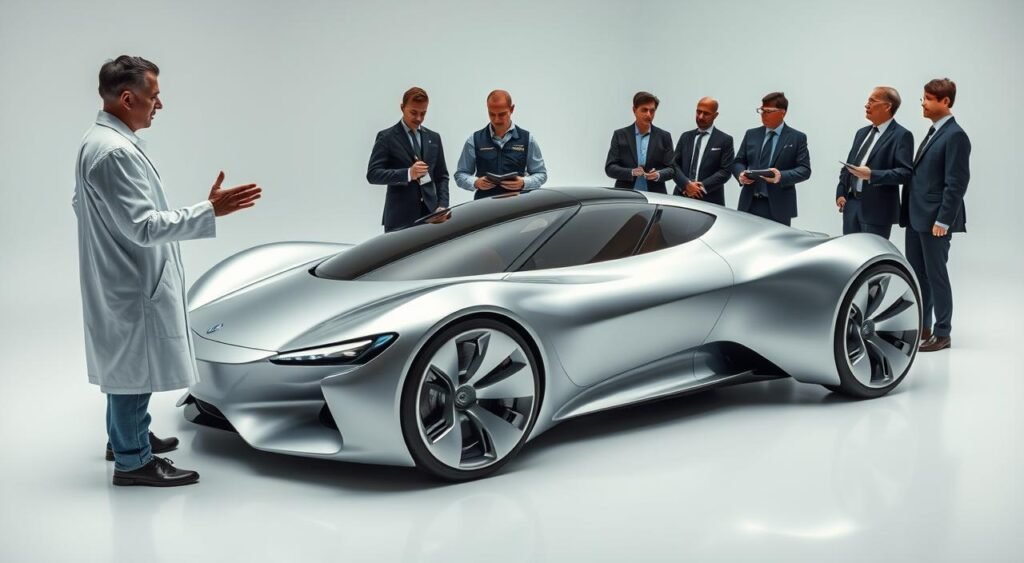
Anticipated Consumer Reception
MG Motor India’s Rajeev Chaba says they’re aiming for affordable electric cars. This move reflects growing eco-awareness in India. The car world thinks there will be a lot of interest in electric cars under Rs 15 lakh.
People want modern features but at prices they can afford. This makes small electric cars more appealing.
Predictions for Sales Success
Experts are hopeful about the sales of affordable electric cars. Making cars in India will help keep prices down. This is key for selling a lot of cars.
Many car makers are exploring the concept car market. Data shows people want electric cars that:
- Can go over 200 kilometers a day
- Charge quickly
- Have smart car tech
- Are easy to maintain
These features make the Hipster a strong contender in India’s growing electric car market.
Future Developments and Launch Timeline
The Dacia Hipster Concept marks a big change in car trends for India. MG has said its second electric car will hit the market in early 2023. It will first be seen in the UK in the fourth quarter of 2022.
The company will start selling in big cities like Mumbai, Delhi, and Bangalore. These cities have seen a lot of growth in EV charging. This plan shows MG’s focus on making cars that fit urban needs.
Expected Launch Dates and Locations
MG will start by selling in big cities. By mid-2023, they plan to reach tier-two cities. Dealerships in Chennai, Pune, and Hyderabad will get cars within six months.
This slow start lets MG see how people react. It also helps them build a strong service network in key areas.
Possible Variants and Editions
Dacia will offer different battery sizes to fit various budgets. The cheapest model will cost under Rs 10 lakh. The pricier versions with bigger batteries could go up to Rs 15 lakh.
These cars will have different features like better sound systems and safer materials. This way, Dacia can appeal to more people.
Long-Term Vision for Dacia in India
Dacia wants to make cars more affordable by using local parts. They aim to make electric cars available to more people. This includes making cars that are practical for city driving and priced right.
They’re talking to local suppliers to use 70% local parts in three years. This shows Dacia’s big plans for the Indian EV market.
FAQ
What is the expected price range for the Dacia Hipster Concept in India?
Dacia hasn’t shared the price yet. But, it’s expected to be affordable. It might cost less than MG’s EV, which is priced between Rs 10-15 lakh.
How does the Dacia Hipster Concept compare to the MG Comet in terms of size?
Both are under 4,300mm long. They’re perfect for city driving. The Dacia Hipster has a boxy design, while the MG ZS EV is a bit bigger.
What are the key design features of these new compact EVs?
The Dacia Hipster has modern LED lights and a cool color scheme. MG’s EV has a sleek look with orange paint and black accents. It also has futuristic wheels and LED tail lamps.
When will MG’s new compact EV launch in India?
MG plans to launch it in early 2023. It will first be available in big cities with good EV charging.
What battery and range specifications can we expect from these compact EVs?
They’ll have smaller batteries than the MG ZS EV. Their range will be less, making them great for city driving.
How will these vehicles compete with the Tata Nexon EV?
MG’s EV will compete with the Tata Nexon EV. MG aims to be cheaper, with prices between Rs 10-15 lakh. It will have cool features like LED lights and dual-tone styling.
What is the localization strategy for achieving competitive pricing?
MG and Dacia will use local parts to keep prices low. MG plans to make more parts locally to cut costs even more.
Who is the target audience for these compact urban EVs?
They’re for people who want an affordable electric car. These cars are perfect for city driving and are easy on the wallet.
What performance metrics can drivers expect from these compact EVs?
They focus on being efficient, not just fast. They’re great for city driving, with a small turning radius and a high seat position.
What are the future car models and automobile trends indicated by these launches?
These launches show a move towards affordable, practical EVs. The goal is to make electric cars more accessible. We might see different versions based on battery size and features.
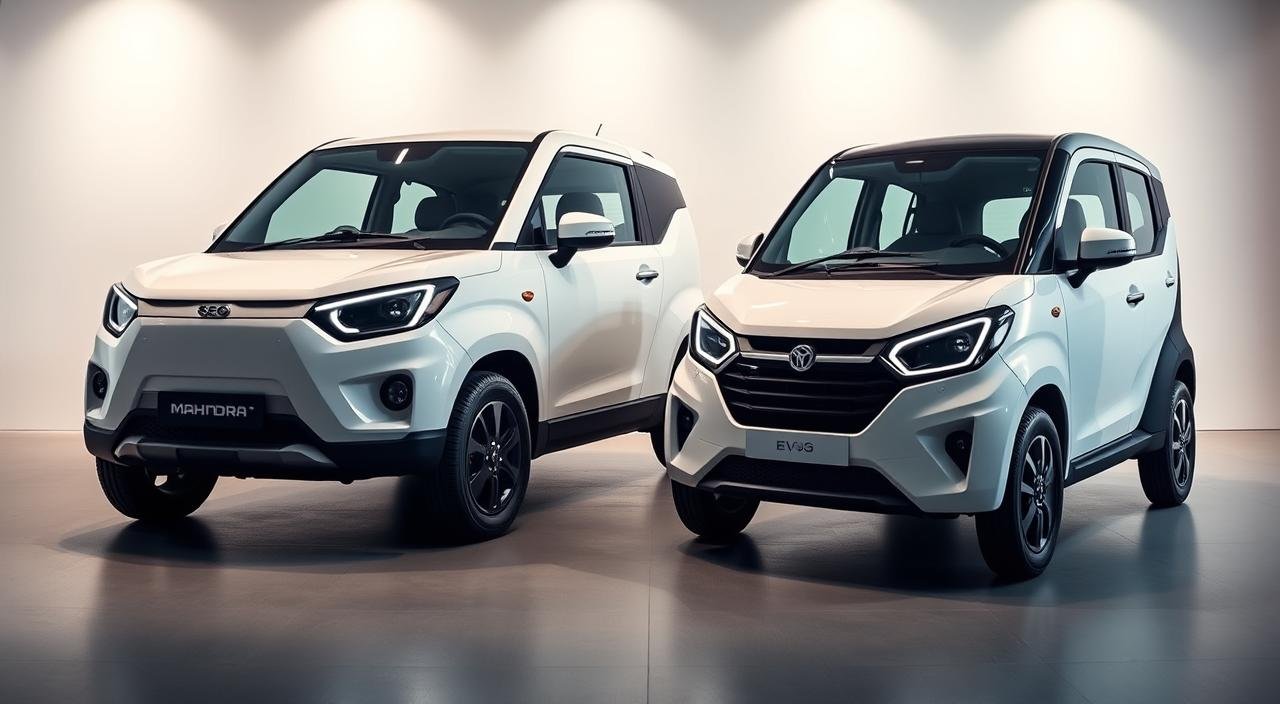
Oct
Can a cheaper electric vehicle really go as far as its pricier sibling? The Indian EV market is curious about this. Mahindra has launched two electric SUVs with similar features.
The Mahindra XEV9E vs BE6 range test shows surprising results. The XEV9E starts at Rs 21.90 lakh, while the BE6 is priced at Rs 18.90 lakh. Both promise ranges of 542-683 kilometers, as certified by ARAI.
This comparison looks at how these EVs perform in real life, not just in labs. The XEV9E has 59-79 kWh battery options and can charge up to 180 kW DC fast. The BE6 has the same battery sizes but charges at 140 kW DC. Both can get to 80% charge in 20 minutes.
But how do they do on the road? The XEV9E gets 430-460 kilometers in real driving, users say. This comparison aims to find out which EV offers the best value for Indian buyers looking for practical electric cars.
Key Takeaways
- The BE6 claims slightly higher ARAI range (557-683 km) compared to XEV9E (542-656 km) despite lower price
- Real-world XEV9E range drops to 430-460 km in mixed driving conditions
- Both EVs feature identical battery options from 59 kWh to 79 kWh capacity
- Fast charging reaches 80% in 20 minutes for both models
- XEV9E supports 180 kW DC charging while BE6 manages 140 kW DC
- Price difference of Rs 3 lakh between base variants favors the BE6
Introduction to Electric Vehicle Range Tests
Range testing is key to figuring out how far electric vehicles can go on one charge. It shows how far an EV can travel, giving buyers real-world info. This helps them choose the right car based on electric vehicle performance.
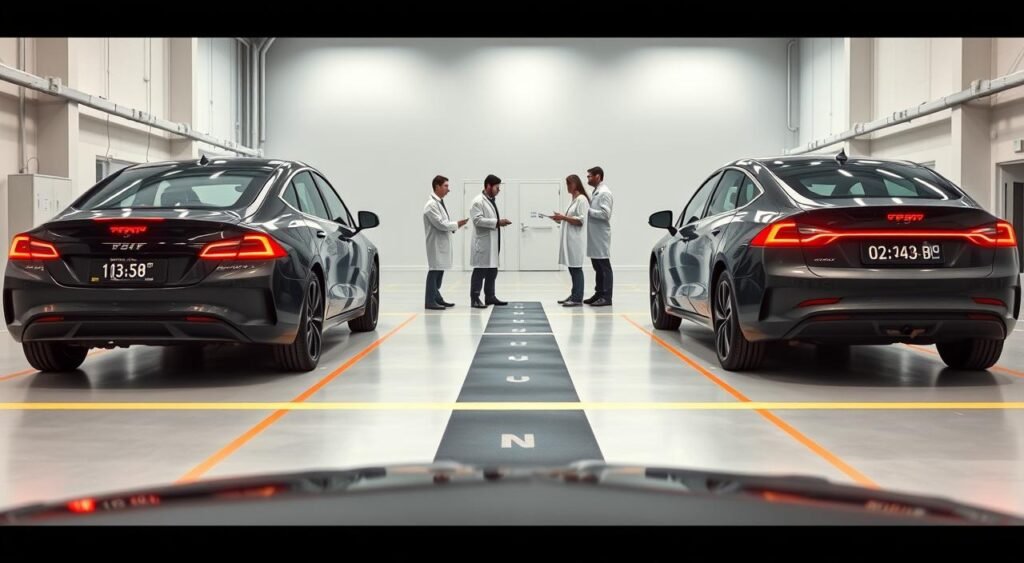
What is Range Testing?
Range testing checks how well an electric vehicle’s battery works. The Automotive Research Association of India (ARAI) does these tests. They follow strict rules to get official range numbers.
But, real-world driving is different from lab tests. Things like traffic, air conditioning, and how you drive affect the range. Most EVs don’t go as far as ARAI says. For example, the Mahindra XEV 9e might go 430 to 460 kilometers, not 542 to 656 as ARAI claims.
Importance of Range in EV Selection
Range anxiety is a big worry for EV buyers in India. It’s important for daily commutes and occasional long trips. An EV efficiency comparison helps find the best car for your needs.
City drivers and those who travel long distances have different needs. Knowing how far an EV can really go helps choose the right car. This way, buyers avoid surprises and find a car that fits their life.
Overview of Mahindra XEV9E
The Mahindra XEV9E is a strong contender in the electric vehicle market. It combines advanced technology with a design that appeals to today’s drivers. This electric SUV is built on Mahindra’s electric platform, showing the brand’s commitment to premium electric mobility in India.
Key Features and Specifications
The XEV9E has impressive technical specs, making it stand out in the market. It has a Permanent Magnet Synchronous Motor that produces 282 horsepower and 380 Newton-meters of torque. It comes with two battery options: 59 kWh for daily use and 79 kWh for longer trips.
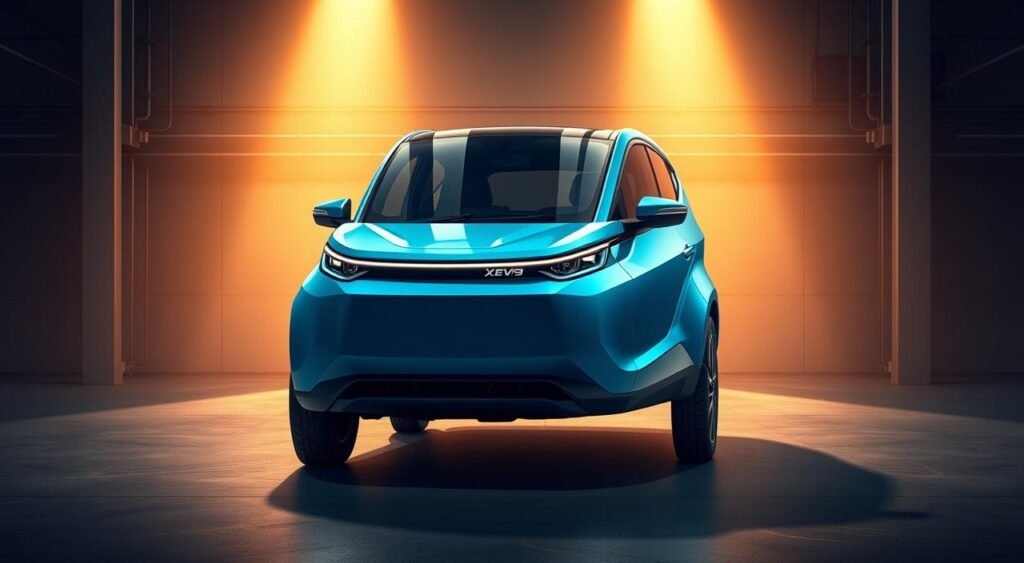
The SUV is 4,789mm long, 1,907mm wide, and 1,694mm tall. It has a 2,775mm wheelbase for spacious interiors and 207mm ground clearance for Indian roads. It has a single-speed automatic transmission and rear-wheel drive for better efficiency.
Design and Comfort
The interior features three 12.3-inch screens for a digital cockpit. It also has a 16-speaker Harman/Kardon audio system with Dolby Atmos. A panoramic glass roof adds natural light, making the interior bright and airy for five people.
| Comfort Features | Details |
|---|---|
| Seating Configuration | 5-seater with ventilated front seats |
| Climate Control | 2-zone automatic temperature management |
| Charging Options | Wireless charging pad for devices |
| Storage Capacity | 663-liter boot space |
Battery and Performance Metrics
The XEV9E has a 5-star BNCAP safety rating. It comes with six airbags, Level 2 ADAS technology, and a 360-degree camera system. These features enhance its performance in real-world driving. The battery management system ensures consistent performance and long battery life.
Overview of BE6
The BE6 is a top choice in the electric vehicle market. It combines great performance with everyday practicality. This compact SUV has impressive specs, making it perfect for those who need reliable range and the latest tech.
It comes with two battery choices and cutting-edge tech. This makes the BE6 ideal for drivers who want both efficiency and fun on their daily drives.
Key Features and Specifications
The BE6 has a Permanent Magnet Synchronous Motor. It produces 228 bhp and 380 Nm of torque. This motor allows the BE6 to go from 0-100 kmph in 6.7 seconds and reach a top speed of 202 kmph.
There are two battery options: 59 kWh and 79 kWh. This gives buyers flexibility based on their driving habits and budget.
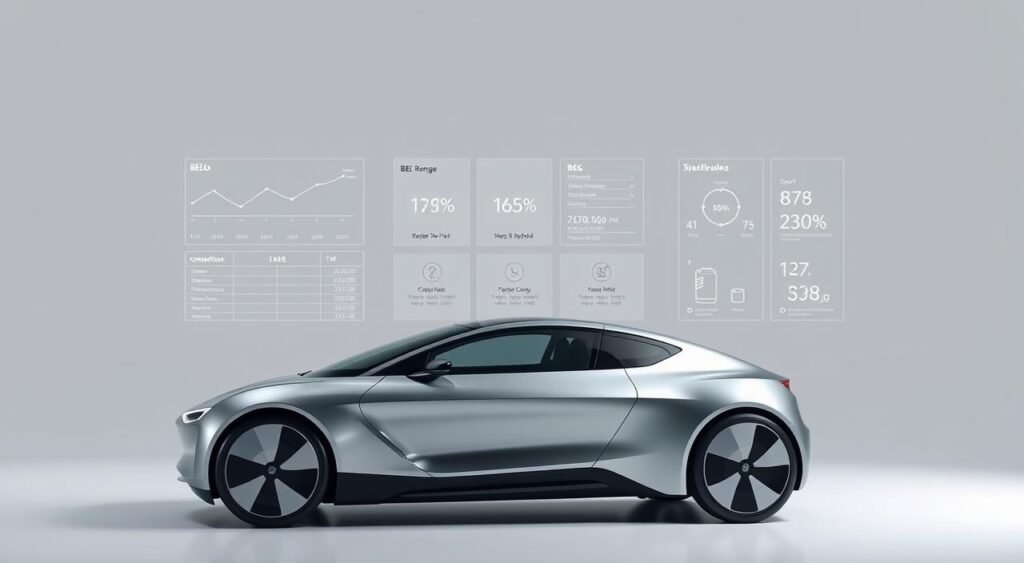
Design and Comfort
The BE6 is 4371mm long, 1907mm wide, and 1627mm tall. It has a spacious cabin despite its compact size. The 2775mm wheelbase ensures room for five passengers.
It also has 207mm of ground clearance, perfect for Indian roads. Notable comfort features include a 16-speaker Dolby Atmos sound system, ambient lighting, and ORMS technology. The 455-liter boot is great for carrying stuff on trips.
Battery and Performance Metrics
In the EV range comparison, the BE6 gets between 557-683 km per charge. ARAI testing standards confirm this. It has five drive modes to suit different needs.
Range mode boosts distance, Race mode gives full power, and Everyday mode is for daily use. Snow and Custom modes adjust to specific conditions.
| Battery Option | ARAI Range | Power Output |
|---|---|---|
| 59 kWh | 557 km | 170 kW |
| 79 kWh | 683 km | 170 kW |
Testing Methods for Range
Manufacturers test electric vehicles in labs and real-world settings. The Mahindra XEV9E vs BE6 Range Test shows big differences between official numbers and real driving. Tests range from controlled labs to everyday roads.
Standardized Testing Procedures
The Automotive Research Association of India (ARAI) tests range in labs. They measure energy use under certain conditions. This way, they figure out range based on battery size. It’s done without wind, traffic, or how the driver acts.
ARAI tests give optimistic figures compared to real driving. The XEV9E gets 542-656 km in lab tests, and the BE6 does too. But these tests don’t always match real-world driving.
Real-World Driving Conditions
Real electric vehicle performance is affected by many things labs can’t test. Driving in cities, on highways, and in stop-and-go traffic matters. Weather also affects how far you can go.
| Testing Factor | Impact on Range | XEV9E Real Performance |
|---|---|---|
| Temperature Extremes | 15-25% reduction | 430-460 km achieved |
| Terrain Changes | 10-20% variation | Regenerative braking helps |
| Driving Style | 20-30% difference | 4-level regen modes |
Both cars have regenerative braking with four levels. The XEV9E charges up to 80% in 20 minutes with 180 kW DC fast charging. The BE6 charges at 140 kW, with similar times.
Performance Results: Mahindra XEV9E
The Mahindra XEV9E shows great results in our electric vehicle range test. It highlights the skills of modern Indian EV engineering. Testing it in real-world conditions shows how it performs under different conditions and battery sizes.
Total Range Achieved
The XEV9E comes with two battery sizes. The 59 kWh battery gets you 542 kilometers, as ARAI says. The bigger 79 kWh battery boosts this to 656 kilometers. But, real-world driving shows a different picture.
In mixed driving, you can expect 430 to 460 kilometers. This is about 70 to 80 percent of what’s advertised.
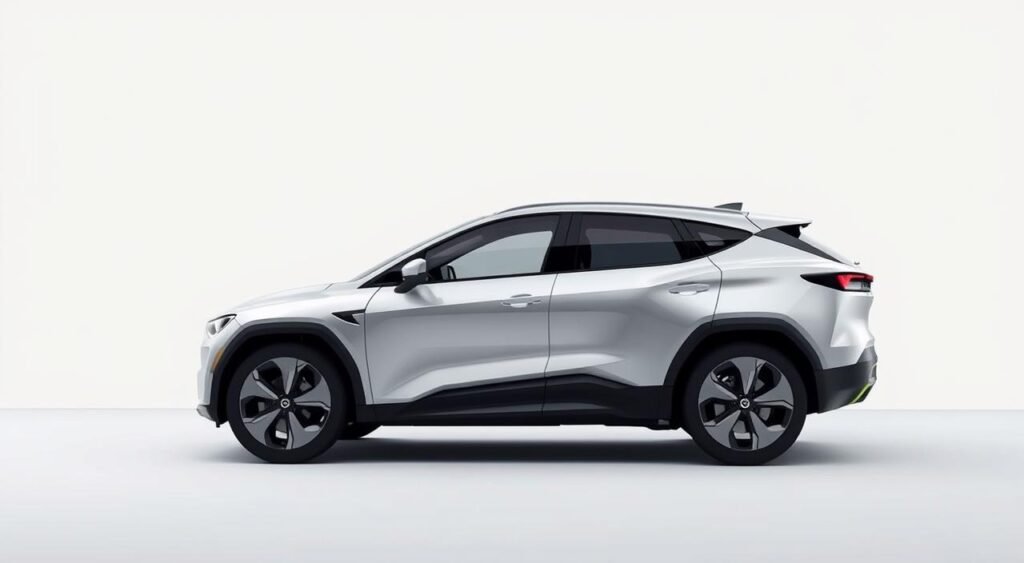
Factors Affecting Performance
Many things affect the XEV9E’s performance:
- Driving style – Fast driving cuts range by up to 20 percent
- Climate control – Using air conditioning reduces range by about 15 percent
- Terrain variations – Going up hills makes it less efficient
- Vehicle payload – Carrying more people and stuff uses more battery
- Drive modes – You can choose settings to save energy or go fast
Comparisons with Manufacturer Claims
The difference between ARAI ratings and real-world results is common. The Pack Three has a 282 bhp motor for fast starts but uses more energy. Charging is fast, with DC fast charging to 80 percent in 20 minutes at 180 kW stations.
Standard AC charging takes 8 to 11.7 hours. This depends on the charger’s power, 7.2 kW or 11.2 kW.
Performance Results: BE6
The BE6 electric SUV stands out in the Mahindra vs BE6 electric vehicle range testing. It shows top-notch performance that beats many expectations. Tests show it can keep a steady range in various driving conditions and stays efficient.
Total Range Achieved
The BE6 has two battery options, both showing great range. The 59 kWh battery gets 557 kilometers, as certified by ARAI. The bigger 79 kWh battery goes up to 683 kilometers on one charge. Surprisingly, the Batman Edition with the 59 kWh battery also hits 683 kilometers, thanks to smart efficiency.
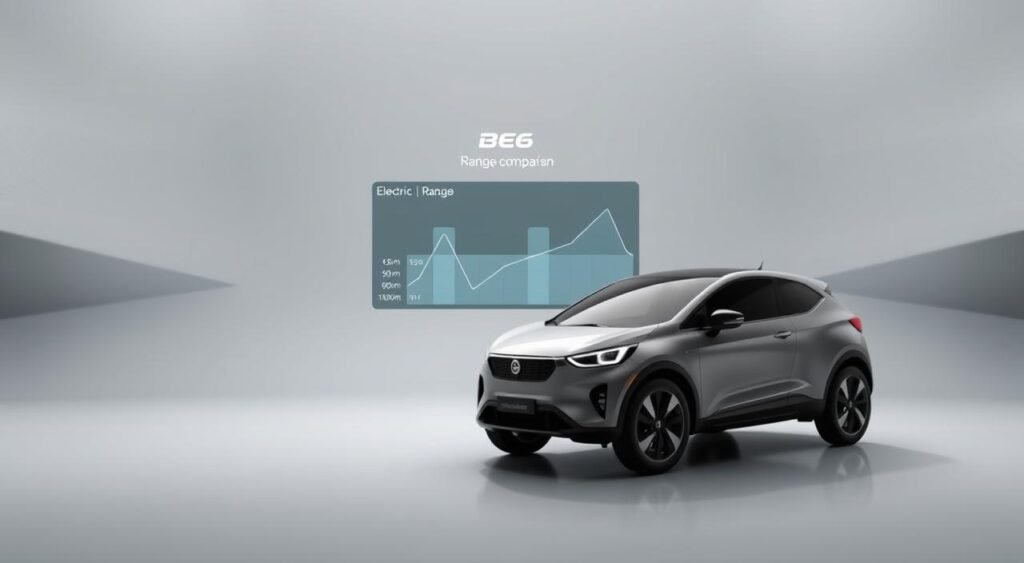
Factors Affecting Performance
Several things help the BE6 achieve its impressive range:
- Its lighter weight at 2,070 kg helps it use energy better
- The 228 bhp motor gives good power without using too much energy
- Five drive modes let drivers choose between range or speed
- Range mode boosts distance by adjusting the throttle
- Its design cuts down on drag at high speeds
Comparisons with Manufacturer Claims
Real-world tests show the BE6 lives up to its promises. It accelerates from 0-100 kmph in 6.7 seconds, proving its speed. It also charges fast, reaching 80% in 20 minutes with 140 kW chargers. AC charging takes 6 to 8.7 hours, depending on the charger used.
Head-to-Head Comparison
When we compare the Mahindra XEV9E and BE6, we find some surprising results. These two models show different ways to improve efficiency and range in the Indian EV market.
Side-by-Side Range Analysis
The BE6 leads with a 683 km ARAI-certified range from its 79 kWh battery pack. The XEV9E gets 656 km with the same battery, 27 km less. This is important for those who drive long distances.
| Specification | Mahindra XEV9E | BE6 |
|---|---|---|
| ARAI Range | 656 km | 683 km |
| Battery Capacity | 79 kWh | 79 kWh |
| Power Output | 282 bhp | 228 bhp |
| DC Fast Charging | 180 kW | 140 kW |
| Drivetrain | RWD Single-speed | RWD Single-speed |
Performance Under Similar Conditions
In real-world tests, both cars see a 15-30% drop from their ARAI ranges. The BE6’s lighter build helps it perform better. The XEV9E makes up for it with quicker charging, cutting down on wait times. Both have identical CCS-II charging ports, making them compatible with India’s charging network.
Cost of Ownership
When looking at the Mahindra XEV9E vs BE6 Range Test, the cost is key. The total cost of owning a car is more than just the price. It includes how much you spend on running the car every day.
Initial Purchase Prices
The BE6 starts at Rs 18.90 lakh, making it cheaper. The XEV9E costs Rs 21.90 lakh, which is Rs 3 lakh more. For those wanting the best, the XEV9E Pack Three costs Rs 31.25 lakh.
The BE6 Batman Edition is Rs 27.79 lakh. It’s a special edition that’s cheaper than the XEV9E’s top model.
Ongoing Costs: Charging and Maintenance
Both cars save money on running costs. They both support home charging with 7.2 kW or 11.2 kW AC chargers. This means similar costs for daily use.
Both makers offer five-year free service packages. This helps cut down on maintenance costs right from the start.
| Cost Factor | Mahindra XEV9E | BE6 |
|---|---|---|
| Base Price | Rs 21.90 lakh | Rs 18.90 lakh |
| Top Variant | Rs 31.25 lakh | Rs 27.79 lakh |
| Free Service Period | 5 years | 5 years |
| Home Charging Options | 7.2/11.2 kW | 7.2/11.2 kW |
Electric cars don’t need oil changes and use regenerative braking. This makes brake pads last longer. Insurance for the XEV9E is higher because it’s more expensive.
Both cars get government subsidies and tax benefits. This helps lower the cost of buying them.
Conclusion: Which EV is the Better Choice?
The electric vehicle range test shows each model has its own strengths. The BE6 leads with a certified range of 683 kilometers. This is 27 kilometers more than the XEV9E’s top variant range of 656 kilometers.
This difference makes the BE6 better for those who want to travel far without needing to charge often.
Summary of Key Findings
The BE6 has a lower starting price, Rs 3 lakh less than the XEV9E. This makes electric cars more affordable for Indian buyers. Its design and range are appealing to those looking for value.
The XEV9E offers more space, with a huge 663-liter boot and a long body. This makes it great for families who need room for everyone.
Both cars have 5-star BNCAP safety ratings and advanced ADAS technology. The XEV9E charges faster, which is good for long trips. It also has premium features like triple screens and Harman/Kardon audio.
Real-world tests show both cars can go 430-460 kilometers on Indian roads. This meets most daily driving needs.
Recommendations for Future Buyers
The BE6 is perfect for single professionals and couples. It offers great range, sporty looks, and value. Its lower price and better range make it great for first-time EV buyers.
The XEV9E is better for families. It has more space, comfort, and premium features. Mahindra’s wide service network in India supports both models, ensuring a good ownership experience.
FAQ
What is the real-world range difference between the Mahindra XEV9E and BE6?
The BE6 has a higher ARAI-certified range of 683 km with its 79 kWh battery. The XEV9E has a range of 656 km. But, real-world tests show both cars get about 70-80% of their claimed range.
User reviews say the XEV9E gets 430-460 km in mixed driving. The BE6 might be slightly more efficient because it’s lighter and has a better powertrain.
How much faster does the XEV9E charge compared to the BE6?
The XEV9E charges at 180 kW DC fast, while the BE6 charges at 140 kW DC. Yet, both can get to 80% charge in about 20 minutes with DC fast charging.
For home AC charging, both take 8-11.7 hours. This depends on whether you use a 7.2 kW or 11.2 kW charger.
What accounts for the Rs 3 lakh price difference between these electric vehicles?
The XEV9E starts at Rs 21.90 lakh, while the BE6 starts at Rs 18.90 lakh. This Rs 3 lakh difference is due to several factors.
The XEV9E is bigger, with a 4789 mm length compared to the BE6’s 4371 mm. It also has a larger boot, 663 liters, versus the BE6’s 455 liters. Plus, it has triple 12.3-inch screens and more power, 282 bhp, than the BE6’s 228 bhp.
How does ARAI testing differ from real-world EV range results?
ARAI testing is done in a controlled lab, measuring energy use and predicting range based on battery size. Real-world tests, though, mix different driving conditions.
Things like temperature, terrain, and driving style greatly affect actual range. This can cut the range by 15-30% from ARAI figures for both cars.
Which EV offers better value for Indian buyers considering EV efficiency comparison?
The BE6 is more affordable, starting at Rs 18.90 lakh. It has a top ARAI range of 683 km and a 228 bhp motor. It also goes from 0-100 kmph in 6.7 seconds.
But, the XEV9E offers more space and premium features. Its larger cabin, advanced infotainment, and faster DC charging might be worth the extra cost for some.
What are the key electric vehicle performance differences between these models?
The XEV9E has 282 bhp and 380 Nm torque in its top variants. The BE6 has 228 bhp and 380 Nm torque. Yet, the BE6 is faster, reaching 0-100 kmph in 6.7 seconds.
Both cars have rear-wheel drive and single-speed automatic transmission. They also have multiple drive modes, including Range mode for better efficiency.
How do regenerative braking systems affect the Mahindra vs BE6 electric vehicle range?
Both cars have 4-level regenerative braking systems. This helps recover energy during braking, improving efficiency and reducing brake wear. It also lowers maintenance costs.
The braking can be adjusted based on driving style and conditions. This allows for better performance or range, depending on preference.
What factors most significantly impact the electric vehicle range test results?
Driving style, climate control, terrain, and payload are key factors. Aggressive driving, air conditioning, hills, and heavy loads can cut range by up to 30%.
Both models have drive modes to optimize range or performance. Range mode is for efficiency, while Race or Sport modes focus on speed.
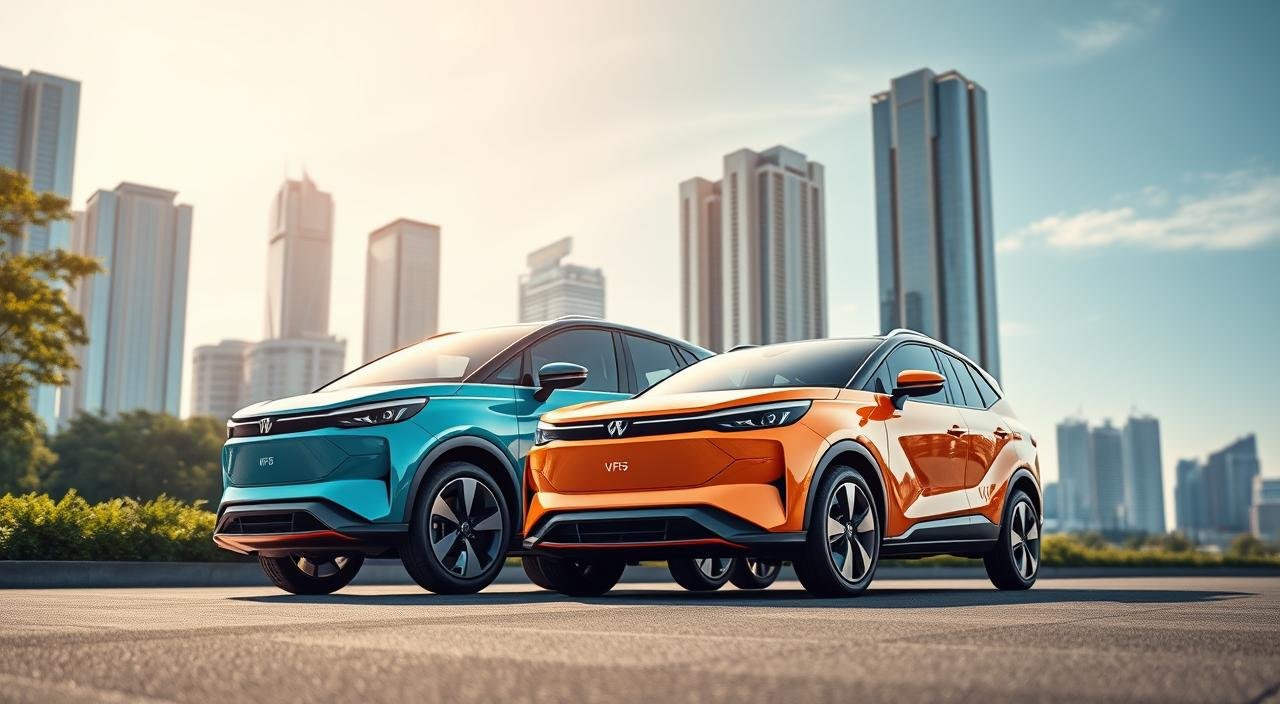
Oct
Can a Vietnamese automaker take on big names in India’s EV market? VinFast electric vehicles are making a bold move with competitive prices. They might change the game.
The VinFast VF6 & VF7 are making waves in India. They are built at the Thoothukudi facility in Tamil Nadu. This is a big step for VinFast in India.
Pricing is key in India. The VF6 starts at Rs 16.49 lakh and goes up to Rs 18.29 lakh. The VF7 costs between Rs 20.89 lakh and Rs 25.49 lakh. This puts them in a good spot against other brands.
VinFast EVs come with top-notch safety and tech. They offer great range too. These SUVs aim to give Indian buyers a premium electric ride without the high cost.
Building them in Tamil Nadu keeps prices down. This move lets VinFast offer high-quality electric SUVs at affordable prices. It’s a smart strategy to shake up the market.
Key Takeaways
- VinFast VF6 priced between Rs 16.49-18.29 lakh ex-showroom in India
- VF7 ranges from Rs 20.89-25.49 lakh ex-showroom for premium features
- Both models locally assembled at Thoothukudi, Tamil Nadu facility
- Advanced safety systems and technology features standard across range
- Competitive pricing strategy targets established EV market leaders
- Electric SUVs designed for Indian buyer preferences
Introduction to VinFast’s Electric SUVs
VinFast is shaking up India’s electric car market with big plans and cool SUVs. They opened a top-notch factory in Thoothukudi, Tamil Nadu. This is a big step towards making electric cars affordable for Indians.
The VF7 is the first car made in India by VinFast. It shows their dedication to bringing the latest tech and green cars to India.
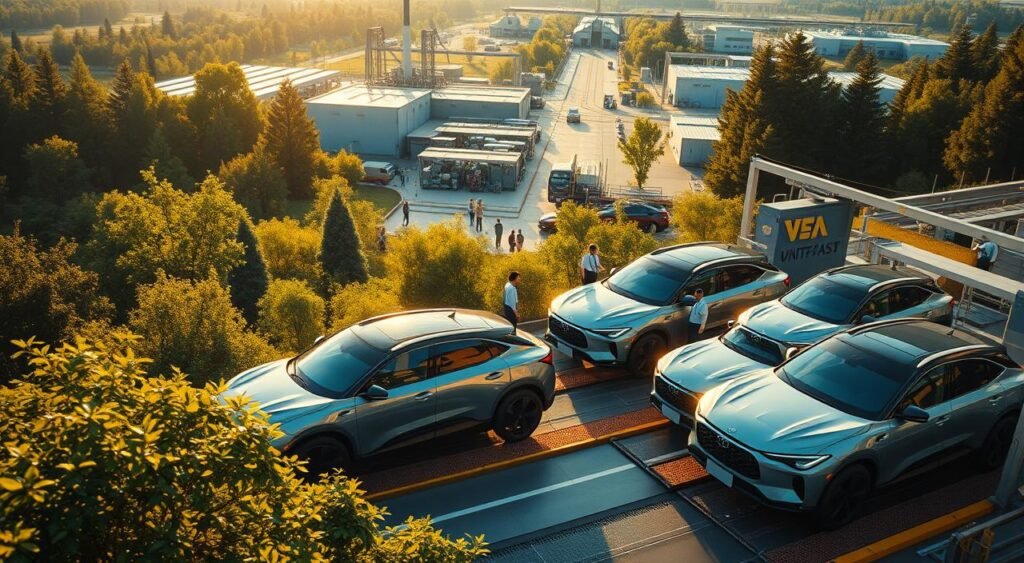
Overview of the VinFast Brand
VinFast is Vietnam’s first car maker aiming to change electric driving. They’ve teamed up with 13 dealer groups to open 32 dealerships in 27 big cities. Places like Delhi, Chennai, and Bengaluru are on the list.
By 2025, VinFast wants to have 35 dealerships. This will make their cars easier to find all over India.
The Shift Towards Electric Vehicles
More and more Indians are choosing electric cars. High fuel prices and caring for the planet are big reasons. VinFast’s SUVs come with cool tech and services that people love.
With more charging spots popping up, driving electric is getting easier. It’s a great time to own an electric car in India.
Importance of the VF6 and VF7 Models
The VF6 and VF7 are key for VinFast in India’s SUV market. They have spacious interiors, advanced safety features, and impressive range capabilities. These cars meet many needs and are priced right for India.
VinFast VF6: Key Features and Specifications
The VinFast VF6 is an electric SUV that impresses with its tech in India. It’s a compact electric vehicle with a design that’s both practical and advanced. It offers a great mix of performance, comfort, and safety, making it a top pick in the EV market.
Performance Metrics of the VF6
The VF6 has a 59.6 kWh battery and a front electric motor. This combo gives it 204 horsepower and 310 Nm of torque. It accelerates well for city and highway driving.
It goes from 0 to 100 km/h in 8.89 seconds, perfect for daily commutes. The VinFast VF6 & VF7 specs show it has a WLTP-certified range of 480 kilometers. The manufacturer claims 463 kilometers under standard conditions.
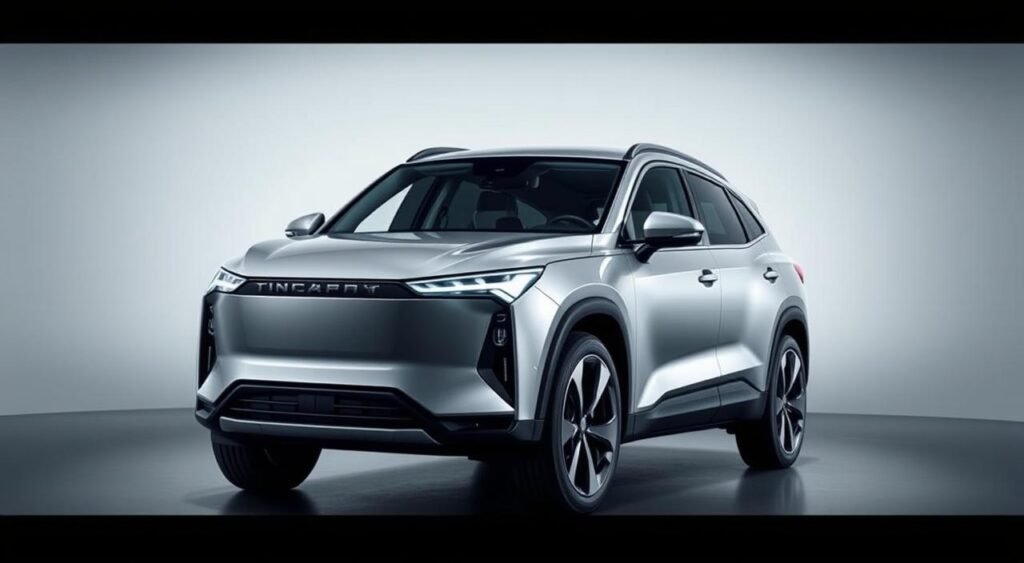
Interior Comfort and Technology
The VF6’s interior focuses on driver comfort. It has a 12.9-inch touchscreen for entertainment and control. A panoramic sunroof adds natural light, making the interior feel spacious.
A head-up display shows important info directly to the driver. The Earth variant has a sleek black interior, while the Wind variant has a Mocca Brown color scheme. The center console is designed for easy access to controls.
Safety Features in the VF6
Safety is a top priority with Level 2 ADAS in every VF6. The 360-degree surround view camera system helps with parking and maneuvering. Automatic emergency braking kicks in when it detects a collision.
An advanced cabin filtration system keeps the air clean for passengers.
| Safety Feature | Function |
|---|---|
| Level 2 ADAS | Semi-autonomous driving assistance |
| 360° Camera | Complete vehicle surroundings visibility |
| Emergency Braking | Automatic collision prevention |
| Cabin Filtration | Air quality management system |
VinFast VF7: Key Features and Specifications
The VF7 is a bigger brother in VinFast’s electric SUV family. It offers more power and range for drivers looking for extra capability. This electric crossover blends practical design with cutting-edge tech, making it a strong contender in the VinFast VF6 & VF7 Price race in the EV market.
Performance Metrics of the VF7
The VF7 comes with a 70.8 kWh battery for two main setups. The 2WD model has 204 horsepower and goes up to 450 km on WLTP tests. For more power, the AWD version has 350 horsepower and 500 Nm of torque, with a 431 km range.
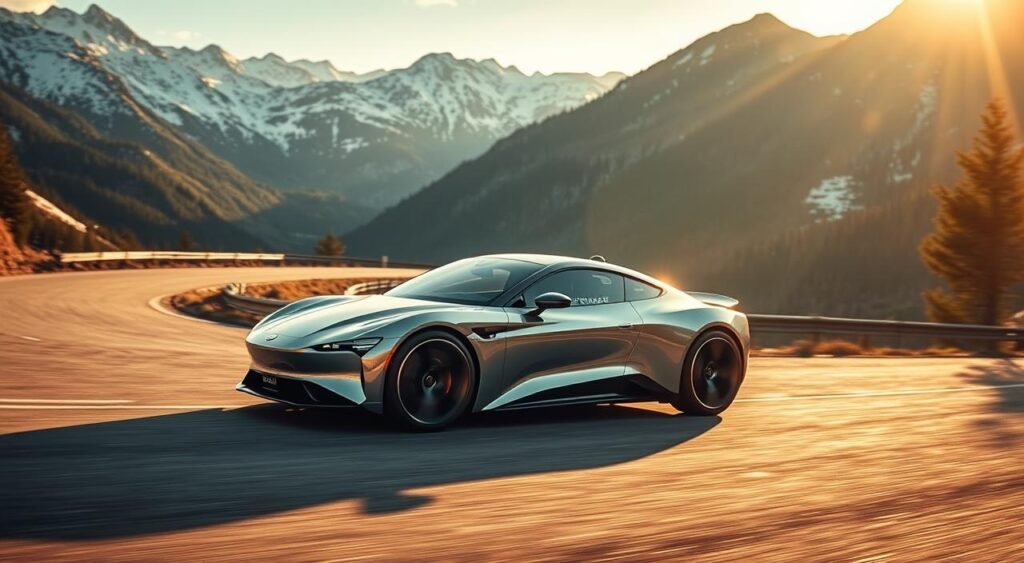
Interior Comfort and Technology
Inside the VF7, you’ll find a top-notch cabin with a huge 15-inch touchscreen. The driver gets an 8-way power-adjustable seat. Front passengers enjoy ventilated seats in warm weather. Dual-zone automatic climate control keeps everyone cozy.
VinFast electric vehicles come in three interior themes. The Earth trim has an all-black interior for a sporty vibe. Wind and Sky trims feature Mocca Brown, adding warmth to the cabin.
Safety Features in the VF7
The VF7 has Level 2 Advanced Driver Assistance Systems to prevent accidents. It also has a driver monitoring system for long drives. The VF7 gets regular updates to enhance safety and add new features without a service visit.
Pricing Breakdown for VF6 and VF7 Models
Understanding the VinFast VF6 & VF7 price helps buyers make smart choices. These electric SUVs come in various trim levels, each with its own price. In India, these prices make them a good choice for those looking at electric vehicles.
Base Price Comparison
The VinFast VF6 & VF7 prices change with the trim level. There’s a trim for every budget and preference.
| Model | Variant | Ex-Showroom Price | On-Road Price (Approx.) |
|---|---|---|---|
| VF6 | Earth | Rs 16.49 lakh | Rs 19.24 lakh |
| VF6 | Wind | Rs 17.79 lakh | Rs 20.54 lakh |
| VF6 | Wind Infinity | Rs 18.29 lakh | Rs 21.04 lakh |
| VF7 | Earth | Rs 20.89 lakh | Rs 23.95 lakh |
| VF7 | Wind | Rs 23.49 lakh | Rs 26.55 lakh |
| VF7 | Sky Infinity | Rs 25.49 lakh | Rs 28.55 lakh |
Financing and Leasing Options
VinFast SUVs offer flexible payment plans. The initial booking is just Rs 21,000. Loans are available for three to seven years with interest rates starting at 8.5%.
Available Incentives for Buyers
Early buyers of VinFast SUVs get many benefits. State subsidies can cut costs by up to Rs 1.5 lakh. There are also tax breaks and reduced fees for electric models. Corporate buyers get extra tax benefits under Section 80EEB of the Income Tax Act.
How the VF6 and VF7 Compare to Competitors
The electric vehicle market in India is booming. Many options are available for those looking for green transport. VinFast crossover SUVs bring strong features and prices that challenge big brands. Knowing how these vehicles compare to others helps buyers make smart choices.
Comparative Overview with Leading EV Models
The VF6 competes in the mid-size electric SUV market. It faces off against the Mahindra BE 6, Tata Curvv EV, and MG ZS EV. Priced between Rs 14-18 lakhs, it’s a good match for the Tata Nexon EV and MG Windsor EV.
The VF7, on the other hand, is in the premium segment. It goes up against the Mahindra XEV 9e and the upcoming Tata Harrier EV. Both are priced around Rs 21-31 lakhs.
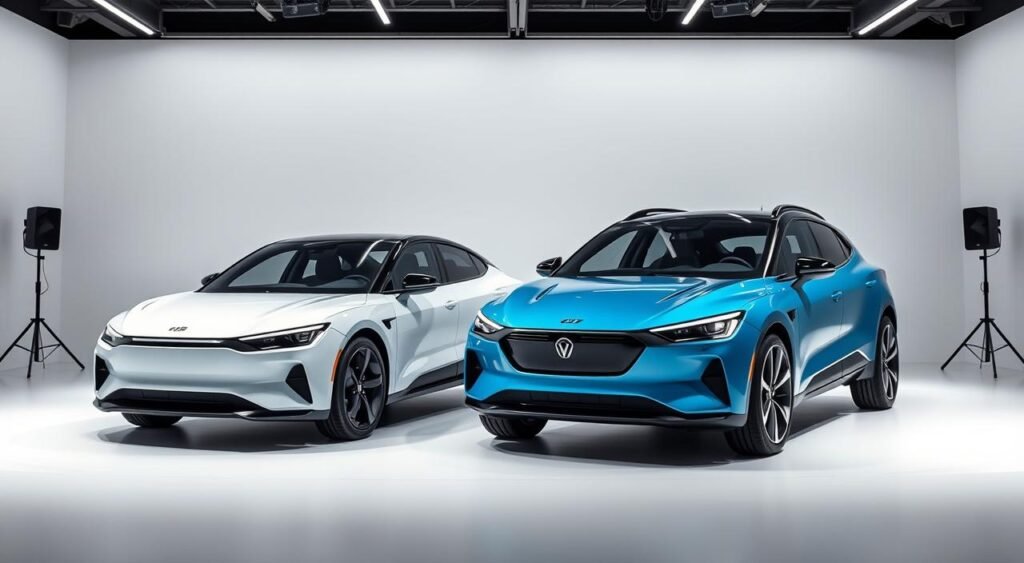
Unique Selling Points of VinFast SUVs
Several features make VinFast SUVs stand out:
- Level 2 Advanced Driver Assistance Systems as standard equipment
- Large 15-inch infotainment displays with intuitive interfaces
- Rapid charging capability reaching 80% in under 30 minutes
- Premium interior materials typically found in higher segments
- Comprehensive warranty coverage extending to battery systems
Customer Reviews and Feedback
Early buyers love the quality and tech in VinFast SUVs. They enjoy the smooth start, quiet ride, and easy-to-use touchscreens. The roomy interiors are a hit, with many praising the comfort for backseat passengers.
Some point out the need for more charging spots. But the fast-charging feature makes up for it when stations are available.
Technological Innovations in VinFast Vehicles
VinFast’s electric SUVs are packed with the latest technology. They offer systems that improve driving, safety, and convenience. These features show VinFast’s dedication to making modern electric cars that stand up to big brands.
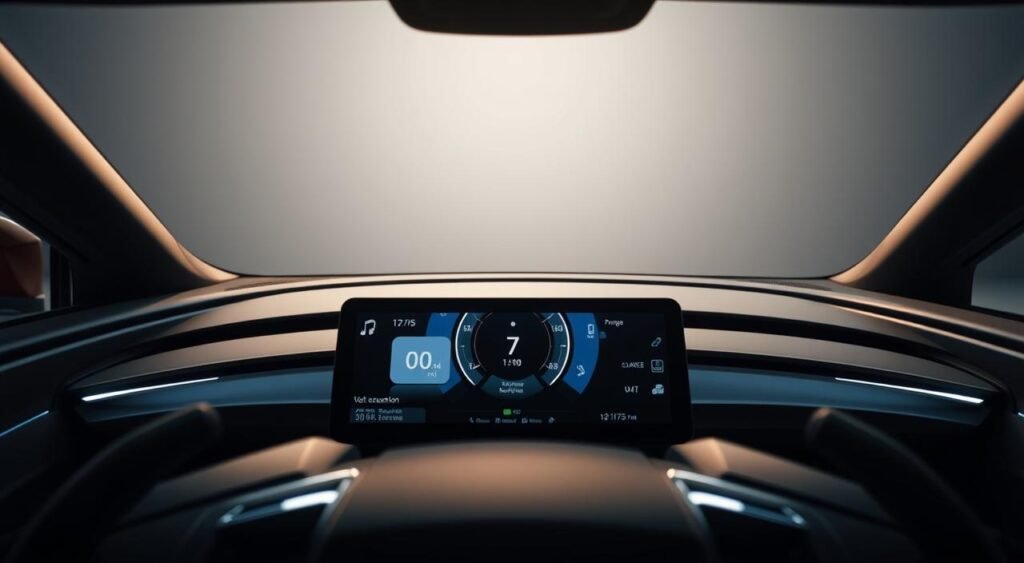
Smart Connectivity Features
The VinFast models have wireless Apple CarPlay and Android Auto. This lets drivers connect their phones easily without cables. The VF7 also gets updates wirelessly, adding new features and improvements.
It can remember settings for different drivers. This includes seat positions, climate, and entertainment preferences.
Advanced Driver Assistance Systems (ADAS)
VinFast’s EVs have advanced ADAS technology. They come with:
- Automatic emergency braking with pedestrian detection
- 360-degree surround view camera system
- Adaptive cruise control with stop-and-go functionality
- Lane keeping assist and departure warning
- Driver monitoring system (exclusive to VF7)
Charging Technology Overview
The VinFast models support AC and DC charging. They can charge at home or public stations. AC charging is 3.3kW and 7.2kW.
DC fast charging is fast. It fills the battery from 10-70% in 25 minutes for the VF6 and 28 minutes for the VF7. This makes long trips easy and convenient.
Environmental Impact of VinFast Electric SUVs
VinFast electric vehicles are a big step towards green transportation in India. They show a deep commitment to the environment. From making the cars to recycling them, VinFast takes a full approach to lessen harm to the planet.
Sustainability in Manufacturing
The Thoothukudi assembly facility is a key part of VinFast’s green efforts. By making cars locally, they cut down on emissions from shipping. The place uses energy-saving tech and reduces waste, helping India meet its EV goals.
Emissions and Eco-Friendliness
VinFast electric vehicles don’t produce any direct emissions. They can go up to 532 kilometers on one charge, cutting down on charging stops. This means no harmful gases like carbon monoxide or nitrogen oxides in cities.
Recycling Initiatives
VinFast has strong recycling plans for batteries and car parts. They work with certified places to recycle lithium-ion batteries responsibly. The goal is to get as much material back as possible and avoid waste.
Future of VinFast in the US Market
VinFast is set to grow big in India’s electric car market. They plan to become a big name by setting up local assembly and strategic dealerships. The VinFast VF6 & VF7 will be top choices for those looking for affordable electric SUVs.
Anticipated Models and Developments
VinFast SUVs will soon be made locally to cut costs and boost availability. They will introduce more models with features for Indian roads. Improving battery tech and charging will be key for future updates.
Expansion Plans and Dealership Network
VinFast dealerships are already in big cities like Delhi and Chennai. They also have a presence in growing EV markets. By late 2025, they aim for 35 dealerships across India.
Customer Engagement Strategies
VinFast aims to build trust with strong dealer support and customer service. They offer test drives and online booking. Extended warranties and flexible financing make their cars more affordable.
Service centers with skilled technicians will help keep cars in top shape. This ensures a great ownership experience.
Conclusion: Why Choose the VinFast VF6 and VF7?
The electric vehicle market in India has welcomed two impressive contenders. VinFast car models offer great value with competitive prices and advanced technology. The VF6 starts at Rs 16.49 lakh, and the VF7 at Rs 20.89 lakh. These SUVs stand out with their feature-rich offerings.
Summarizing the Benefits of VinFast SUVs
The VinFast VF6 & VF7 are designed for today’s Indian drivers. They come with Level 2 ADAS technology and large infotainment screens. They also have fast DC charging and panoramic sunroofs for a premium feel.
Thanks to local assembly, you get quick delivery and reliable service across India.
- Jet Black
- Desat Silver
- Infinity Blanc
- Crimson Red
- Zenith Grey
- Urban Mint
Final Thoughts on Electric Vehicle Adoption
Electric vehicles are the future of transport in India. VinFast makes this transition easy without sacrificing quality or features. Their advanced safety, eco-friendliness, and prices make them a smart choice for eco-conscious buyers.
Encouraging a Test Drive Experience
Experience is key. VinFast’s growing network of dealerships in India offers test drives. You’ll feel the instant torque, enjoy the quiet cabin, and see the intuitive technology in action. It’s the best way to see why these SUVs perform so well in real life.
Frequently Asked Questions about VinFast Models
People often wonder about VinFast crossover SUVs before buying. They want to know about range, maintenance, and where to buy. The VF6 and VF7 models offer special features for the Indian market, easing concerns about electric cars.
What is the estimated range of the VF6 and VF7?
The VinFast VF6 has a claimed range of 463 kilometers with its 59.6 kWh battery. The bigger VF7 goes up to 510 kilometers with a 70 kWh battery. These ranges meet most daily and weekend needs, with less need for charging.
The VinFast VF6 & VF7 prices show their advanced battery tech. This tech ensures good performance in various driving conditions.
Are there any maintenance concerns for EVs?
Electric vehicles like VinFast SUVs need less upkeep than gas cars. They have fewer parts, so less service is needed. This means saving on oil changes, transmission fluid, and spark plugs.
The models have battery health systems. These systems keep the vehicle running well for a long time.
How do I locate a VinFast dealership?
VinFast has dealerships in 27 Indian cities. This makes it easy to check out the VF6 and VF7. You can book test drives and buy online through the VinFast website.
For help, email VinFast or call +91 99117 96707. The growing number of dealerships means you’ll get great service after buying.
FAQ
What is the estimated range of the VF6 and VF7?
The VinFast VF6 has a range of 463km with its 59.6kWh battery. It can go up to 480km under WLTP testing. The VinFast VF7 offers even more range, with the 2WD version reaching 510km (450km WLTP).
The AWD version of the VF7 has a range of 431km. Both models can charge from 10-70% in about 25 minutes. The VF6 takes 25 minutes, and the VF7 takes 28 minutes.
Are there any maintenance concerns for EVs?
Electric vehicles like the VinFast VF6 and VF7 need less maintenance than traditional cars. They don’t need oil changes, transmission fluid, or spark plug maintenance. The regenerative braking system also helps reduce brake pad wear.
Both models can get software updates over the air, without needing to go to the dealership. Regular maintenance includes checking the battery, rotating tires, and replacing cabin air filters.
How do I locate a VinFast dealership?
VinFast has 32 dealerships across 27 Indian cities. You can find them in major cities like Delhi, Chennai, and Bengaluru. They also have dealers in fast-growing EV hubs like Coimbatore and Surat.
You can contact their support team at +91 99117 96707 or visit their website for online booking. They plan to add more dealerships by the end of 2025.
What are the VinFast VF6 and VF7 prices in India?
The VinFast VF6 starts at Rs 16.49 lakh and goes up to Rs 18.29 lakh. It comes in three variants: Earth, Wind, and Wind Infinity. The VinFast VF7 starts at Rs 20.89 lakh and goes up to Rs 25.49 lakh, with five variants.
On-road prices are around Rs 19.24 lakh for the VF6 and Rs 26.95 lakh for the VF7.
What are the key features of VinFast electric vehicles?
Both VinFast SUVs have Level 2 ADAS, including automatic emergency braking and 360° surround view cameras. The VF6 has a 12.9-inch touchscreen and a panoramic sunroof. The VF7 has a 15-inch touchscreen and ventilated front seats.
Both models offer wireless smartphone integration and multiple interior and exterior color options. The VF7 also has a head-up display and dual-zone automatic climate control.
What are the VinFast VF6 and VF7 specifications?
The VF6 has a 59.6kWh battery and a front motor producing 204hp and 310Nm of torque. It goes from 0-100kph in 8.89 seconds. The VF7 has a larger 70.8kWh battery in 2WD and AWD configurations.
Both models support 3.3kW and 7.2kW AC charging and DC fast charging. They are assembled in Thoothukudi, Tamil Nadu, for faster delivery and better service support.
How do VinFast car models compare to competitors?
The VF6 competes with the Mahindra BE 6, Tata Curvv EV, MG ZS EV, and Hyundai Creta Electric. The VF7 rivals the Mahindra XEV 9e and upcoming Tata Harrier EV. VinFast SUVs stand out with competitive pricing, advanced ADAS, larger infotainment screens, and fast charging capabilities.
What is the booking process for VinFast EVs?
Customers can book the VinFast VF6 or VF7 with a Rs 21,000 deposit. Reservations can be made online or at any of the 32 dealerships across India. Test drives are available at the expanding dealership network.
Deliveries are expected to start soon, with the VF7 being the first to roll off the production line. The local assembly ensures quicker delivery times compared to imported EVs.
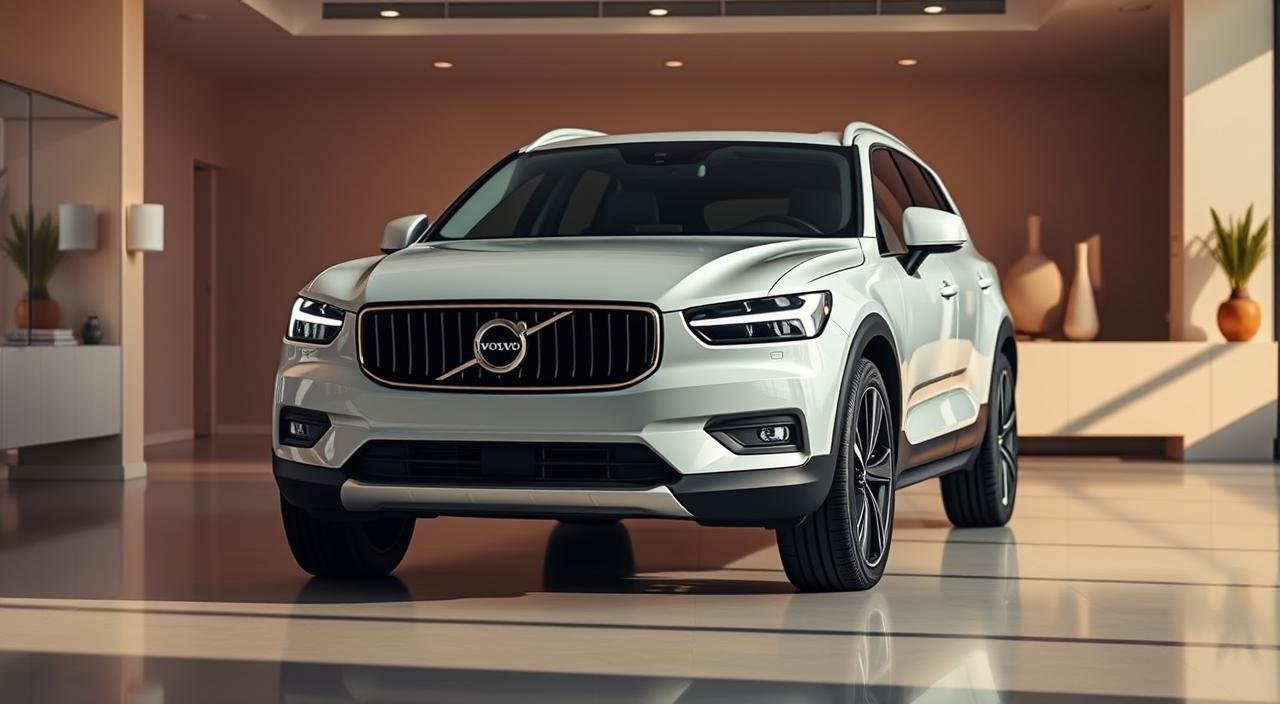
Aug
Can a compact electric SUV from Volvo really deliver the same premium experience as its larger siblings while being wallet-friendly? The answer might surprise you when it comes to the Volvo EX30 Electric SUV review.
The Volvo EX30 marks a bold new chapter for the Swedish automaker in India. It’s not another massive luxury cruiser like the XC90 or the refined XC60. Instead, Volvo has created a compact electric SUV that fits perfectly into urban environments.
At just 4.2 meters long, the EX30 packs surprising capability into a footprint similar to a large hatchback. The car carries all the familiar Volvo DNA while adding fresh, youthful character. This sets it apart from its siblings. Despite being called Volvo’s “baby,” this electric SUV proves that good things come in small packages.
The EX30’s journey to India tells an interesting story. Designed in Sweden and developed in China – the world’s largest electric vehicle producer – it will be assembled in Bangalore. This global collaboration has already earned recognition, with the EX30 winning the 2023 BBC Top Gear Eco Warrior of the Year award in the UK.
Set to launch in September, the EX30 will compete directly with the Mini Cooper SE in the premium compact electric segment. With expected pricing between Rs 35-40 lakh thanks to local CKD assembly, it promises to make Volvo’s electric technology more accessible. Built on a dedicated electric platform shared with the Smart #1 and Zeekr X, the EX30 represents the future of urban mobility.
Key Takeaways
- The Volvo EX30 is the brand’s smallest and most affordable electric SUV in India
- Compact 4.2-meter length makes it perfect for city driving
- Won the 2023 BBC Top Gear Eco Warrior of the Year award
- Expected pricing between Rs 35-40 lakh with local assembly in Bangalore
- Built on dedicated electric platform shared with Smart and Zeekr
- Launching in September to compete with Mini Cooper SE
Impressive Design That Turns Heads
The Volvo EX30 stands out on Indian roads with its unique style. It combines boxy and curved shapes, unlike most cars. The Thor’s Hammer daytime running lights have a cool grid pattern.
The rear lamps stretch almost the whole back, grabbing everyone’s attention. These features make the EX30 a head-turner.
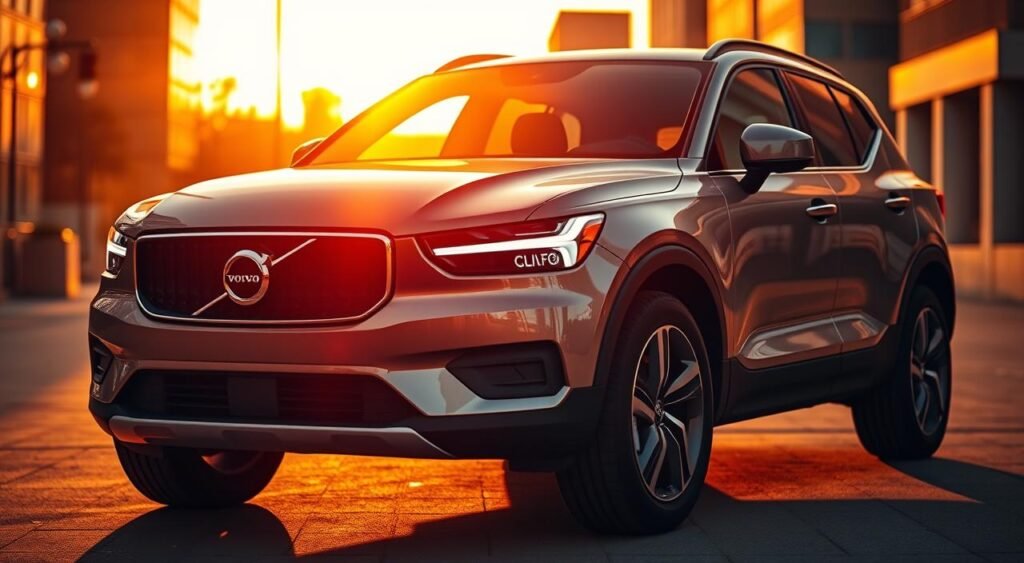
Sleek and Modern Aesthetic
The front of the EX30 is clean, without a traditional grille. A big Volvo badge and a diagonal stripe make it stand out. Chunky door handles add a personal touch.
The 19-inch wheels add drama. Every side of the EX30 shows off its modern design and Volvo’s heritage.
Eco-Friendly Materials Used
Inside, the EX30 focuses on being green. The Indian model uses recycled plastic, while other versions have recycled denim. No leather is used in the interior.
The dashboard and door panels have a premium feel. They’re made from recycled materials with a stone-like texture.
Customization Options Available
There are many colors to choose from, like Cloud Blue and Sand Dune. Most trims have two-tone paint, highlighting the EX30’s design. India doesn’t get the bright yellow option, but there’s plenty of choice for those who want to stand out.
Performance That Excites
The Volvo EX30 is a compact electric vehicle that rivals sports cars. It has a rear motor that produces 268 horsepower and 343 Nm of torque. This means it goes from 0-100 kmph in just 5.3 seconds.
The twin-motor version is even more powerful. It has 422 horsepower and can reach 62 mph in 3.6 seconds.
Instant Torque and Acceleration
Electric motors work differently than traditional engines. The EX30’s instant torque gives smooth, linear acceleration. This feels controlled, not chaotic.
The single-motor version is also impressive. It goes from 0-62 mph in 5.7 seconds. This makes it one of the best electric SUVs of 2021.
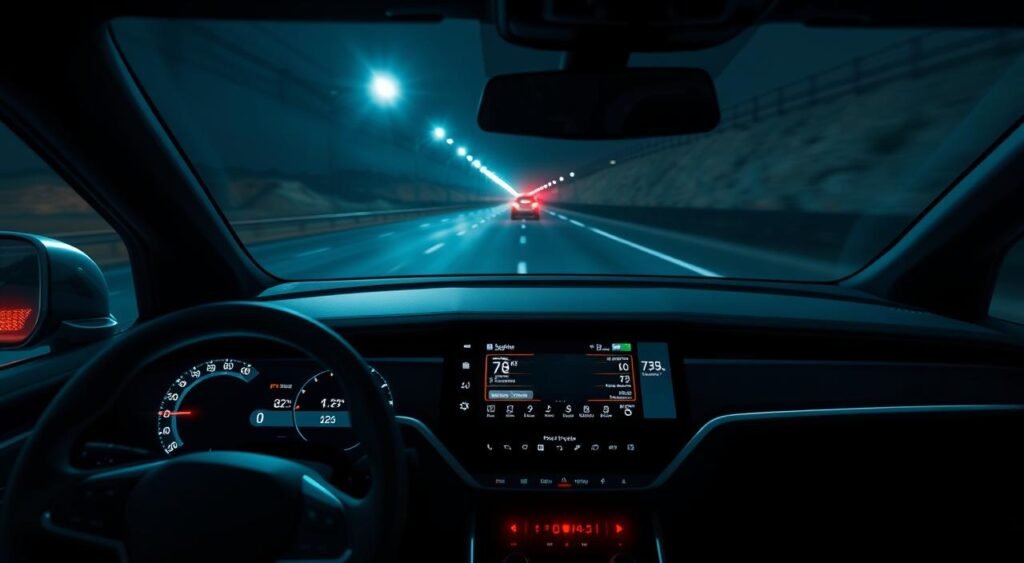
Efficient Battery Technology
Volvo offers two battery options for different needs. The 49 kWh LFP battery is sustainable. The larger 64-69 kWh NMC battery extends range even more.
Real-world tests show drivers can get 350-400 kilometers per charge. This makes long trips practical and stress-free.
All-Wheel Drive Capabilities
The EX30 has a low center of gravity for great balance and handling. Its chassis performs well on different roads. The suspension is well-damped, staying composed over rough surfaces.
The steering is quick and the stability is genuine. This makes the electric SUV performance stand out. Whether you choose rear-wheel or all-wheel drive, it’s impressive.
Advanced Safety Features
The Volvo EX30 Electric SUV review shows Volvo’s strong focus on safety. It has top-notch safety tech, just like bigger luxury cars. It even got a 5-star Euro NCAP crash test rating. This proves that even the smallest Volvo is safe.
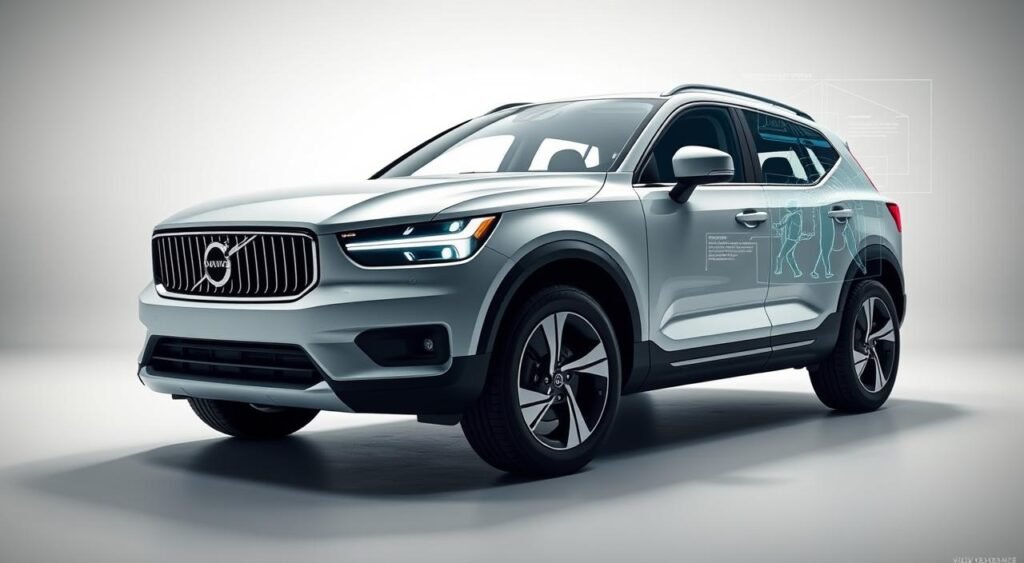
Innovative Driver Assistance Systems
The Volvo EX30 has advanced Pilot Assist and adaptive cruise control. These keep the car safe and steady. The 360-degree camera system helps with parking, and blind-spot monitoring warns of dangers.
Rigorous Safety Ratings
The EX30 also has Volvo’s unique airbag system. It includes airbags in the front seats and between them. This comprehensive airbag system is designed to protect in all kinds of crashes.
Emergency Braking and Collision Avoidance
The EX30 has automatic emergency braking. It stops the car fast if needed. The collision avoidance system also steers away from obstacles.
But, some Indian drivers might find the lane-keep assist and speed warnings too much. Volvo made it easier to adjust these settings with updates. But, the menu is a bit hard to use.
Cutting-Edge Technology Integration
The Volvo EX30 is packed with advanced tech. It has a digital cockpit that changes how you drive. The car has a 12.3-inch vertical touchscreen in the middle. It runs on Qualcomm Snapdragon with Android OS.
This system replaces old gauges and controls with a simple digital interface. It makes driving more intuitive.
Intuitive Infotainment System
The EX30’s tech center is its infotainment system. It’s based on Android and lets you download apps from the Google Play Store. This makes driving better with real-time navigation and music.
Seamless Smartphone Connectivity
iPhone users can connect wirelessly with Apple CarPlay. Android users can use wired Android Auto. The EX30 also has a top-notch Harman Kardon sound system.
It has nine speakers and pumps out 1,040 watts of sound. The soundbar design fills the car with sound.
Over-the-Air Software Updates
The EX30 gets software updates without a trip to the dealer. These updates make the car better and add new features. The system downloads and installs them automatically when it’s connected to Wi-Fi.
Comfort and Space for Every Journey
The Volvo EX30 Electric SUV review shows a well-thought-out interior. It mixes Scandinavian minimalism with useful features. This small electric car uses every bit of space, making it feel bigger than it is.
Spacious Interior Layout
The interior takes a minimalist approach, like Tesla, but keeps Volvo’s Scandinavian look. The front seats are comfy for both short and long drives. The center console and window switches show smart use of space.
Among the best electric SUVs of 2021, the EX30 shines with its smart design.
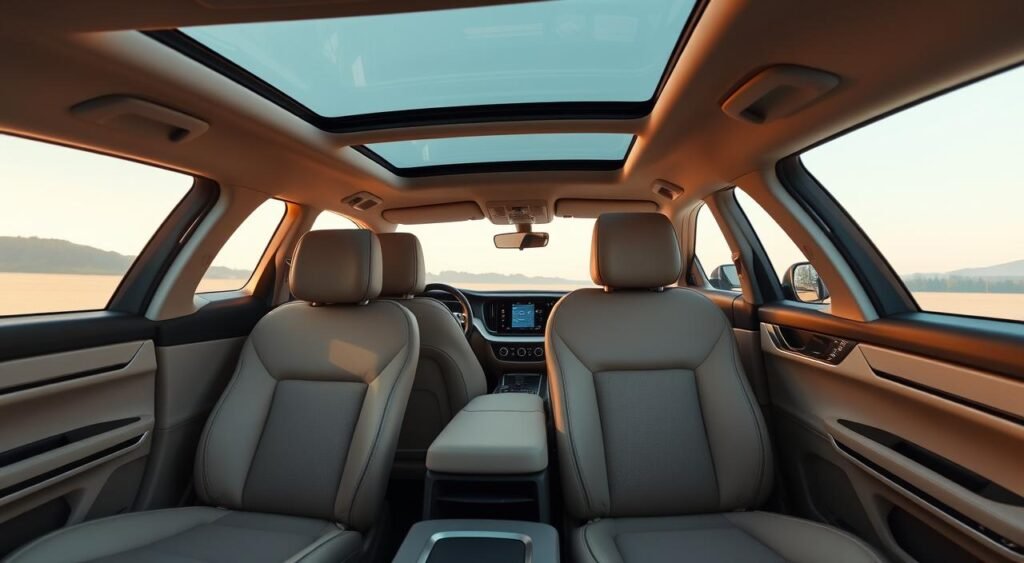
Premium Seating Options
The front seats are comfy, with soft fabrics and high-quality finishes. But, the rear seats are a bit tight, with cramped knees. There are no rear AC vents, which is a big issue in India’s hot climate.
Even with recycled materials, the interior feels luxurious, matching top brands.
Versatile Cargo Solutions
The EX30 is all about practical storage:
- 318-liter boot capacity with electric tailgate access
- 7-liter front trunk perfect for charging cable storage
- Removable tray system for rear passenger convenience
- Adjustable central storage compartments with retractable cupholders
- Enlarged door bins thanks to innovative soundbar placement
The Volvo EX30 Electric SUV review highlights its smart design. It offers surprising versatility in a small package. Each storage solution is designed with daily use in mind.
Sustainability Commitment of Volvo
Volvo leads in environmental efforts with the EX30. It sets high standards for electric SUVs. The company aims for clear goals and measurable results.
Carbon Neutral Manufacturing
Volvo’s factories in Belgium and China run on green energy. Most suppliers follow this green path. The EX30 has a low CO2 footprint of 18 tonnes when it leaves the factory.
For those driving 8,000 miles a year in India, the EX30’s CO2 output is just 0.4 tonnes. This is much less than the 1.8 tonnes from petrol cars.
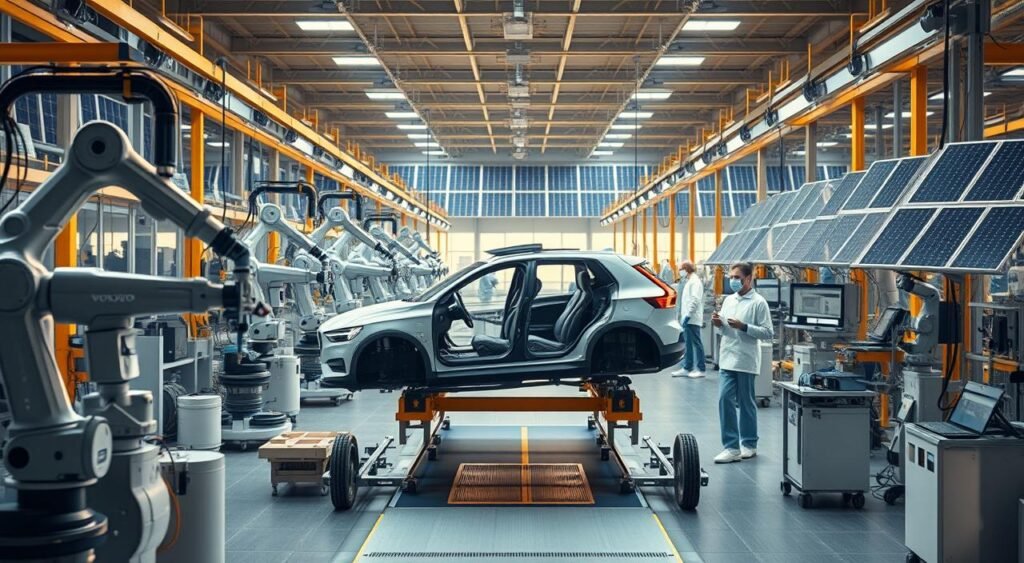
Recyclable and Sustainable Materials
The EX30’s interior uses eco-friendly materials. It includes recycled denim, fishing nets, and plastic bottles. The base model uses LFP batteries, which need less mining than traditional batteries.
| Material Type | Recycled Content Percentage | Source Materials |
|---|---|---|
| Plastic Components | 16.7% | Disposable bottles, fishing nets |
| Steel Elements | 16.7% | Industrial recycled steel |
| Aluminum Parts | 25% | Post-consumer aluminum |
| Interior Fabrics | 100% | Recycled denim, uPVC frames |
Ethical Sourcing Practices
Volvo avoids leather in all trim levels. This shows its dedication to ethical choices. The EX30’s CO2 emissions are about half of what traditional cars produce.
These features show that being green and luxurious can go hand in hand. It cuts costs and environmental harm while keeping Volvo’s high standards.
Exceptional Driving Range and Efficiency
The Volvo EX30 is a top electric SUV with impressive range. It comes in different battery sizes to fit various needs. You can pick from three options, each designed for Indian roads.
Competitive Mileage on a Single Charge
The EX30’s range varies by model. The base model goes 209 miles on a single charge. The Single Motor Extended Range goes up to 295 miles. The Twin Motor Performance edition offers 280 miles, balancing power and efficiency.
For Indian roads, it’s estimated to go about 350 kilometers. This makes it great for daily drives and weekend trips.
Fast Charging Capabilities
Charging the EX30 is easy with several options. It supports 11 kW AC charging at home and up to 153 kW DC fast charging at public stations. This fast charging means you can quickly top up your battery on long trips.
Eco-Driving Features
The EX30 has features to boost efficiency and performance. One-pedal driving mode is great for city driving, letting you control speed with just the accelerator. The energy recuperation system captures power when you slow down, saving range.
The car is very quiet, with little wind noise and silent motor operation. Adaptive cruise control on highways helps save battery, making the single-motor version with a bigger battery the most efficient.
Overall Value and Affordability
The Volvo EX30 Electric SUV offers great value in the compact luxury electric vehicle market. In India, it’s priced between Rs 35-40 lakh for locally made models. This makes it a strong competitor to the Mini Cooper SE.
In the UK, prices start at £31,560 for the Core trim with rear-wheel drive. The Plus trim costs between £33,660 and £44,360, depending on features. The Ultra trim tops out at £41,860 to £44,360.
Cost-Effective Ownership
The EX30 faces competition from the BMW iX1 and Hyundai Ioniq 5 at Rs 45-50 lakh. Other rivals include the VW ID.3, Cupra Born, Renault Megane E-Tech Electric, Kia EV3, and Hyundai Kona Electric. Despite its high price, the Volvo brand adds a lot of value.
The car comes with unique features like NFC keys and advanced safety systems. These justify its luxury segment position.
Available Incentives for Electric Vehicles
Buying an electric vehicle comes with government incentives and tax breaks. The Volvo EX30 Electric SUV review highlights its lower CO2 emissions. This leads to lower registration fees and tax benefits in many areas.
The combination of incentives and Volvo’s prestige makes the EX30 appealing to eco-conscious luxury buyers.
Long-Term Savings on Fuel and Maintenance
Electric cars save on fuel costs, as owners only pay for electricity. This is much cheaper than petrol or diesel. The EX30 also needs less maintenance than traditional cars.
There are no oil changes, fewer parts, and regenerative braking helps brake pads last longer. These factors lead to big savings over time. The Volvo EX30 is known for its long-term value.
FAQ
What are the Volvo EX30 specifications for the Indian market?
The Volvo EX30 has a rear motor that makes 272 PS (268 bhp) and 343 Nm torque. It goes from 0-100 kmph in 5.3 seconds. It’s 4.2 meters long and has a 318-liter boot.
It comes with 49 kWh and 64 kWh/69 kWh battery options for longer range.
How does the Volvo EX30 compare to other best electric SUVs 2021?
The EX30 faces off against the Mini Cooper SE, BMW iX1, and Hyundai Ioniq 5. It’s priced at Rs 35-40 lakh for CKD assembly in India. This makes it Volvo’s most affordable electric car.
It won the 2023 BBC Top Gear Eco Warrior of the Year award in the UK. This shows it’s a strong competitor.
What electric SUV features make the EX30 stand out?
The EX30 has a 12.3-inch vertical touchscreen with Android OS and native Google apps. It also has wireless Apple CarPlay. It has a 5-star Euro NCAP rating and many safety features.
It also has a Harman Kardon soundbar with nine speakers and 1,040 watts output for premium sound.
How is the electric SUV performance in real-world conditions?
In real-world driving, the EX30 gets 350-400 km range in India. WLTP ratings range from 209 miles to 295 miles. It charges at 11 kW AC and up to 153 kW DC fast.
Its performance is smooth and the ride quality is excellent, even on rough roads.
What sustainability features does the Volvo EX30 Electric SUV review highlight?
The EX30 uses recycled materials like plastic, steel, and aluminum. It also uses recycled denim, fishing nets, and plastic bottles. The CO2 footprint is low, with only 18 tonnes from the factory.
It’s about half the CO2 of petrol cars. No leather is used in any trim.
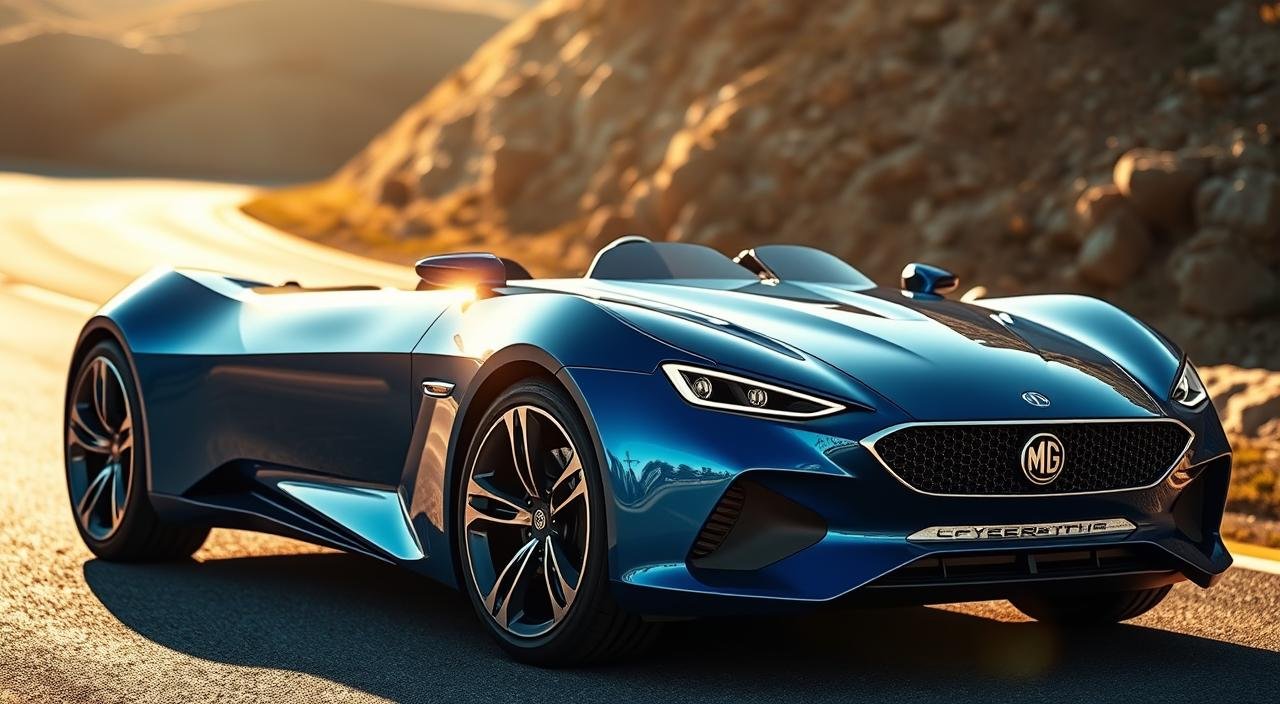
Aug
Can an electric vehicle roadster from MG challenge the design supremacy of traditional sports cars on Indian roads? The MG Cyberster Design is a big change for MG, known mainly for SUVs like the Hector. This electric roadster breaks new ground with its bold styling and futuristic look.
The Cyberster has scissor doors that open with just a button. Its low, wide stance makes it stand out and grab attention. Its roadster design is different from the usual designs in India’s electric car market.
This bold electric roadster shows what happens when car makers take risks with design. The MG Cyberster Design mixes eye-catching looks with smart engineering. It’s a car that looks as advanced as it is electric.
Key Takeaways
- MG Cyberster represents a dramatic departure from the brand’s traditional SUV focus
- Functional scissor doors open with a simple button push for theatrical entry
- Low, wide stance creates commanding road presence on Indian streets
- Sweeping roadster profile challenges conservative EV aesthetics in the market
- Design combines striking visual elements with practical engineering solutions
- Every curve serves both aesthetic appeal and functional purpose
Introduction to MG Cyberster Design
The MG Cyberster is a big step for MG in the electric car world. It’s a roadster that looks amazing and works well. Its design shows MG’s goal to change what electric sports cars can be today.
Overview of the MG Cyberster
The Cyberster has scissor doors that open up, not out. These doors have sensors to avoid hitting things. It’s a two-seater with a low profile and wide stance, just like a classic roadster.
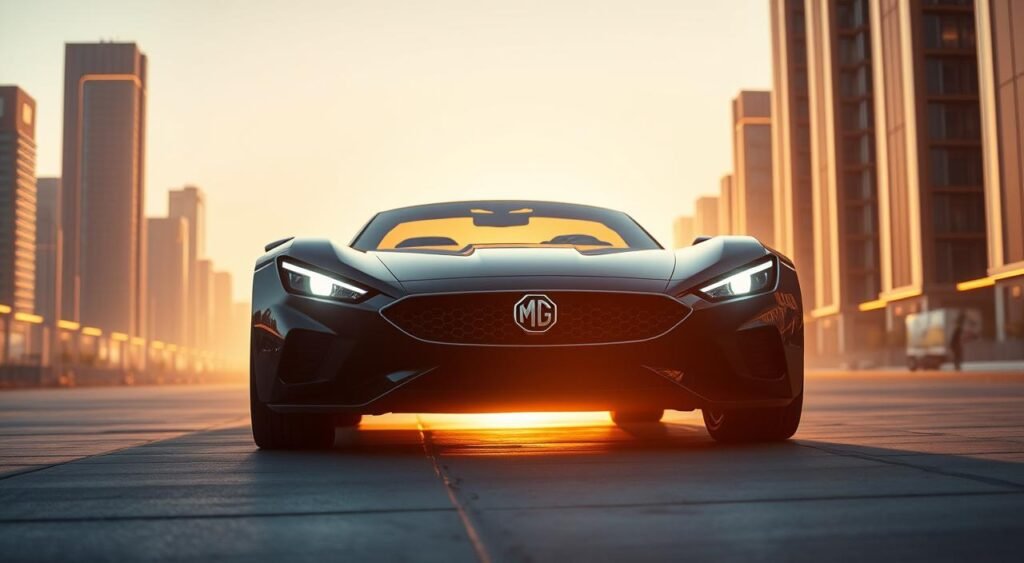
| Dimension | Measurement | Design Impact |
|---|---|---|
| Length | 4,535 mm | Compact for agility |
| Width | 1,913 mm | Wide track for stability |
| Height | 1,329 mm | Low center of gravity |
| Wheelbase | 2,690 mm | Extended for smooth ride |
Significance of Design in Electric Vehicles
Electric cars need new designs because they don’t have engines. The Cyberster’s design cuts through air and looks cool. It shows how EVs can be both beautiful and efficient.
Bold Front-End Aesthetics
The MG Cyberster stands out as a trendsetter in the automotive world. Its striking front-end design grabs attention. It perfectly blends elegance with performance, setting new standards for EV looks.
Signature Headlights and Grille Design
The Cyberster’s LED headlamps make a bold statement. They are nestled in unique petal-shaped daytime running lights. The wide grille and sharp bonnet lines add to the car’s bold look.
This design keeps things simple yet stylish. It shows off the sleek look that modern electric cars are known for.
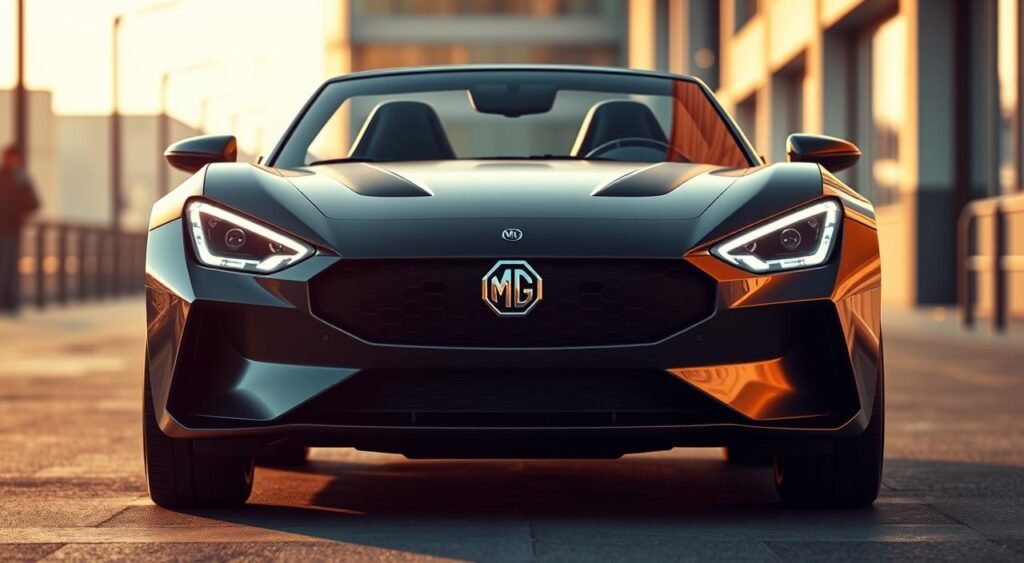
Aerodynamic Lines and Sculpted Bodywork
Every part of the Cyberster is designed with purpose. The long bonnet meets a short rear deck, giving it classic roadster looks. This car is a trendsetter because of its:
- Clean sculpting that maintains balanced proportions
- Smooth transitions between body panels
- Wind-optimized surfaces for improved efficiency
- A low-slung profile that enhances the sporty character
The bodywork is a blend of beauty and function. It guides air smoothly and keeps the Cyberster looking sleek. This design makes the MG Cyberster a leader in electric roadster styling.
Modern Interior Features
The MG Cyberster’s interior is a mix of the latest tech and top-notch craftsmanship. Every part shows a focus on quality, from solid doors to perfectly aligned panels. The interior design is as stunning as the outside, making every drive special.
Dashboard Design and Technology Integration
The dashboard is designed for the driver, with clear digital displays. A curved cluster shows important info, and the central screen handles entertainment and settings. It also has voice controls and connects to smartphones, making it easy to use.
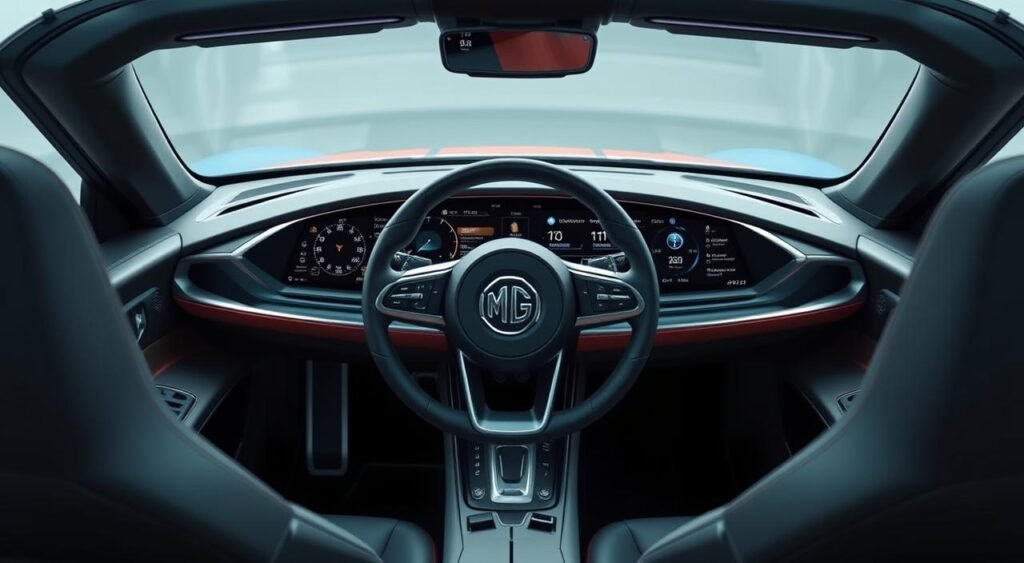
- Triple-screen setup with customizable displays
- Wireless Apple CarPlay and Android Auto
- Ambient lighting with multiple color options
- Digital climate control system
Material Choices for a Premium Feel
MG picked materials that are both luxurious and strong. The dashboard and doors have soft-touch surfaces, while metal adds a nice look. The seats are covered in quality leather with contrasting stitching that matches the car’s color.
| Interior Component | Material Used | Premium Feature |
|---|---|---|
| Dashboard | Soft-touch polymer | Anti-glare coating |
| Seats | Nappa leather | Heated and ventilated |
| Steering wheel | Perforated leather | Paddle shifters |
| Door panels | Alcantara inserts | Illuminated trim |
The cabin’s quality is top-notch, with precise panel gaps and smooth components. This tech integration makes the interior feel both modern and welcoming for daily use.
Color Palette and Customization Options
The MG Cyberster Design offers bold color choices. These options make the roadster stand out. Each color is picked to match the car’s sleek lines and modern look.
Available Colors and Their Impact
The MG Cyberster has two standout colors:
- Flare Red – A bright, eye-catching shade that highlights the car’s sporty vibe
- Nuclear Yellow – A bold color that matches the EV style of this modern sports car
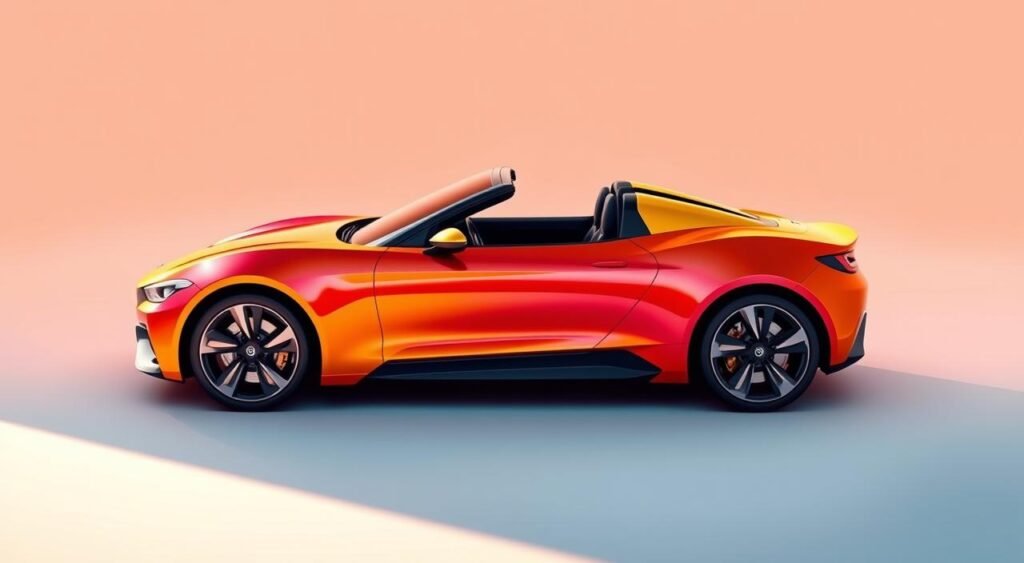
There are also more subtle colors. These might appeal to those who prefer a quieter look. But, they might not show off the MG Cyberster’s design as much.
Personalization Features for Owners
Customization goes beyond just colors. Owners can choose from different trim packages and accents. This lets them make a car that shows off their style while keeping the Cyberster’s EV look.
The mix of bold colors and subtle accents lets each owner make their unique roadster.
Innovative Lighting Technology
The MG Cyberster changes nighttime driving with its advanced lighting system. It shows how lights can look good and work well, setting new standards for EVs.
LED Lighting and Its Benefits
The Cyberster’s LED light bar makes a bold statement at the back. It makes the car look wider and lights it up better. The arrow-shaped tail lamps add a unique touch, like concept cars.
- They use less energy, saving on range.
- They last longer than old bulbs.
- They light up fast, without waiting.
- They shine light exactly where it’s needed, for safety.
Daytime Running Lights and Signature Design
The Cyberster’s petal-shaped DRLs are a design leap. They make the car’s front look unique and bright. This shape is clear in the day and makes the car stand out.
MG shows it can make EVs that are both safe and stylish. The lights fit perfectly with the car’s design, showing safety doesn’t have to mean sacrificing looks.
Performance-Driven Design Elements
The MG Cyberster is a true trendsetter in the automotive world. It perfectly combines style with performance. The soft-top fabric roof is a great example of this, opening in just 10 seconds. It keeps the car’s look sleek when closed.
Drivers can open the roof at speeds up to 50 kmph. This makes it easy to change the weather without stopping.
Weight Distribution and Handling
The Cyberster’s design focuses on balance. The battery pack is placed low in the car. This makes the car’s center of gravity as good as traditional sports cars.
The 20-inch alloy wheels are a big part of the car’s look. They also help the car grip the road well. This makes the Cyberster handle like a dream.
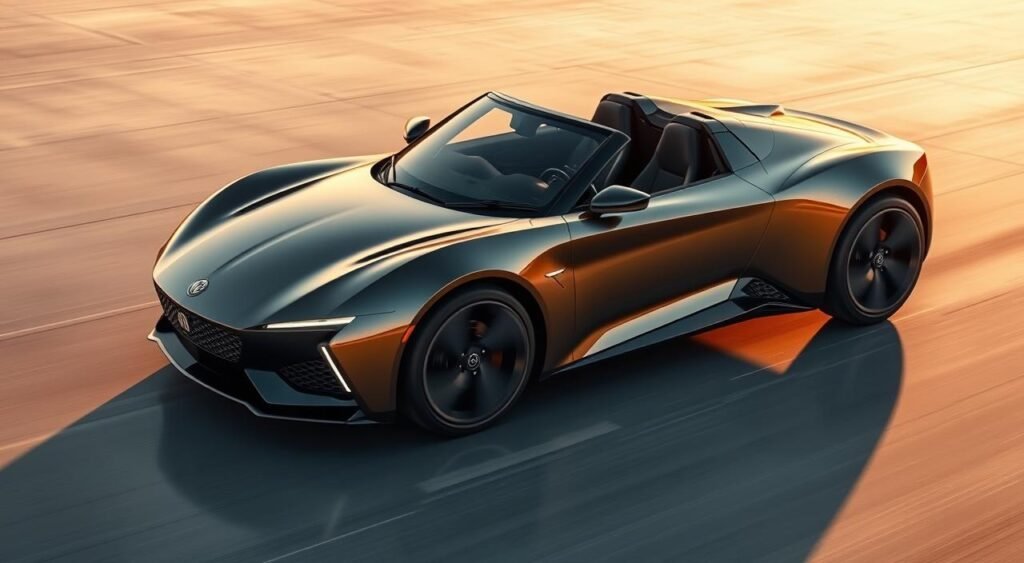
Impact of Design on Efficiency
The Cyberster’s design is key to its long range. Its body is shaped to cut through the air with ease. Every curve and crease has an aerodynamic purpose.
The front splitter and rear diffuser help a lot. The car’s doors and mirrors are designed to reduce wind resistance. The active grille shutters also help by adjusting airflow. These features help the Cyberster go further without losing its cool looks.
Conclusion: The Allure of the MG Cyberster
The MG Cyberster is a big leap in electric roadster design. It mixes classic sports car looks with the latest in electric tech. Its sleek design grabs attention from all sides, thanks to modern tech that boosts both performance and ease of use.
This car stands out in a world filled with sedans and SUVs. It brings a fresh, exciting vibe to the road.
Recap of Key Design Elements
The Cyberster shows MG’s big plans for electric cars. Its scissor doors add a cool touch, making getting in and out a show. The soft-top roof lets you drive with the wind in your hair, keeping the car’s sleek look.
Its lines and shapes flow smoothly, making it a feast for the eyes. The LED lights add to its look, shining bright at night in cities like Mumbai or Delhi.
The Future of Roadster Design in EVs
The Cyberster hints at a bright future for electric roadsters in India. It shows EVs can be thrilling and emotional, not just about saving fuel. As batteries get better and charging spots grow, more cars like this will hit the roads.
The Cyberster’s mix of new tech and stunning design sets a new standard. It proves electric cars can be just as fun to drive as their gas-guzzling cousins.
FAQ
What are the most distinctive design features of the MG Cyberster?
The MG Cyberster has scissor doors that open with a button press. It also has narrow LED headlamps and a full-width LED light bar at the back. The car has a classic roadster look with a low stance and wide wheels.
How does the MG Cyberster’s exterior design compare to traditional EV aesthetics?
Unlike many EVs, the Cyberster has bold styling. It has dramatic scissor doors and a sweeping profile. Its long bonnet, short rear deck, and 20-inch alloys give it a bold stance.
What color options are available for the MG Cyberster?
The Cyberster comes in Flare Red and Nuclear Yellow for a bold look. But, it also has more subtle colors for those who prefer less flash.
How practical are the scissor doors for everyday use?
The Cyberster’s scissor doors are practical for daily driving. They have sensors to avoid hitting objects and close with a solid sound. This shows the car’s premium quality.
What cutting-edge technology is integrated into the Cyberster’s lighting system?
The Cyberster has LED headlamps with unique DRLs. Its rear light bar and arrow-shaped tail lamps give it a futuristic look.
How does the retractable soft-top affect the vehicle’s design and functionality?
The soft-top operates quietly and can be changed at speeds up to 50 kmph. It retracts neatly, keeping the car’s lines clean.
Is the MG Cyberster positioned as an automotive trendsetter in India’s EV market?
Yes, the Cyberster is MG’s bold move into the EV market. It combines futuristic design with innovation, making it a leader in India’s EV scene.
How does the interior design complement the bold exterior aesthetics?
The interior focuses on tech and premium materials. It has well-designed panels and solid doors. This creates a space that matches the car’s striking look.
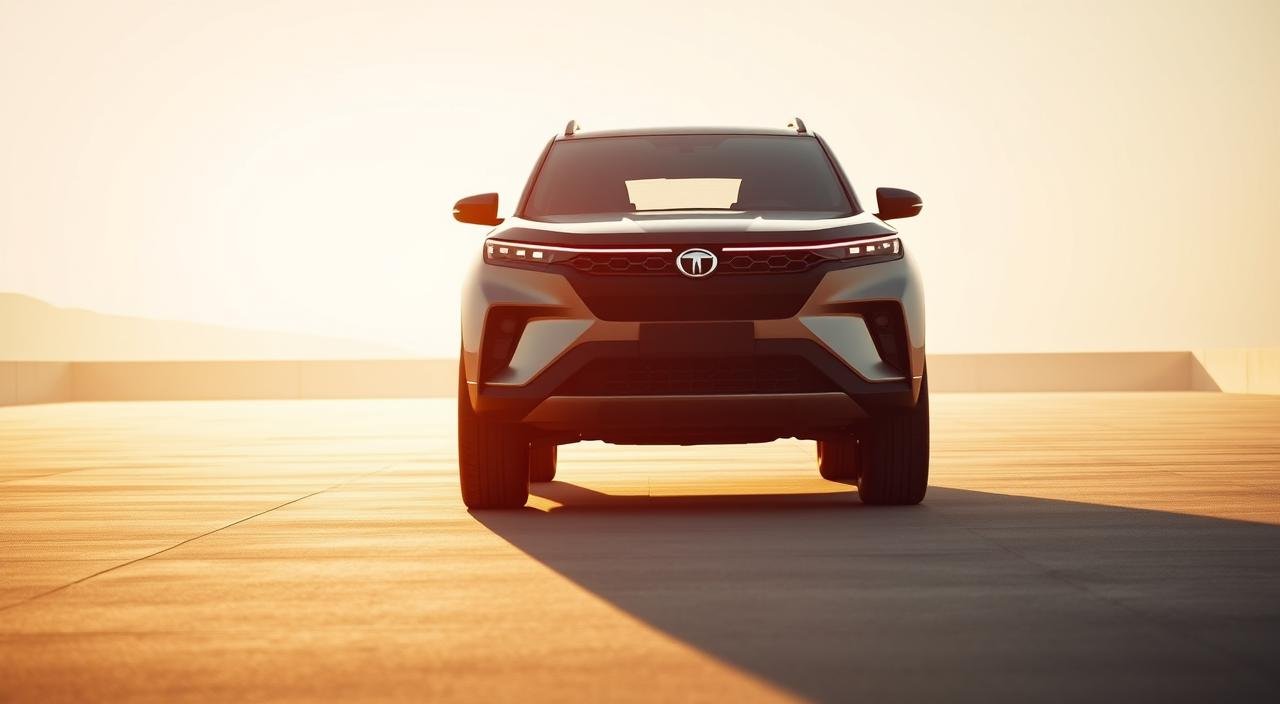
Aug
Is the Tata Harrier EV ready to change India’s electric vehicle scene? Or does it miss the mark? Tata Motors is getting ready to make its popular Harrier electric. The diesel Harrier already impresses with its 2-liter engine, giving 170 PS power and 350 Nm torque.
The Harrier is a standout in the SUV market with its big size. It’s 4,605mm long and has a 2,741mm wheelbase. Starting at Rs 18.99 lakh, it beats rivals like the Hyundai Creta in size and presence. As charging gets better and battery tech improves, the Tata Harrier EV is set to fill a big gap in India’s electric SUV market.
This analysis looks at four key upgrades for the Tata Harrier EV. These changes could make it a top choice in the electric SUV market. Each improvement tackles real concerns for Indian buyers looking for their next electric SUV.
Key Takeaways
- The Tata Harrier EV builds on a proven platform with impressive dimensions exceeding competitors
- Current diesel variants showcase strong performance with 170 PS power and 350 Nm torque
- India’s evolving EV infrastructure creates opportunities for premium electric SUVs
- Four specific improvements could elevate the Harrier EV to segment leadership
- The electric version addresses gaps in India’s premium EV market
- Competitive pricing starting at Rs 18.99 lakh positions it well against rivals
Introduction to Tata Harrier EV
The car world in India is changing fast, with electric vehicles becoming more popular. Tata Motors is ready to make its Harrier SUV electric. This review looks at why the Harrier EV is a big deal in the EV market in India.
Overview of the Tata Harrier EV
The Tata Harrier EV is a big step for the brand in the electric SUV market. It uses the same platform as the diesel Harrier but is electric. It’s for people who want a car that’s good for the planet and doesn’t lose out on comfort or space.
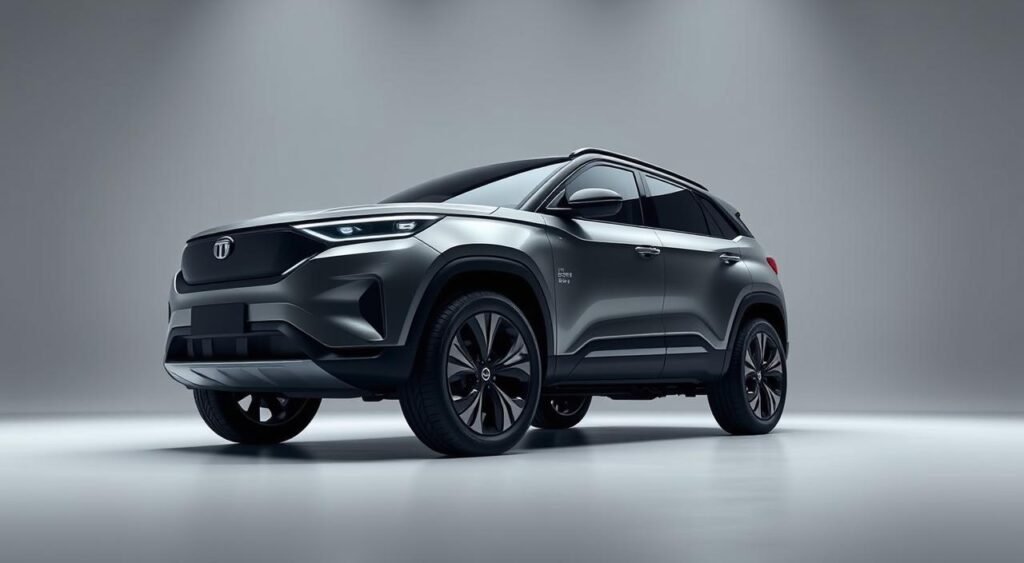
Key Features and Specifications
The Harrier EV has some amazing features:
- Auto-LED bi-projector headlights for better visibility
- Dual 10.25-inch displays for entertainment and info
- Level-2 ADAS for safer driving
- Range of 400-500km, meeting current needs
- Advanced battery system for better efficiency
Market Positioning in India
The Harrier EV is priced between Rs 18.99-20.69 lakh. It’s in a competitive market where people want good value and new ideas. The EV market in India has grown a lot, with better charging and higher range expectations. The Harrier EV meets these needs for city and highway driving.
Design and Aesthetics
The Tata Harrier EV has a bold design that mixes modern looks with SUV toughness. Its exterior styling makes it stand out on the road. The inside is all about comfort and luxury. Let’s see what makes this electric SUV special and how it could get even better.
Exterior Design Elements
The Harrier EV’s exterior is eye-catching, with blacked-out ORVMs and LED turn indicators. Its 17-inch alloy wheels are strong, and the LED taillights add a modern touch. For those who love adventure, there are roof rails for extra practicality.
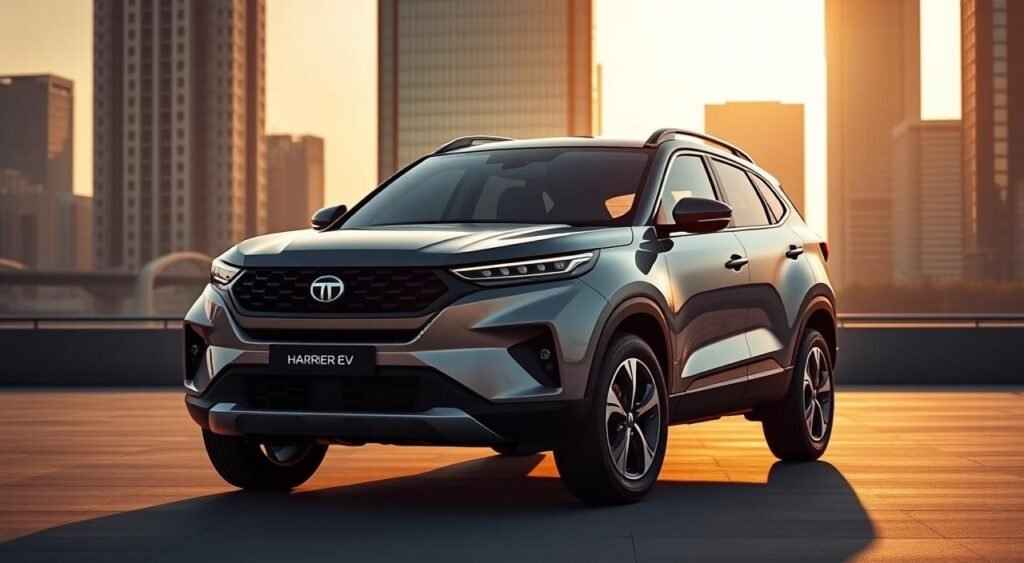
The design focuses on clean lines and being aerodynamic. The front has a closed-off grille, typical of EVs, with sharp LED headlamps. Side cladding adds protection and visual appeal to the profile.
Interior Comfort and Features
Inside, the Harrier EV impresses with black leatherette seats and tan accents. The 4-spoke steering wheel has an illuminated Tata logo, adding a touch of luxury. The two-tone cabin theme makes it welcoming.
- 6-way power-adjustable driver seat
- Spacious legroom surpassing compact SUVs
- Premium leatherette upholstery
- Illuminated brand elements
Color Options and Customization
The Harrier EV comes in several monotone colors to match different tastes. While the colors are good, more customization options could attract more buyers. Competitors like Hyundai Creta offer dual-tone alloy wheels and dynamic turn indicators, showing what’s possible for personalization.
Performance and Driving Experience
The Tata Harrier EV is a big step forward in electric cars. As cars move to electric power, it’s key to know how they drive. The Harrier EV mixes power with efficiency, making it a top choice for electric driving.
Battery Efficiency and Range
Battery tech is key for car performance. The Harrier EV’s battery is top-notch in its class. Electric cars usually get 5-10 km/kWh, depending on the battery and car setup.
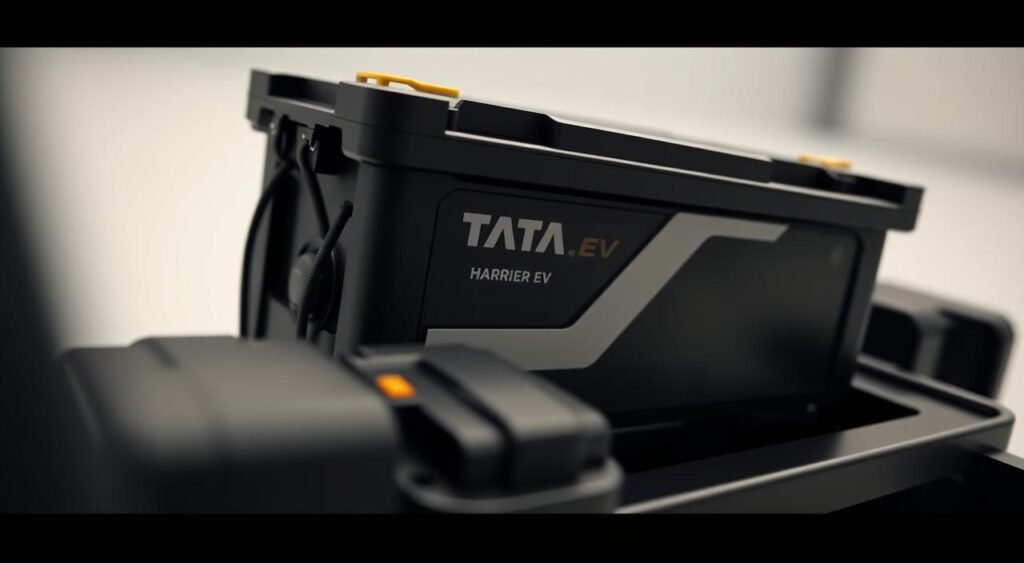
The car’s range changes with how you drive and the battery size. Cars with NMC batteries are often lighter and more efficient. Keeping the battery cool is also important for its performance, no matter the weather.
Handling and Ride Quality
The Harrier EV handles well, perfect for Indian roads. It’s comfy and stable, even when turning. You can adjust how much the car uses regenerative braking to fit your driving style.
How the car is weighted affects how it handles. Cars with the engine in the front are usually easier to handle. Special tires and wheels make the ride smoother and more efficient.
Comparisons with Other EVs
Here’s how the Harrier EV stacks up against other electric cars:
| Model | 0-100 kmph | Battery Type | Efficiency |
|---|---|---|---|
| Hyundai Creta EV | 7.5 seconds | 52kWh NMC | 8-10 km/kWh |
| Mahindra BE6 | 7.0 seconds | 79kWh LFP | 5-7 km/kWh |
These numbers show different ways electric cars are made. Efficiency analysis shows that lighter batteries use less energy, even if they’re smaller.
Technology and Features
The Tata Harrier EV is packed with modern tech to compete with other electric cars in India. It has both useful features and advanced safety systems. Yet, some areas could be better to keep up with the leaders.
Infotainment System and Connectivity
The Harrier Adventure X has wireless Apple CarPlay and Android Auto, along with a 6-speaker sound system. This setup is good for everyday music. It also has front 45W Type-C charging ports and an illuminated glovebox for easy access.
But, some rivals have better audio tech. The Hyundai Creta has an 8-speaker Bose system. The Mahindra BE6 even has a Harman Kardon Dolby Atmos setup, rivaling premium Burmester systems. These systems offer a better listening experience than the Harrier’s.
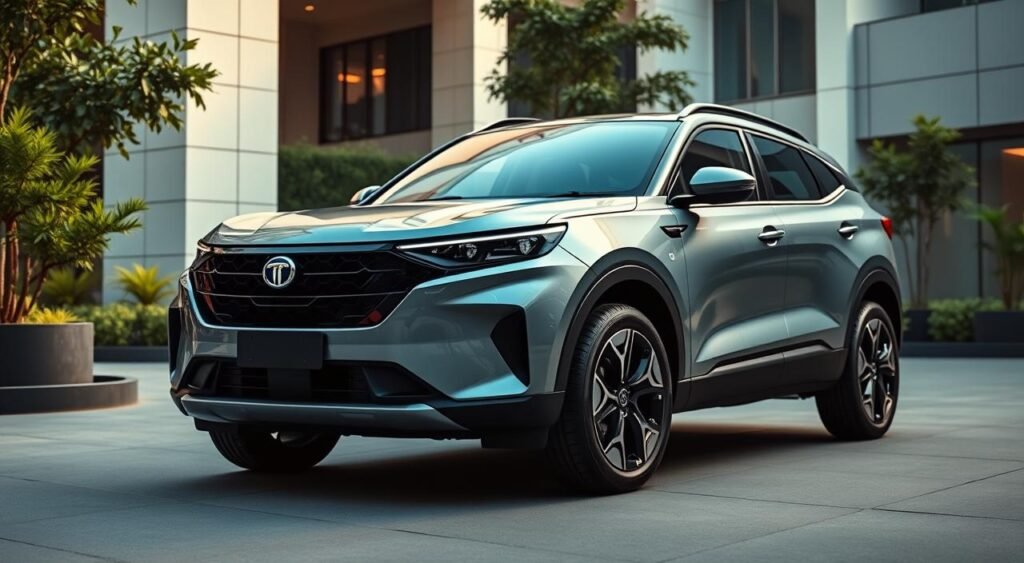
Autonomous Driving Capabilities
The Harrier EV has Level-2 ADAS for highway driving help. It includes:
- Adaptive cruise control for safe distances
- Lane keeping assist for stability
- 360-degree camera system for better visibility
- Rain-sensing wipers for weather adaptability
Some rivals have more features like autopark and blind spot monitoring with cameras. These are chances for the Harrier to improve in the future.
Safety Features and Ratings
The Harrier EV focuses on keeping passengers safe with many safety systems. It comes with 6 airbags, ISOFIX child seat mounts, and electronic stability control. The 360-degree camera system also helps with parking and tight spaces.
| Safety Feature | Tata Harrier EV | Segment Standard |
|---|---|---|
| Airbags | 6 | 6-7 |
| ADAS Level | Level 2 | Level 2 |
| 360° Camera | Yes | Yes |
| Blind Spot Monitoring | No | Available in some |
| HUD Display | No | Available in premium variants |
The Harrier’s safety meets industry standards but could be more unique. Adding features like heads-up display (HUD) and better blind spot monitoring would make it stand out more in the EV market.
Conclusion: The Path Forward for Tata Harrier EV
The Tata Harrier EV is at a turning point. The Indian electric SUV market is growing fast, with cars like MG ZS EV and Hyundai Kona Electric leading the way. To succeed, the Harrier EV must offer great value at a competitive price. It has a strong base thanks to Tata’s reputation and roomy design, but it needs to do better to win over customers.
Addressing the Shortcomings
The Harrier EV has some key areas to work on. It needs to get better mileage than 8 km/kWh to keep up with the competition. Improving the battery management system is a top priority. Tata Motors also needs to grow its EV service network in big cities.
The car’s throttle needs to be smoother, matching the quick power of electric cars. This is what buyers want.
Future Updates and Improvements
Upcoming updates will add features like ventilated seats and climate control. Wireless charging will also be added. The goal is to make the Harrier EV fast, accelerating from 0-100 kmph in under 8 seconds.
Long-distance travel is a big deal, so a range of 400+ kilometers is essential. Adding advanced safety features will make the car more appealing to tech lovers.
Final Thoughts on Market Position
The Harrier EV has a real chance to shake up the Indian electric SUV market. It has a lot going for it, like a solid feature list and a reliable platform. But, it must fix its current issues and keep its price competitive.
India’s growing EV infrastructure is a big plus for new players. With the right updates and a smart marketing strategy, the Harrier EV could become a top choice in this fast-growing field.
FAQ
When will the Tata Harrier EV launch in India?
Tata Motors hasn’t set a launch date for the Harrier EV yet. But, they’ve shown they can do it with the current Harrier. The diesel versions have cool features that could work well in an electric car as India’s EV setup gets better.
What is the expected price range for the Tata Harrier EV?
The Harrier diesel costs between Rs 18.99-20.69 lakh. EVs in the same class cost between Rs 17.99-25.72 lakh. So, the Harrier EV should be priced to compete with the Hyundai Creta EV and Mahindra BE6.
What range can we expect from the Harrier EV?
People want EVs to go 400-500km in real life. The Harrier EV should aim for 8-10 km/kWh efficiency. It might need a 50-60kWh battery pack to keep up.
How does the Harrier’s size compare to other electric SUVs?
The Harrier is bigger than the Hyundai Creta, with a length of 4,605mm and a wheelbase of 2,741mm. It has more room inside, making it a strong contender in the electric SUV market.
What advanced features does the current Harrier offer that could transfer to the EV version?
The Harrier has Level-2 ADAS, a big touchscreen, and a digital display. It also has a 360-degree camera and wireless CarPlay/Android Auto. The EV version might get even more tech, like better regenerative braking.
What improvements would the Harrier EV need to compete effectively?
To beat the competition, the Harrier EV should have ventilated seats and dual-zone climate control. It should also accelerate fast and be very efficient. Plus, it needs better battery management and smooth braking.
How does Tata’s service network compare for EV support?
Tata Motors has a big service network in India. But, they need to make sure their EV service is top-notch. They should train their techs well and have good charging support at service centers.

Jul
Imagine a family car that has luxury, goes electric, or is easy on your wallet. It’s all possible with the new MPVs coming out this month.
The Indian car market is set for a big change. Three new MPVs are ready to hit the roads. The MG M9 offers top-notch luxury, the Kia Carens EV leads in electric cars, and the Renault Triber is all about being affordable.
These three MPVs show different ways to meet family needs. The MG M9 is for those who want the best in comfort and tech. The Kia Carens EV is perfect for families who care about the planet. The Renault Triber is great for those who want lots of space without spending a lot.
These cars were made to fill gaps in the market. They come at a time when more families want versatile cars. This shows a shift in what Indian families look for in their vehicles.
Key Takeaways
- Three new MPVs launching this month cater to luxury, electric, and budget segments
- MG M9 targets premium buyers with advanced features and spacious interiors
- Kia Carens EV becomes the first electric MPV option in its segment
- Renault Triber receives significant updates while maintaining affordability
- Each model addresses different family transportation needs and budgets
- Growing MPV demand reflects changing Indian family mobility preferences
Introducing the Next Generation of MPVs
The Indian car market is changing fast. Families want practical and spacious vehicles. New MPVs meet these needs with innovative designs for all budgets.
Recent MPV releases show a big change in design. Now, there are models for every budget, from affordable to luxury ones up to Rs 70 lakh. This means every family can find a car that fits their needs and budget.

Why MPVs Are Gaining Popularity
Indian families are choosing MPVs over sedans and SUVs. This is because of lifestyle changes and bigger families. New MPVs have more space, flexible seats, and better fuel efficiency.
City traffic and big families make MPVs a great choice. They now come with more comfort features. This makes long trips better for everyone. Better suspension and soundproofing make them cozy family cars.
Key Features MPV Buyers Look For
Today, MPV buyers look for certain things in new models:
- Flexible seating configurations with easy-fold mechanisms
- Advanced safety systems including multiple airbags and stability control
- Generous cargo space even with all seats occupied
- Fuel-efficient engines balancing power and economy
- Modern infotainment systems with rear-seat entertainment options
Latest updates show MPVs getting premium features. Now, they have climate control, wireless charging, and car connectivity. These features were once only for luxury sedans.
MG M9: A Game-Changer in the MPV Market
The car world is excited about the MG M9, MG’s new electric luxury vehicle. It’s a big deal in the MPV market, aiming to change how we think about family cars. This electric MPV combines luxury, lots of space, and top-notch electric performance.
Overview of the MG M9
The MG M9 is a big step forward in electric MPV tech. It’s 5.3 meters long, bigger than the Toyota Vellfire and Kia Carnival. It has two big ottoman seats for ultimate comfort and a third row that’s practical and spacious. It’s priced around Rs 70 lakh, making it a top-tier option.

Design and Aesthetics
The MG M9 has a unique design that might spark debate. Its quirky styling makes it stand out from other MPVs. The inside is all about comfort, with high-end materials and smart design. Big windows and a roomy interior add to the luxury feel.
Performance and Engine Specs
The MG M9 has impressive electric power:
- Front-mounted electric motor delivering 245 PS power
- Peak torque output of 350 Nm
- 90 kWh battery pack
- WLTP-certified range of 430 km
These specs make the MG M9 great for long trips, easing worries about running out of charge.
Kia Carens EV: Eco-Friendly and Spacious
The car world is changing fast, with electric vehicles leading the way. The Kia Carens EV is set to change the MPV game. It’s all about being green and practical for families. It’s a top pick for families who care about the planet.
What to Expect from the Carens EV
The Kia Carens EV hits the market on July 15, 2025. It’s India’s first electric MPV with room for three rows of seats. It’s perfect for big families who want to be kind to the environment.
This seven-seater has a big 51.4 kWh battery. It goes up to 490 km on a single charge. That’s a lot of driving without needing to stop for fuel.

For those on a tighter budget, there’s a 42 kWh battery option. It offers 390-400 km of range. The car moves smoothly, thanks to its front-wheel-drive and 135-170 PS power.
Innovative Technology and Features
The Carens EV is packed with the latest tech. Inside, you’ll find dual 12.3-inch screens for a futuristic feel. It has:
- Panoramic sunroof for an airy cabin feel
- Wireless charging capabilities
- Ventilated powered driver seat
- Dual-zone climate control
- 360-degree camera system
- Level-2 ADAS safety features
- Six airbags as standard equipment
Sustainability: A Focus on Eco-Friendliness
The Kia Carens EV is all about going green. It’s electric, so it doesn’t pollute. And it’s priced at Rs 18 lakh ex-showroom, making it affordable for many families.
This price makes it a standout in the Indian market. It’s a big step forward for electric cars in India.
Renault Triber: Versatility Meets Affordability
The Renault Triber is a standout in the MPV market. It offers practical family transport at a low cost. This makes it a hit with families in India who want good value without spending too much.
The 2025 facelift of the Renault Triber is set to bring big changes. It will launch on July 23, 2025. This is the first big update for the model.
Key Highlights of the Renault Triber
The 2025 Renault Triber facelift has many exciting updates. It gets new LED headlights and tail lights for better visibility and style. The alloy wheels and grille have also been updated for a fresh look.

Inside, the Triber now has a large digital display instead of traditional gauges. It also gets automatic climate control for better comfort. Music fans will enjoy the extra speakers for a better sound during trips.
Spacious Interior and Configurations
The Triber’s flexible seating is a big plus. It can be set up in five, six, or seven-seat layouts. This makes it perfect for different family needs. The third row can even be removed for more space.
Safety and Reliability Features
Safety is a top priority in the updated Renault Triber. It now comes with six airbags as standard. This is a big plus for families in India who want to stay safe.
The Triber keeps its reliable 1-liter petrol engine. There might also be a turbocharged engine from the Kiger. This engine mix offers good fuel efficiency and power for driving in the city and on highways.
Comparing the Three MPVs: A Quick Overview
The car market offers three unique MPV options. Each caters to different needs and budgets. This makes comparing them key for making smart choices. Today’s market has everything from affordable to luxury electric vehicles.
Side-by-Side Feature Comparison
Looking at these three MPVs, we see big differences. The Renault Triber is great for families on a budget, with useful features. The Kia Carens EV has a long range and seats seven, perfect for those who care about the environment. The MG M9 offers top comfort with ottoman-style seating and a long electric range.

| Model | Seating | Power Type | Range | Key Feature |
|---|---|---|---|---|
| Renault Triber | 7 seats | Petrol | Standard | Modular seating |
| Kia Carens EV | 7 seats | Electric | 490 km | Advanced tech |
| MG M9 | 7 seats | Electric | 430 km | Ottoman seats |
Price Points and Value for Money
The prices of these models match their target markets well. The Triber is affordable for those new to MPVs. The Carens EV costs Rs 18 lakh, making it a high-end electric choice. The M9, at Rs 70 lakh, offers luxury and comfort, making it worth the price.
Target Audience for Each MPV
Every MPV meets different needs and tastes. Knowing who each car is for helps buyers choose wisely. The MG M9, Kia Carens EV, and Renault Triber each attract different groups with their own wants and budgets.
Who Will Love the MG M9?
The MG M9 is for those who love luxury. They want ultimate comfort and top-notch features. Business leaders, wealthy families, and chauffeur services love it for its roomy interior and tech.
The Ideal Customer for Kia Carens EV
The Kia Carens EV is perfect for green families and businesses. Fleet managers and airport services like its electric power and room. It’s a great choice for those looking at EVs like the Tata Curvv EV and Hyundai Creta Electric.
Renault Triber’s Target Demographic
The Renault Triber is for families on a budget. It’s great for first-time buyers, young families, and small businesses. It offers key features at a low cost, making it perfect for reliable family cars.
| MPV Model | Primary Buyers | Budget Range | Key Priority |
|---|---|---|---|
| MG M9 | Luxury seekers, executives | Premium | Comfort & features |
| Kia Carens EV | Eco-conscious families, fleets | Upper-mid | Sustainability |
| Renault Triber | Budget families, first buyers | Entry-level | Affordability |
Market Trends Influencing MPV Designs
The Indian MPV market is changing fast. Car makers are now making vehicles that are both practical and feature-rich. This change is driven by the need for space, comfort, and modern tech in cars.
Rising Family Needs and Preferences
Indian families want cars that are roomy and can seat many people. They prefer cars that can hold seven or eight people. Safety and fuel efficiency are just as important as they are looking for cars with advanced driver assistance systems.
Now, cars need to connect to our digital lives. Touchscreens, phone integration, and USB ports are must-haves. Cars must support our tech needs while keeping everyone comfortable on long trips.
The Shift Towards Electric and Hybrid Models
More people in India are choosing electric cars. Kia is leading the way with their electric seven-seater. Better battery tech means these cars can go far, even on long drives.
Government help and more charging spots are making electric cars more appealing. By 2024-2025, many cars will be hybrid or fully electric. This makes eco-friendly cars more affordable for everyone.
Anticipated Release Dates and Availability
The MPV news circuit is buzzing with excitement. Car manufacturers are getting ready to unveil their latest offerings. July 2025 is a big month for the MPV segment, with many launches set to change the market.
These new MPV models will bring enhanced features, better performance, and improved value for Indian families.
When Can You Expect to See These Models?
The Kia Carens EV will be the first to hit the market, on July 15, 2025. It shows Kia’s dedication to green family transport. The Renault Triber facelift will arrive on July 23, 2025, with new looks and features.
The MG M9 is a bit of a mystery, but insiders say it will debut around the same time. The arrival of these three models will give buyers a chance to compare and choose.
Pre-Order and Reservation Details
Bookings for the Kia Carens EV will start soon after its reveal. Pricing will be announced then. Customers should get their documents ready, as electric MPVs are in high demand.
Renault dealers in India are already taking inquiries for the Triber facelift. Official bookings will start a week before its launch.
These new MPV models will be available at authorized dealerships across the country. Test drives will start right after their launch.
Conclusion: Which MPV Will Make the Cut?
The Indian MPV market is at a thrilling point with these three unique options. Each car shows a different way to move families around. The latest updates show makers are listening to what people want, from daily use to luxury electric rides.
Final Thoughts on MG M9, Kia Carens EV, and Renault Triber
The Renault Triber is a top pick for those who want a good deal. It’s packed with features and is great for families on a budget. On the other hand, the MG M9 offers a Rs 70 lakh luxury ride. It’s all about top-notch materials, tech, and comfort for those who want the best.
The Kia Carens EV is a smart choice at Rs 18 lakh. It’s India’s first electric MPV for families. It’s perfect for those who care about the planet but also want quality without the high cost.
Encouraging Reader Engagement and Opinions
Which MPV fits your family’s needs? Let us know in the comments. Do you prefer the Renault Triber’s value, the Kia Carens EV’s green tech, or the MG M9’s luxury? Your opinions help others choose the right car for their family.
FAQ
What are the expected prices for the three upcoming MPVs?
The Renault Triber facelift will be the most affordable option. It’s perfect for those on a budget. The Kia Carens EV will cost around Rs 18 lakh ex-showroom, fitting into the premium electric segment. The MG M9 luxury electric MPV will likely cost about Rs 70 lakh ex-showroom, competing with high-end vehicles like the Toyota Vellfire.
When will these MPVs be available in the market?
The Kia Carens Clavis EV will be unveiled on July 15, 2025. Bookings will start soon after. The Renault Triber facelift launches on July 23, 2025. The MG M9 launch timing hasn’t been specified but is expected soon within the same month.
What is the driving range of the electric MPVs?
The Kia Carens EV has a 51.4 kWh battery pack. It offers a 490 km MIDC combined cycle range. Lower variants might have a 42 kWh battery with 390-400 km range. The MG M9 has a larger 90 kWh battery pack, providing a WLTP-certified 430 km range.
Which MPV offers the best seating configuration?
Each MPV offers a unique seating experience. The MG M9 has two large ottoman seats for premium comfort and usable third-row seating. The Kia Carens EV is a 7-seater, making it India’s first all-electric MPV with three-row seating. The Renault Triber has flexible seating arrangements for budget-conscious families.
What are the latest MPV updates regarding safety features?
The Kia Carens EV leads with advanced safety tech. It includes Level-2 ADAS, 360-degree camera, and 6 airbags as standard. The Renault Triber facelift upgrades to six standard airbags from its previous version. Safety features for the MG M9 haven’t been detailed yet, but it’s expected to include advanced safety features.
Are there any new MPV models targeting the electric vehicle segment?
Yes, two of the three upcoming models are electric. The Kia Carens EV is India’s first all-electric MPV with three-row seating. The MG M9 enters as a luxury electric MPV. Only the Renault Triber remains a conventional petrol-powered option, with a 1-litre engine and a possible turbo-petrol variant.
What distinguishes these MPV releases from existing models in the market?
The Kia Carens EV is India’s first all-electric MPV with three-row seating. It addresses a gap in the market. The MG M9 is unique, positioned between the Toyota Vellfire and Kia Carnival with its 5.3-meter length and premium electric powertrain. The Renault Triber facelift brings significant upgrades, including LED lighting, digital displays, and enhanced safety features, while maintaining its affordable positioning.
Which upcoming car releases offer the best value for money?
Value depends on what buyers prioritize. The Renault Triber offers the best value for budget-conscious families needing practical transportation with upgraded features. The Kia Carens EV at Rs 18 lakh provides excellent value for those seeking electric efficiency with advanced tech and 7-seat configuration. The MG M9 justifies its Rs 70 lakh price tag for luxury seekers wanting ultimate comfort with features matching more expensive luxury vehicles.
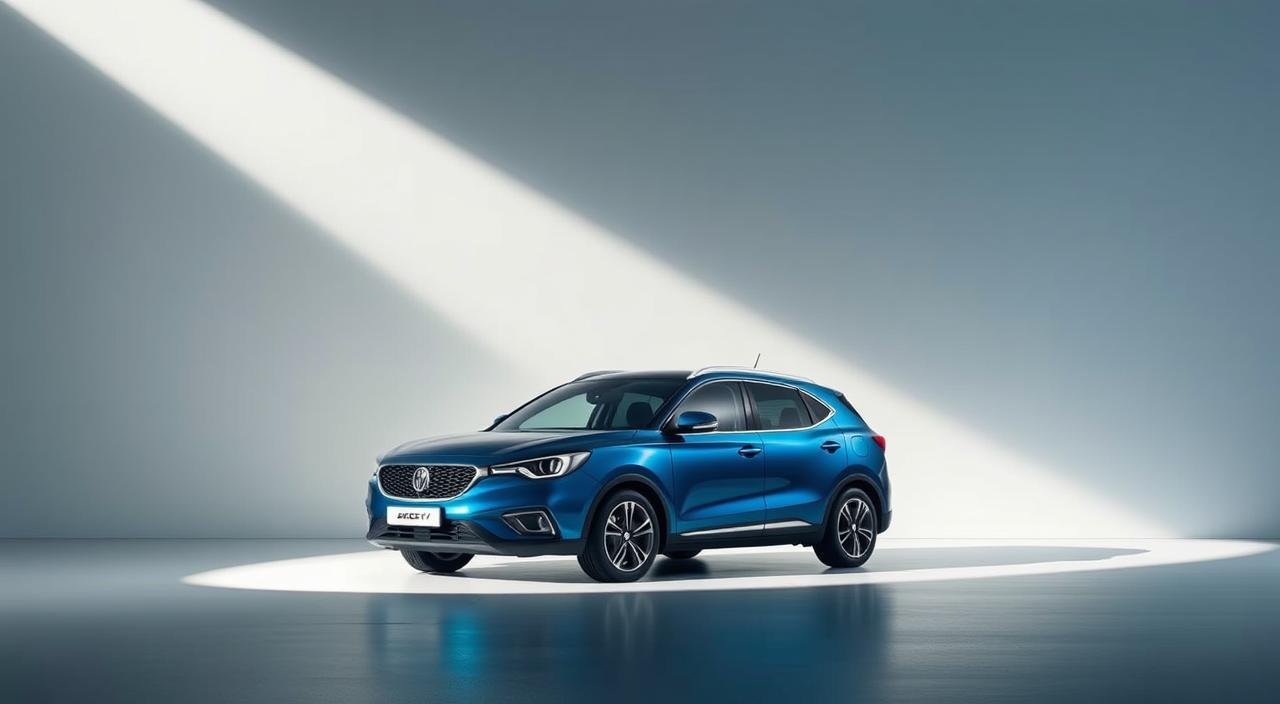
Jun
Why would an electric vehicle maker cut prices by up to ₹6 lakh? JSW MG Motor India is celebrating its sixth year with a big change. They’ve lowered prices for all five versions of their ZS EV electric SUV.
This move makes the MG ZS EV very competitive in India. Prices start at ₹16.75 lakh for the Executive model and go up to ₹20.50 lakh for the Essence. These prices are lower than what other cars cost.
The ZS EV is MG Motor India’s second car in India. Even though they sell about 600 cars a month, they think they can sell more. By cutting prices, they’re showing they believe in electric cars and want more people to use them.
Key Takeaways
- JSW MG Motor India celebrates its sixth anniversary with massive price cuts on the ZS EV
- Price reductions range from ₹13,000 to ₹4.44 lakh across all five variants
- The Executive variant now starts at ₹16.75 lakh, making it highly competitive
- MG ZS EV now undercuts major competitors including Tata Curvv EV and Hyundai Creta Electric
- The electric SUV averaged 600 units in monthly sales over the last six months
- This pricing strategy positions the ZS EV as a value leader in India’s growing EV market
Overview of the MG ZS EV Price Cut
The MG ZS EV has seen a big price drop across all models. This change shows a shift in the electric car market. It makes the car more appealing to Indian buyers, thanks to JSW MG Motor India’s sixth year in the country.
Details of the ₹6 Lakh Reduction
The price cut varies by model of the MG ZS EV. Each version now costs less, making it a better deal in its class. The new prices are a big change from the launch prices, which were up to ₹28 lakh in 2021-22.
| Variant | Old Price (₹) | New Price (₹) | Reduction (₹) |
|---|---|---|---|
| Executive | 16,88,000 | 16,75,000 | 13,000 |
| Excite Pro | 18,97,800 | 18,49,800 | 48,000 |
| Exclusive Plus | 23,64,800 | 19,49,800 | 4,15,000 |
| Essence | 24,93,800 | 20,49,800 | 4,44,000 |
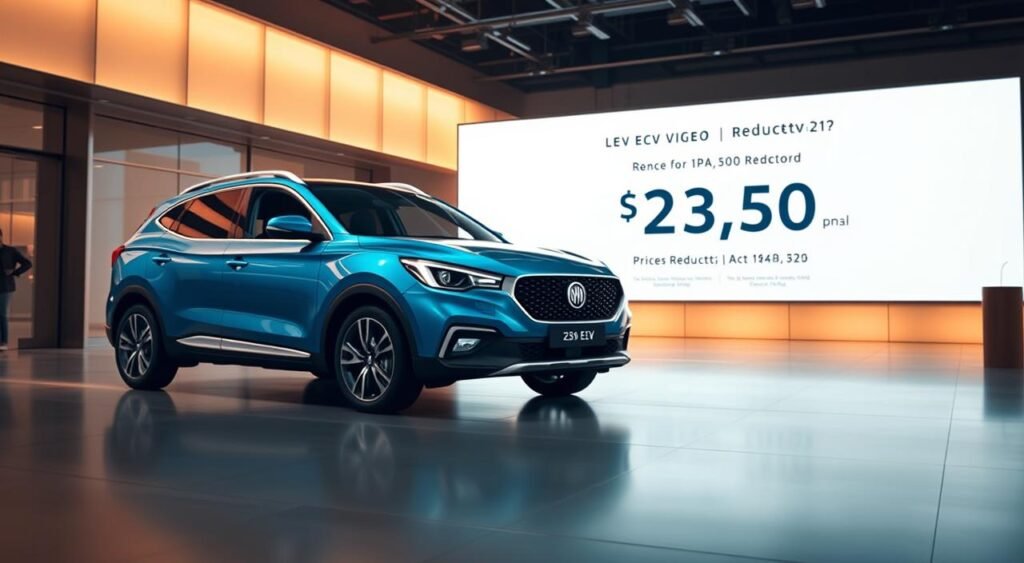
Reasons Behind the Price Slump
The big price drop comes from several factors. The MG Windsor EV’s success, selling 27,000 units, has put pressure on prices. It’s now a top choice for those looking for an affordable electric car.
Rakesh Sen, Head of Sales at JSW MG Motor India, made this move to celebrate the company’s anniversary. It shows the brand’s focus on making electric cars more affordable, following industry trends.
Implications for the Indian EV Market
This bold pricing move sets a new standard for electric SUVs in India. It challenges other brands to rethink their prices. The move could speed up EV adoption among those who couldn’t afford them before.
The price drop shows the EV market is growing. It’s now more about selling more cars than making more money. This helps both buyers and India’s goal of going electric, possibly leading to similar moves by other brands soon.
Understanding the Features of the MG ZS EV
The MG ZS EV is a top-notch electric vehicle. It offers great performance and lots of useful features. It’s perfect for those who want to be eco-friendly but don’t want to give up on luxury.
Performance and Specifications
The MG ZS EV has a strong electric motor and a big battery. This means it goes fast and handles well. It can go up to 461 kilometers on one charge, great for daily drives and weekend trips.
It also has a big boot for carrying lots of stuff. This makes it great for families.
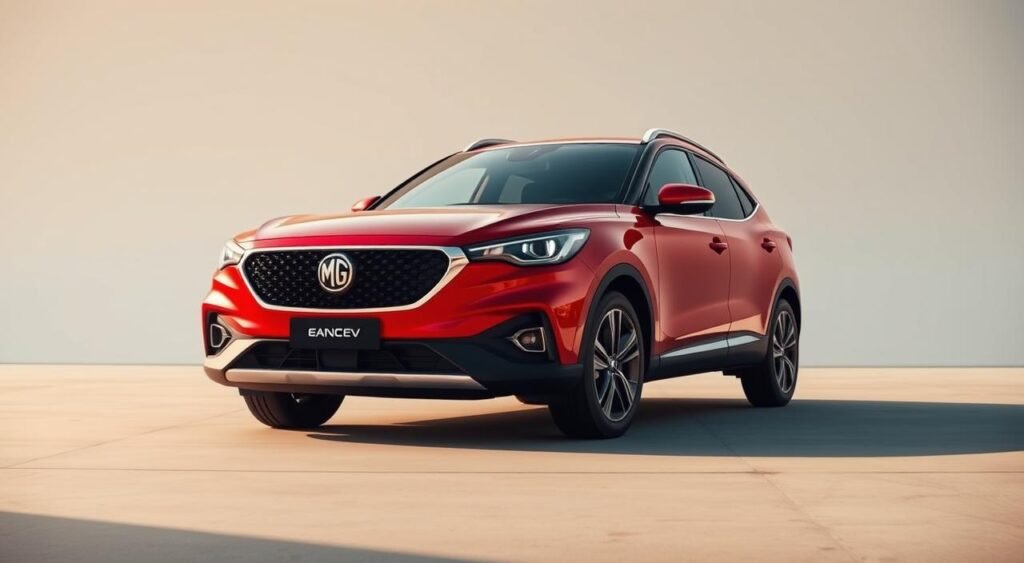
Charging Options and Battery Life
The MG ZS EV can be charged in different ways. You can use a fast charger to get 80% in 60 minutes. Or, charge it at home in about 9 hours.
This makes it easy to use for many different driving needs.
| Charging Type | Power Output | Charging Time |
|---|---|---|
| DC Fast Charging | 50 kW | 0-80% in 60 minutes |
| AC Home Charging | 7.4 kW | 0-100% in 9 hours |
Safety Features Overview
The MG ZS EV is very safe. It has lots of airbags, ABS, and parking sensors. It also has a rear camera and advanced driver assistance systems.
Inside, you’ll find cool features like digital displays, wireless charging, and automatic climate control. There’s even an air purifier and premium features like cruise control and a sunroof.
Comparative Analysis: MG ZS EV vs. Competitors
The electric SUV market in India is getting more crowded. MG Motor India has priced the ZS EV 100 Year Limited Edition at ₹19.50 lakh. This puts it right up against several big names. Knowing how it compares helps buyers make smart choices in the changing car market.
Rivals in the Indian Market
The MG ZS EV has to compete with several top electric vehicles. Each one has its own strengths:
| Model | Price (₹ Lakh) | Range (km) | Battery Capacity |
|---|---|---|---|
| MG ZS EV 100 Year Limited Edition | 19.50 | 461 | 50.3 kWh |
| MG Windsor EV Essence Pro | 18.31 | 331 | 38 kWh |
| Tata Nexon EV Empowered Plus 45 Red Dark | 17.19 | 390 | 40.5 kWh |
| Hyundai Creta Electric Smart (O) | 19.50 | 390 | 42 kWh |
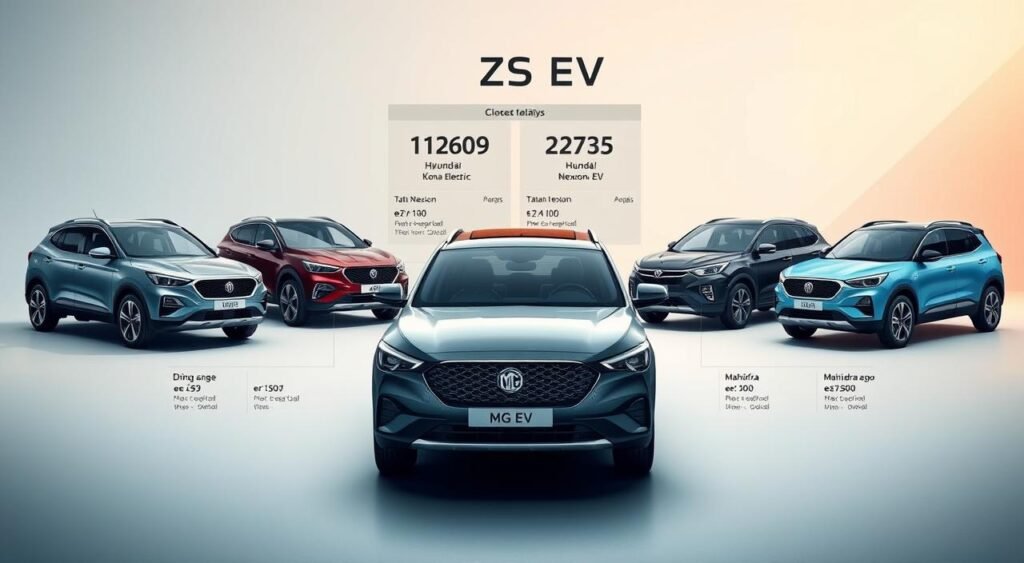
Value for Money Assessment
The ZS EV costs ₹19.50 lakh, matching the Hyundai Creta Electric’s price. But it has a longer range, making it great for those worried about running out of charge. Its bigger 50.3 kWh battery is worth the extra cost compared to the Tata Nexon EV, which is cheaper but has less range.
Features Unique to MG ZS EV
MG Motor India has packed the ZS EV with special features. Its 50.3 kWh battery capacity gives it the longest range in its class. It comes in Starry Black, Aurora Silver, Candy White, and Colored Glaze Red, more options than most.
Every version comes with a multi-function steering wheel, power-adjustable mirrors, and a touchscreen system. It’s a five-seater, keeping up with the competition while staying affordable. This shows how MG Motor India is keeping up with the latest car trends.
Customer Feedback and Reviews
MG ZS EV owners share real-life experiences that show its value proposition. It has a 4.2 out of 5 rating from 127 users. This electric SUV impresses both new EV buyers and car experts.
Owner Testimonials
MG ZS EV owners love the smooth, quiet ride and instant torque. They say the car goes over 350 kilometers on a single charge. This makes daily trips worry-free.
The car’s interior is spacious, with leather seats and a sunroof. This adds to its luxury feel. First-time EV owners save a lot on fuel costs over time.
They also like the car’s tech, like the big touchscreen. It makes driving more enjoyable. Plus, they spend less on car maintenance than with gas or diesel cars.
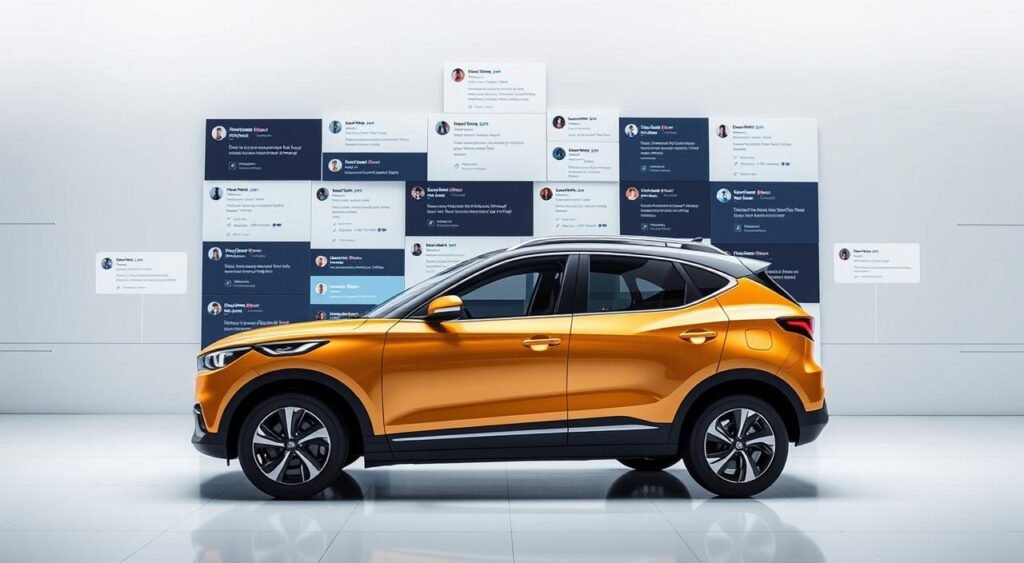
Expert Reviews from Automotive Analysts
Car critics see the MG ZS EV as a top choice for a long-range electric SUV. They say it’s worth considering, even if it’s a bit old compared to newer models. They think it’s a great deal after its price drop.
Common Concerns Among Users
The biggest issue is the air conditioning not working well in very hot weather. The compressor stops working when it’s over 40 degrees Celsius. This makes summer trips uncomfortable.
Also, not enough charging stations outside big cities make planning trips hard. This affects the car’s use for long trips, impacting long-term ownership.
Long-Term Value: Is It a Smart Investment?
The MG ZS EV’s price drop makes us think about its *long-term ownership* value. It’s smart to look at the whole financial picture over years. Electric cars offer a different *value proposition* than gas cars, with their own benefits and costs.
Depreciation Rates for EVs
Used MG ZS EVs in Delhi show interesting depreciation trends. 2023 models with 32,000 to 41,000 kilometers sell for about ₹18.50 lakh. 2022 models with more miles cost between ₹15 to ₹20 lakh. This shows electric cars hold their value well.
The *sustainability* aspect also plays a part. More people want eco-friendly cars that keep their value.
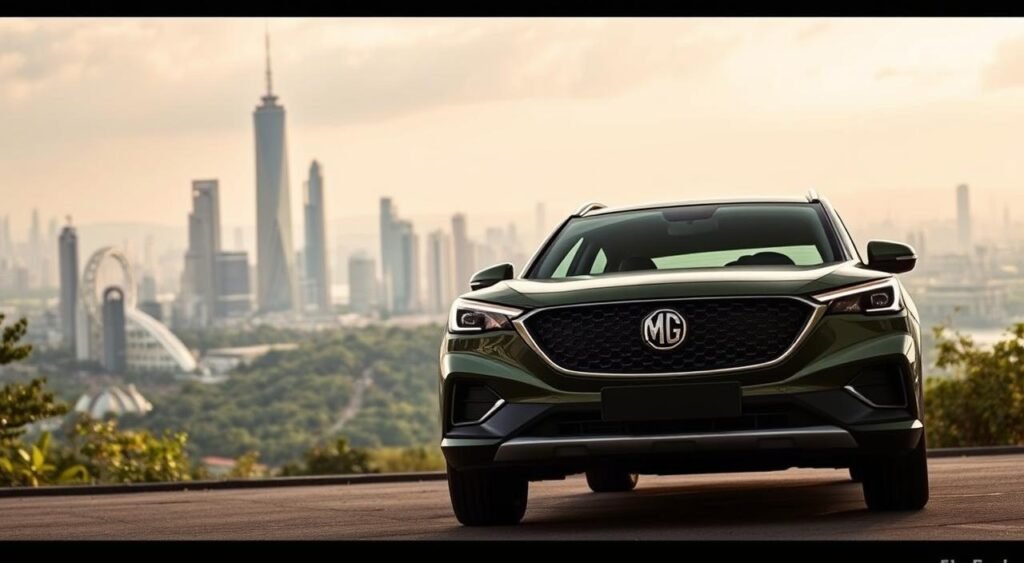
Total Cost of Ownership
Looking at total costs, MG ZS EV owners save a lot. Electric cars need less maintenance because they have fewer parts. Charging is much cheaper than gas or diesel.
Insurance costs about ₹80,618 based on battery size. EMI plans start at ₹36,084 monthly for the base model. This makes it affordable for many.
Comparing with Traditional Vehicles
Some say the MG Astor petrol saves ₹5 lakh upfront. But, this doesn’t account for fuel and service costs over time. Electric cars have steady costs and help clean the air in cities.
Choosing between electric and gas cars depends on your needs, environment concerns, and *long-term ownership* goals.
The Future of Electric Vehicles in India
India’s electric vehicle scene is changing fast. Sales are up, thanks to new models and lower prices. This is a big moment for the car industry in India.
Government Policies Supporting EV Adoption
The Indian government is helping EVs grow. They have set up programs like:
- FAME II scheme with big subsidies for EVs
- GST cut from 12% to 5% on electric cars
- State bonuses like no road tax
- PLI scheme for making batteries
Infrastructure Development for EVs
More charging spots are needed for EVs to become common. Cities are getting more public charging stations. The goal is to have 2.9 million by 2030.
Market Trends and Consumer Preferences
People want electric SUVs more than ever. Sales are high across many brands. City folks like EVs for their cheap running costs and green benefits.
Potential Issues with the MG ZS EV
The MG ZS EV’s price drop makes it more affordable. But, there are challenges to consider for long-term ownership. Knowing these issues helps you decide if this electric car from MG Motor India is right for you.
Common Mechanical Issues
One big problem is the air conditioning system’s performance in hot weather. When it’s over 40°C (104°F), the AC compressor often stops. This leaves people uncomfortable, mainly in northern and western India during summer.
The battery also loses power in extreme heat, affecting range. Some users face issues with the charging port at public stations. They might need adapters or find other ways to charge.
Software and Technology Updates
The car’s infotainment and connected features need regular updates. Despite the latest trends, the MG ZS EV’s tech seems outdated. The i-SMART system sometimes lags and has connectivity problems, worse in areas with poor networks.
After-Sales Service Evaluation
MG Motor India has grown its service network. But, it’s not as wide as some other car makers. Finding EV experts in smaller cities can be hard, leading to longer wait times for repairs. While more parts are available, some are hard to get, causing delays.
Conclusion: Is the MG ZS EV Worth Buying in 2025?
The MG ZS EV’s price drop is a game-changer in India’s electric vehicle market. Now priced between ₹16.75 lakh and ₹20.50 lakh, it’s more affordable. It offers advanced features like driver assistance systems and luxury interiors at a great price.
Summary of Key Considerations
The ZS EV has a range of 461 kilometers, perfect for city and highway trips. Its electric motor provides smooth performance without noise. It also comes with premium features like a panoramic sunroof and large touchscreen, all at a lower cost than competitors.
But, the air conditioning system may not handle extreme heat well. This is something to think about before buying.
Final Recommendations for Buyers
Urban families looking for a second car will love the MG ZS EV. Its price is now competitive with the Tata Nexon EV Max and Hyundai Kona Electric. It’s a good choice for those who value reliability and established service networks.
But, if you need strong cooling or the latest battery tech, you might want to look at newer models.
The Evolving Landscape of Electric Vehicles
India’s electric vehicle market is booming, with new models coming out every month. Government subsidies and better charging infrastructure are helping it grow. The MG ZS EV’s price cut shows the increasing competition and benefits of scale.
Smart buyers will look at the total cost of ownership, not just the price. The ZS EV offers great value for those ready to go electric.
FAQ
What is the new price range for the MG ZS EV after the recent price reduction?
The MG ZS EV now starts at ₹16.75 lakh for the Executive variant. It goes up to ₹20.50 lakh for the Essence variant (ex-showroom). The price cuts range from ₹13,000 to ₹4.44 lakh, making it more affordable than before.
How does the MG ZS EV’s battery range compare to its competitors?
The MG ZS EV has a 461 km driving range on a single charge. Its 50.3 kWh battery capacity is impressive. This range is better than most rivals, making it great for those worried about range anxiety.
What are the charging infrastructure options for the MG ZS EV?
The MG ZS EV supports DC fast charging and AC charging. A 50 kW DC fast charger can charge to 80% in 60 minutes. AC charging with a 7.4 kW charger takes about 9 hours for a full charge, perfect for overnight charging.
What is the major concern reported by MG ZS EV owners?
Many owners say the air conditioning struggles in temperatures over 40 degrees Celsius. The AC system often shuts down the compressor, which is a big issue in hot climates.
How does the long-term ownership cost of the MG ZS EV compare to traditional vehicles?
MG ZS EV owners see big savings on vehicle expenses. Electricity costs are lower than petrol/diesel. Maintenance costs are minimal, but insurance is about ₹80,618 based on battery size. EMI options start at ₹36,084/month for the base variant.
What impact has the MG Windsor EV had on ZS EV sales?
The MG Windsor EV’s success has affected ZS EV sales. The ZS EV averages only 600 units in six months. This has led JSW MG Motor India to cut prices significantly.
Is the MG ZS EV worth buying in 2025 despite being an older model?
Despite being older, the MG ZS EV’s price cut makes it attractive. It has a great 461 km range, safety features, and competitive pricing. But, buyers should consider the AC issues and their needs.
What are the key sustainability benefits of choosing the MG ZS EV?
The MG ZS EV is good for the environment with zero tailpipe emissions. It has a lower carbon footprint than traditional vehicles. Choosing an EV supports environmental goals and saves money on running costs.
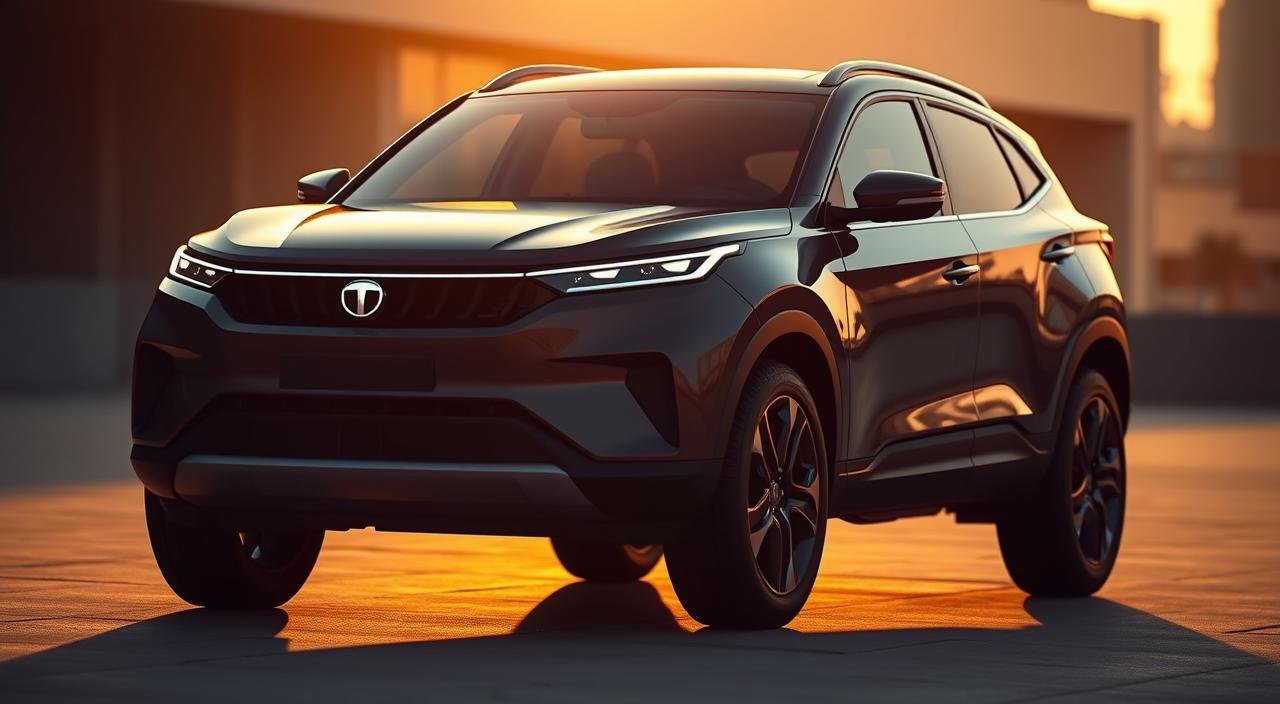
Jun
Are you wondering what sets the Tata Harrier EV apart from the regular Harrier? The buzz around the new Mahindra Bolero 2025 is huge, but Tata’s electric SUV is also getting attention. The EV version has cool features that the regular Harrier doesn’t. It’s packed with advanced tech and better performance. Is the electric Harrier the top SUV for today’s drivers?
The Tata Harrier EV brings the SUV to a new level with its features. It has a bigger infotainment system for staying connected and fun. The boss mode lets you control it from the back seat. You also get a digital IRVM for a clear view behind and a 540-degree camera for full visibility.
With summon mode, your Harrier EV can come to you! Auto park assist makes parking easy. Plus, it has special EV features like V2V and V2L for more uses.
Key Takeaways
- Tata Harrier EV offers unique features compared to the regular Harrier
- Advanced tech includes a larger infotainment system, boss mode, and digital IRVM
- 540-degree camera and auto park assist enhance visibility and convenience
- Summon mode allows the Harrier EV to come to you
- EV-specific functions like V2V and V2L provide added versatility
Introduction to Tata Harrier Models
The Tata Harrier is a hit in India, loved for its sleek design, comfy interior, and strong performance. With the upcoming Mahindra Bolero model in 2025, Tata Motors is adding diesel and electric Harriers. This meets the needs of many customers.
Overview of Tata Harrier
Launched in 2019, the Tata Harrier is built on the OMEGA Arc platform, inspired by Land Rover’s D8. It has a roomy cabin, top-notch features, and a smooth ride. The Harrier’s main specs are:
| Specification | Details |
|---|---|
| Engine | 2.0L Kryotec Diesel |
| Power | 168 bhp @ 3750 rpm |
| Torque | 350 Nm @ 1750-2500 rpm |
| Transmission | 6-speed Manual / Automatic |
| Seating Capacity | 5 Passengers |
Brief Introduction to Tata Harrier EV
The Tata Harrier EV is coming in 2024, as the electric version of the SUV. It will have a big battery and the latest electric tech. This makes it a green choice for those who care about the planet.
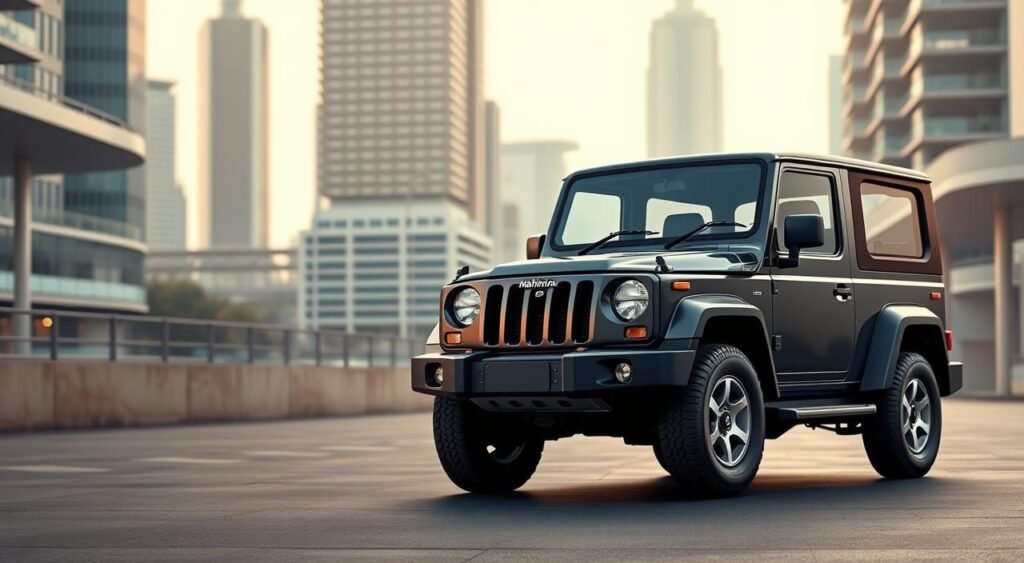
Importance of EV Technology
Electric cars are becoming more popular because they’re good for the environment and save money. The Tata Harrier EV shows how important EVs are getting in the car world. As more people choose electric, car makers like Tata are working hard to make better EVs. This helps us move towards a cleaner, greener future.
Performance Comparison: EV vs Regular
The Tata Harrier EV and the regular Harrier offer different driving experiences. The electric version has instant torque and quick acceleration. This makes it exciting for those who love a thrilling drive.
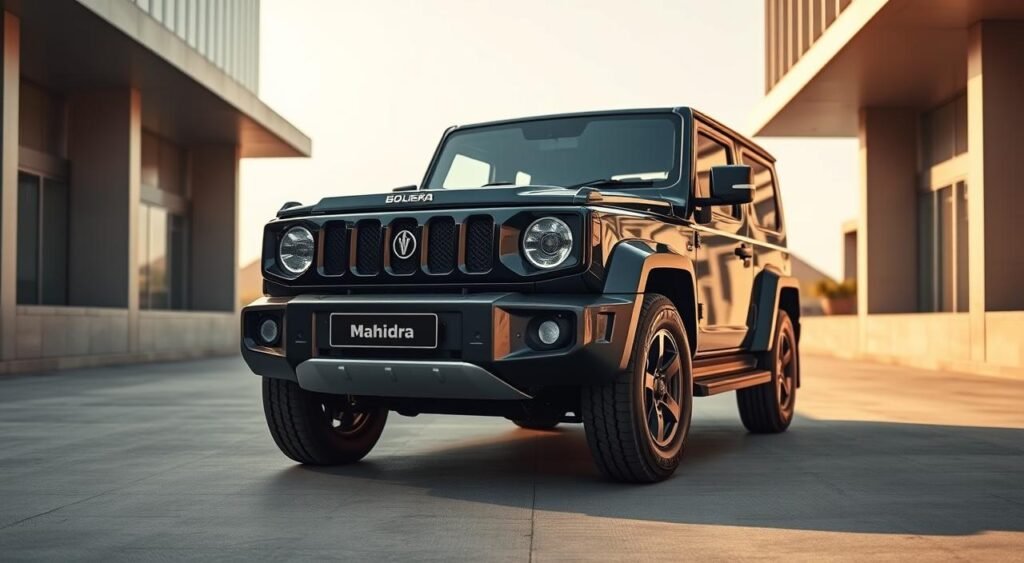
Acceleration and Torque Differences
The Harrier EV accelerates from 0 to 100 km/h in just 7 seconds. Its electric motor provides instant torque for a smooth, powerful start. In contrast, the regular Harrier, with a 2.0-liter diesel engine, takes about 10 seconds to reach the same speed.
Driving Range of the Harrier EV
The driving range is a key factor for electric vehicles. The Tata Harrier EV has two battery options. The base model offers up to 350 km on a single charge. The higher-end model has a range of 627 km, certified by MIDC.
Fuel Efficiency of Regular Harrier
The regular Harrier is fuel-efficient, despite not being electric. Its 2.0-liter diesel engine gets around 16 km/l in the city and up to 20 km/l on highways. This makes it a cost-effective choice for those who prefer traditional engines.
As Mahindra Bolero prototype spotted testing shows, car makers are working on both electric and traditional engines. Whether you want fast acceleration and eco-friendliness or long-distance driving and fuel savings, the Tata Harrier lineup has something for everyone.
Design Elements: Aesthetic Changes
The Tata Harrier EV and its regular version share a similar design. But, the electric version has unique exterior features that make it stand out. The 2025 Bolero rumors are exciting, but the Harrier EV is already making a splash with its looks.
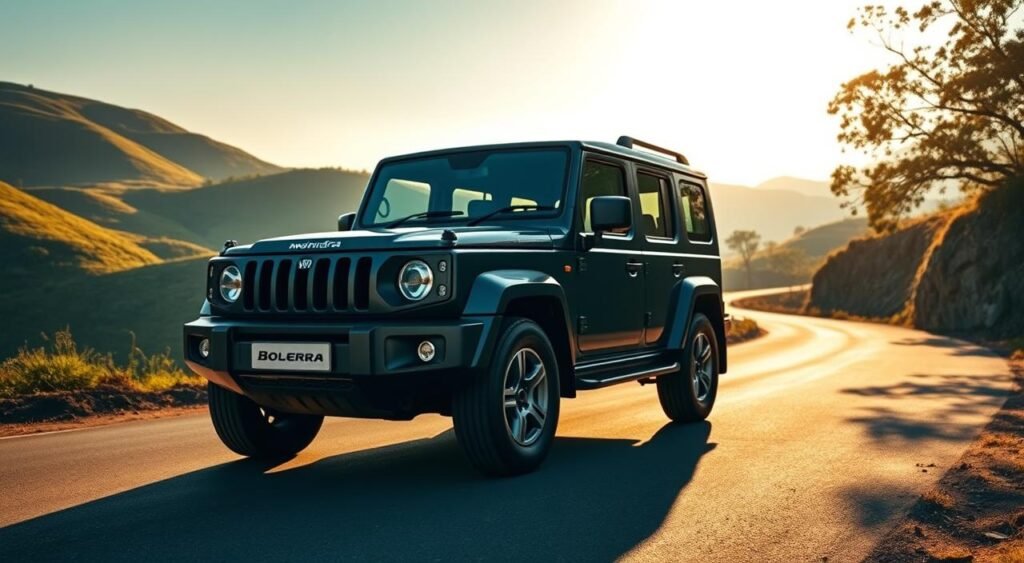
Exterior Features of the Harrier EV
The Harrier EV has a closed-off grille for a sleek look. Its bumpers are updated for better aerodynamics. It also has special alloy wheels that are stylish and improve its performance.
Interior Styling and Comfort
Inside the Harrier EV, you’ll see a layout similar to its regular sibling. But, it has a bigger 14.53-inch infotainment screen for a better multimedia experience. It also has extra comfort features, like boss mode for more legroom in the back.
Unique Color Options Available
The Tata Harrier EV comes in exciting colors:
- Sparkle Blue
- Copper Bronze
- Pristine White
- Midnight Black
These colors make the Harrier EV eye-catching on the road. They appeal to eco-conscious buyers. As people wait for the Mahindra Bolero test drive, the Harrier EV’s colors are already drawing attention.
Technology and Infotainment Comparison
The Tata Harrier EV is a step up from the regular Harrier in tech and infotainment. It has an advanced system called TiDAL. This system allows for cool features like OTA updates, voice commands, and a 540-degree camera system.
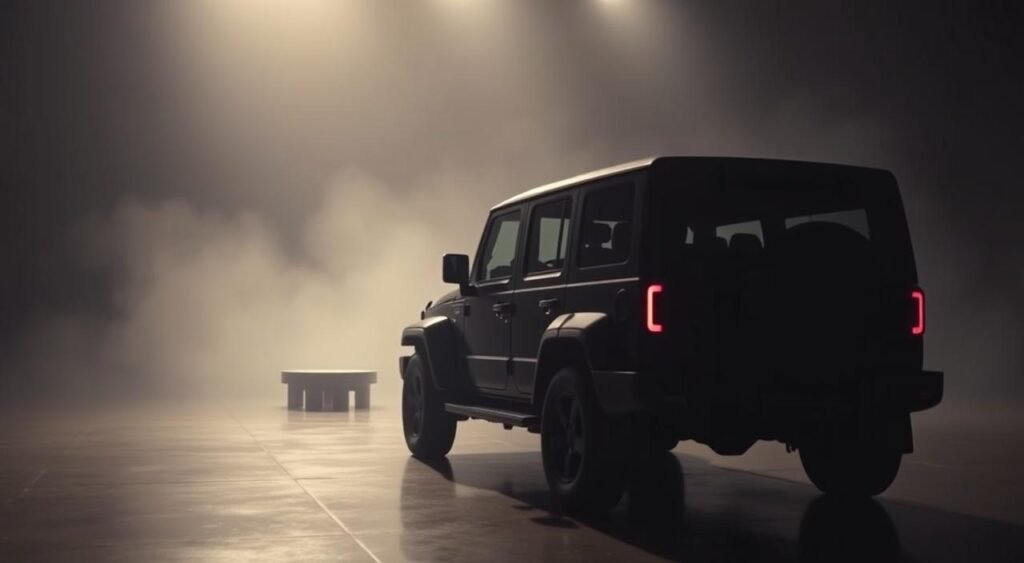
The Harrier EV also has Level 2 ADAS for better safety and convenience. It has a digital rear view mirror, automatic park assist, and a summon mode. This mode lets you call the car to you with your phone.
Connectivity Features in Each Model
Both Harrier models have connectivity features for fun and info on the move. They include:
- Connected car tech with remote access
- Wireless Android Auto and Apple CarPlay
- Built-in navigation
- Premium audio system
Integrated Safety Technologies
Tata Motors focuses on safety in both Harrier models. The EV has more advanced safety features like:
| Harrier EV | Regular Harrier |
|---|---|
| Level 2 ADAS | Electronic Stability Program (ESP) |
| 540-degree surround view | Rear parking sensors |
| Digital IRVM with dashcam | Dual front airbags |
| Auto park assist and summon mode | ABS with EBD |
User Interface and Experience
The Tata Harrier EV has a modern interface with a large touchscreen. It controls all infotainment and settings. The regular Harrier also has a user-friendly interface but is less advanced.
The Harrier EV leads in tech and infotainment, making driving better and keeping you connected. Yet, both models offer great connectivity and safety features for today’s drivers.
Battery and Charging Infrastructure
The Tata Harrier EV has top-notch battery tech. It offers great capacity and charging options for a smooth drive. With more EV charging stations popping up, driving an electric car like the Harrier EV is easier than ever.
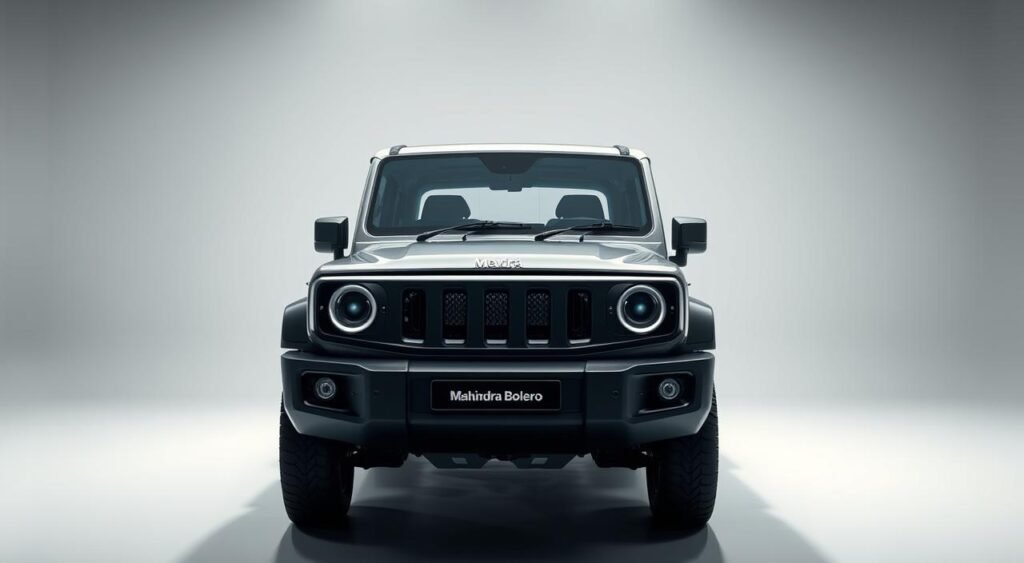
Battery Capacity of the Harrier EV
The Tata Harrier EV has two battery packs: 65 kWh and 75 kWh. These batteries give the car lots of power and range. The Lithium Iron Phosphate tech makes the battery safe and stable, perfect for the Mahindra Bolero 2025.
Charging Options and Times
Tata gives Harrier EV owners several charging choices. The time it takes to charge depends on the charger type:
- 7.2 kW AC Charger: A full charge takes about 10.7 hours
- 120 kW DC Fast Charger: Charges 20-80% in just 25 minutes
These options let Harrier EV owners charge at home or public stations. It’s easy to keep the battery charged for daily drives or long trips.
Benefits of EV Charging Stations
India’s growing EV charging stations are a big plus for electric car owners. These stations offer many benefits:
- Convenience: Find and use charging points easily with apps or car systems
- Fast Charging: Quick top-ups are available for long drives
- Cost-effective: Charging at public stations is cheaper than gas cars
As more EV charging spots appear, owning an EV like the Tata Harrier EV is more appealing. It’s great for those who care about the environment and want a reliable, efficient car.
Sustainability and Environmental Impact
The Tata Harrier EV is a big step towards a greener future. More people now think about how their cars affect the planet. The Harrier EV is a great choice for those who care about the environment, thanks to its low emissions.
Emissions Reduction with the EV
The Tata Harrier EV cuts down on carbon emissions a lot. Electric cars don’t have tailpipe emissions like gas cars do. So, driving the Harrier EV makes the air cleaner and helps our health.
When the Mahindra Bolero 2025 price is out, the Harrier EV will be an even better choice for those who want to help the planet.
Recycling and Sustainability Initiatives
Tata Motors works hard to make their cars better for the environment. They focus on recycling and using materials that can be reused. By choosing the Harrier EV, you support a company that cares about the planet.
The Future of Eco-Friendly Driving
Electric cars like the Tata Harrier EV are the future of driving. They’re getting better with new battery tech and more charging spots. Choosing electric cars helps us all live in a cleaner world.
The Mahindra Bolero 2025 is coming, but the Tata Harrier EV is already leading the way in India.
Cost of Ownership: EV vs Regular
Looking at the Tata Harrier EV and its regular version, we see a difference in cost over time. The initial price is not the only thing to consider. Maintenance costs and resale value are also key to the overall cost.
Purchase Price Comparison
The Tata Harrier EV costs more at first than the regular Harrier. The electric version starts at Rs 21.49 lakh (ex-showroom). But, electric cars can save money in the long run.
Maintenance Costs Over Time
The Tata Harrier EV has lower maintenance costs. Electric cars have fewer parts and no need for oil changes. This means less money spent on upkeep.
| Model | Estimated Annual Maintenance Cost |
|---|---|
| Tata Harrier EV | Rs 5,000 – Rs 8,000 |
| Regular Tata Harrier | Rs 10,000 – Rs 15,000 |
The table shows the Tata Harrier EV can save money on maintenance. This makes it a good choice for those watching their budget.
Resale Value Analysis
The resale value of electric cars is growing in India. As EVs become more common, their value will likely go up. But, the regular Harrier might have a slight edge in resale value now.
Choosing between the Tata Harrier EV and the regular Harrier depends on what you value most. The EV is cheaper to run and better for the environment. But, the regular Harrier is more affordable upfront and might hold its value better in the short term. Looking at the Mahindra Bolero 2025 interior and images, it’s important to think about these costs when deciding.
Driving Experience: Customer Feedback
The Tata Harrier EV has caught the eye of many. People who have driven it share their thoughts. Their feedback helps us understand how it performs in real life.
Test Drive Experiences
Those who’ve driven the Tata Harrier EV love its quick start and smooth ride. It’s quiet and easy to drive, perfect for city or highway. The steering and suspension make it comfortable and stable.
User Reviews and Ratings
Online, people love the Tata Harrier EV. They say it’s roomy and has a great interior. The tech inside is easy to use, and they like how it looks and drives.
Community Insights
A community of fans has grown around the Tata Harrier EV. They talk about its range and how to get the most out of it. Their enthusiasm shows it’s a big deal in India’s electric car market.
More people trying the Tata Harrier EV means more good words. It’s a hit for its looks, comfort, and being green. With happy owners, it’s set to change the car scene in India.
Unique Features of Tata Harrier EV
The Tata Harrier EV has special features that make it stand out. These features improve the driving experience and add advanced technology and safety. This makes the Harrier EV a great choice for those looking for a modern electric vehicle.
Multiple Driving Modes
The Tata Harrier EV has different driving modes for various situations:
- Eco Mode: Saves energy for better efficiency
- City Mode: Balances performance and efficiency for city driving
- Sport Mode: Shows off the electric powertrain for a fun drive
- Boost Mode: Gives extra power for quick maneuvers
Innovative Tech Features
The Harrier EV offers advanced tech for comfort and convenience:
| Feature | Description |
|---|---|
| DrivePay | A UPI-based in-car payment system for easy transactions |
| Boss Mode | Powered seats for second-row passengers, adding luxury |
| Cooled Storage | A sliding armrest with a cooled compartment for drinks and snacks |
Advanced Safety Mechanisms
- Off-Road Assist: Improves traction and stability on rough terrains
- Transparent Mode: Gives a virtual view of the road, helping with obstacles
- 360-Degree Camera: Offers a bird’s eye view for easy parking and maneuvering
The Tata Harrier EV has unique driving modes, tech features, and safety measures. It offers a modern and safe driving experience, making it different from the regular Harrier and other vehicles.
Conclusion: Which Harrier is Right for You?
Choosing between the Tata Harrier EV and the regular Harrier depends on what you need. The Harrier EV is great for those who love tech and want to be eco-friendly. It has cool features and doesn’t pollute, making it perfect for the modern driver.
The regular Harrier is a good pick for those watching their budget. It runs on diesel and is known for being reliable. It’s a solid choice for those who like the old-school way of driving.
Key Takeaways
The Tata Harrier EV and the regular Harrier both perform well in their own ways. The EV gives you quick power and smooth rides. The regular Harrier has strong power and is good for long trips.
Both Harriers focus on keeping you safe. They come with advanced safety features and are built to last. This is similar to what we can expect from the Mahindra Bolero 2025.
Final Thoughts on Performance
Choosing between the Tata Harrier EV and the regular Harrier depends on your lifestyle. If you want something new and green, the EV is for you. But if you’re looking for something more affordable, the regular Harrier is a solid choice.
Selecting Based on Lifestyle Needs
It’s all about what you need and want. If you care about the planet and want the latest tech, go for the EV. But if you’re on a budget and like the traditional way of driving, the regular Harrier is a great option.
Think about how you drive, your daily commute, and what you want in the long run. This will help you choose the right Harrier for you, just like you would with the Mahindra Bolero 2025.
FAQ
What are the main differences between the Tata Harrier EV and the regular Harrier?
The Tata Harrier EV and regular Harrier have different features and performance. The EV has a bigger infotainment system and boss mode. It also has a 540-degree camera and auto park assist.
The EV has EV-specific functions like V2V and V2L. The regular Harrier has a 2.0-liter diesel engine with 170 hp and 350 Nm of torque.
How does the performance of the Tata Harrier EV compare to the regular Harrier?
The Harrier EV has impressive performance with its electric powertrain. It offers instant torque and quick acceleration. The EV has a range of up to 627 km.
In contrast, the regular Harrier has a 2.0-liter diesel engine with 170 hp and 350 Nm of torque.
Are there any exterior design differences between the Tata Harrier EV and the regular Harrier?
The Harrier EV and regular Harrier share a similar design. The EV has a closed-off grille and unique alloy wheels. The interior is mostly the same, but the EV has a larger infotainment screen.
The EV also has boss mode for more comfort.
What advanced technology features are available in the Tata Harrier EV?
The Harrier EV has advanced technology like a new electrical architecture (TiDAL). It enables OTA updates and voice commands. It also has a 540-degree surround view and Level 2 ADAS.
The EV has a digital IRVM with a built-in dashcam and auto park assist. It also has summon mode.
What are the battery options and charging times for the Tata Harrier EV?
The Tata Harrier EV has two LFP battery pack options: 65 kWh and 75 kWh. Charging times vary. A 7.2 kW AC charger takes 10.7 hours for a full charge.
A 120 kW DC fast charger can charge to 80% in 25 minutes.
How does the Tata Harrier EV contribute to reducing environmental impact?
The Tata Harrier EV reduces carbon emissions and promotes eco-friendly driving. Electric vehicles produce zero tailpipe emissions. This makes them a cleaner alternative to traditional vehicles.
Tata Motors is investing in recycling and sustainability. They aim to minimize environmental impact throughout a vehicle’s life cycle.
What is the cost difference between the Tata Harrier EV and the regular Harrier?
The Tata Harrier EV costs more than the regular Harrier. The entry-level Adventure trim starts at Rs 21.49 lakh (ex-showroom). Electric vehicles have lower maintenance costs.
They have fewer moving parts and no need for regular oil changes.
What are customers saying about their experience driving the Tata Harrier EV?
Customers love the Harrier EV’s instant torque and smooth acceleration. They also appreciate its quiet operation. User reviews highlight the EV’s advanced features and comfortable interior.
The Harrier EV community is growing. Owners share their experiences and insights on various platforms.
What unique features does the Tata Harrier EV offer compared to other EVs?
The Tata Harrier EV has unique features like multiple driving modes. It also has a UPI-based in-car payment system (DrivePay). The EV offers advanced safety features like off-road assist and transparent mode.
It provides enhanced comfort with features like a powered boss mode. It also has a sliding armrest with cooled storage.
How do I decide between the Tata Harrier EV and the regular Harrier?
The Tata Harrier EV and regular Harrier meet different needs and preferences. The EV offers advanced technology and eco-friendly credentials. It’s suitable for tech-savvy buyers who value sustainability.
The regular Harrier has a diesel engine and lower price. It may appeal to customers who prioritize affordability and have concerns about EV charging infrastructure. The choice depends on individual lifestyle needs, budget, and access to charging facilities.
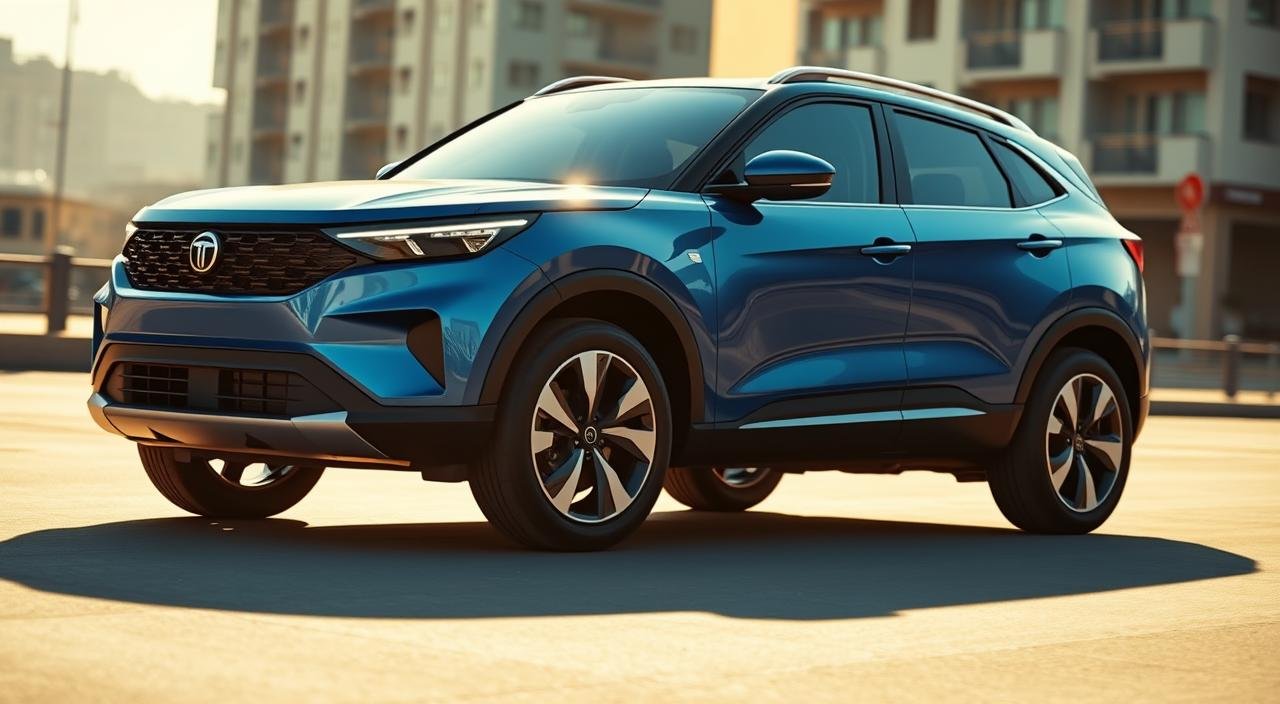
Jun
Are you ready to see the future of green cars in India? Tata Motors has unveiled the Tata Harrier EV, a game-changing electric SUV. It’s set to change the Indian car market with its advanced tech and strong performance. Let’s dive into 10 amazing images that show off the Harrier EV’s design and features.
The Tata Harrier EV starts at Rs 21.49 lakh, making it a great choice for those who care about the planet. It has two battery packs and can go up to 627 km on a single charge. You can choose from three variants and four colors, including a special Stealth Black for the Stealth Edition.
Key Takeaways:
- The Tata Harrier EV is Tata Motors’ flagship electric SUV, packed with advanced features
- Two battery pack options provide a claimed range of up to 627 km
- Available in three variants and four color options, including an exclusive Stealth Black
- Introductory ex-showroom price of Rs 21.49 lakh makes it an attractive eco-friendly option
- Set to revolutionize the Indian electric vehicle market with cutting-edge technology and performance
Overview of the Tata Harrier EV
The Tata Harrier EV is a game-changing electric vehicle. It combines the latest technology with a sleek design. Built on Tata’s advanced Acti.ev platform, it offers an unmatched driving experience. This SUV shows Tata’s dedication to innovation in electric vehicles.
What Makes the Tata Harrier EV Unique?
The Tata Harrier EV stands out with its unique features. Its design is both familiar and futuristic. It keeps the iconic SUV look but adds modern touches like a sealed-off grille and blue accents.
It also has smart features for better convenience and functionality. These include:
- Vehicle-to-Load (V2L) capability, allowing you to power external devices
- Vehicle-to-Vehicle (V2V) charging for sharing power with other EVs
- Innovative ‘Summon Mode’ for remote parking and retrieval
Key Features and Innovations
The Tata Harrier EV is powered by cutting-edge electric technology. Its high-capacity battery and efficient motors offer great range and performance. Fast charging makes it easy to recharge.
Inside, the Harrier EV is spacious and tech-savvy. The infotainment system and digital cluster make for a smooth experience. Premium materials and design elements make the interior luxurious and comfy.
Exterior Design Highlights
The Tata Harrier EV has a stunning exterior design. It combines bold looks with smooth aerodynamics. The front of this electric SUV grabs your attention with its striking features.
Eye-Catching Front Grille and Headlights
The Harrier EV’s front grille has a unique design with sleek lines. It proudly shows off the Tata logo in the center. The LED headlights, shaped like triangles, add an aggressive look.
Below, a wide air intake with vertical slats looks good and helps cool the vehicle.
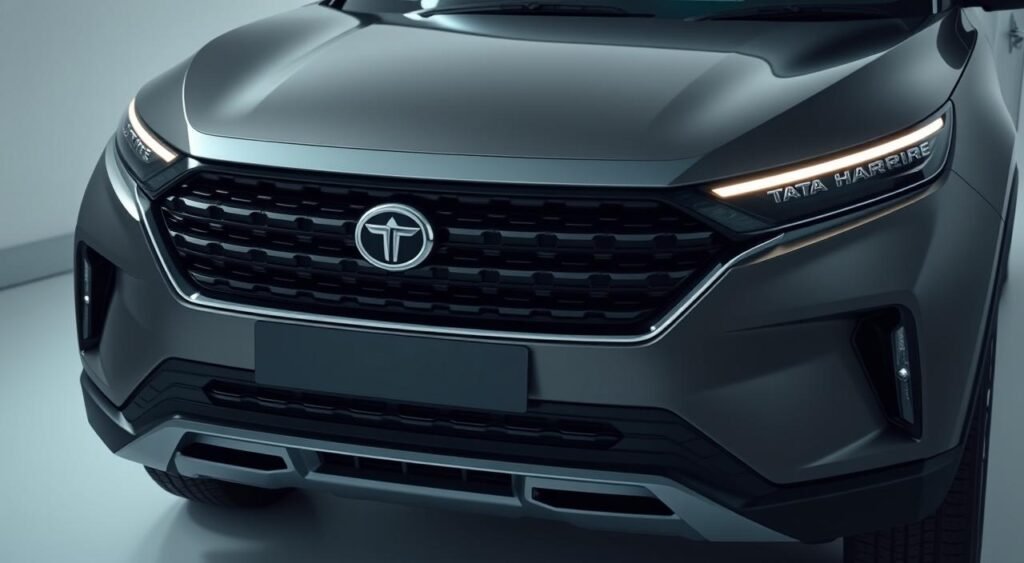
Sleek Body Lines and Stance
From the side, the Harrier EV looks similar to its gas-powered version. Its body lines show strength and athleticism. Black body cladding adds a rugged look and protects against minor damage.
The 19-inch dual-tone alloy wheels make the SUV look even more powerful. Subtle EV badging shows it’s an eco-friendly car.
Color Options and Finishes
Tata offers the Harrier EV in four exciting colors. This lets customers pick a color that matches their style. For a unique look, there’s a special matte Stealth Black edition.
Interior Comfort and Technology
When you enter the Tata Harrier EV, you’ll find a roomy and stylish interior. It features a dual-tone color scheme of white and grey, with premium leatherette seats. The SUV offers power-adjustable and ventilated front seats, a boss mode for the co-passenger, and rear AC vents for the best climate control.
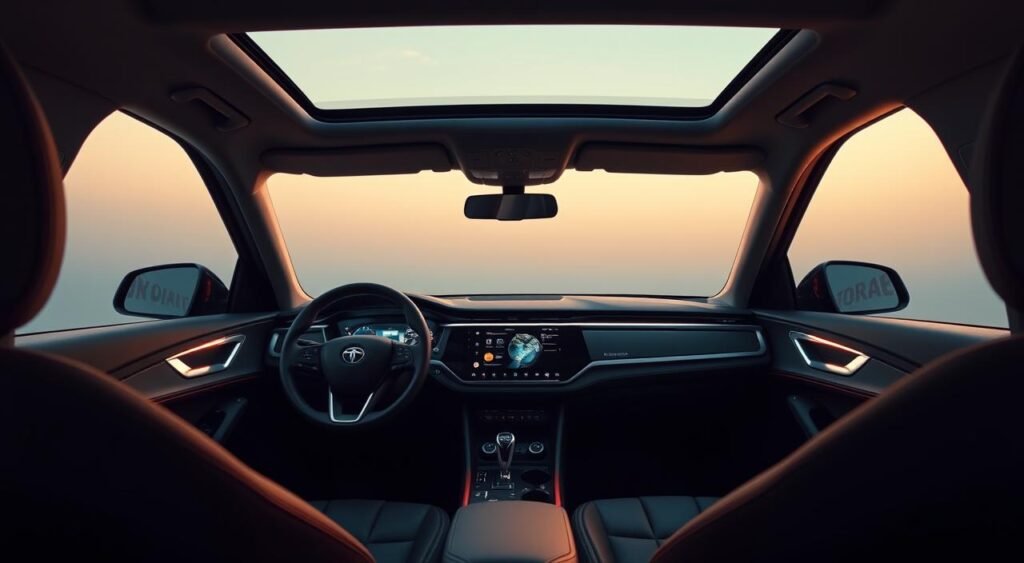
Spacious Cabin Layout
The Tata Harrier EV’s interior is designed for comfort and space. It has plenty of legroom and headroom for everyone, making long trips comfortable. The seats are ergonomically designed and adjustable, adding to the comfort.
Infotainment System Features
The heart of the Tata Harrier EV’s tech is its 14.5-inch QLED touchscreen. It controls navigation, media, and vehicle settings. The system also includes a 10.25-inch digital driver’s display for quick info access. You’ll find dual-zone climate control and a 10-speaker JBL audio system for great sound.
Safety Features Available
The Tata Harrier EV focuses on safety with many advanced features. It has seven airbags for protection in accidents. A 360-degree camera system makes parking easier. It also has blind spot monitoring, ESC, TPMS, and Level 2 ADAS for safer driving.
Performance Specifications
The Tata Harrier EV offers top-notch performance thanks to its advanced electric powertrain. It comes with two battery pack sizes and strong motor setups. This makes for an exciting drive.
Electric Powertrain Overview
The Harrier EV has a 65 kWh or 75 kWh battery pack. The rear-wheel drive version has 238 PS. The all-wheel drive version has 390 PS and 504 Nm of torque.
When Boost Mode is on, the AWD Harrier EV goes from 0 to 100 kmph in 6.3 seconds. This gives a thrilling boost of power.
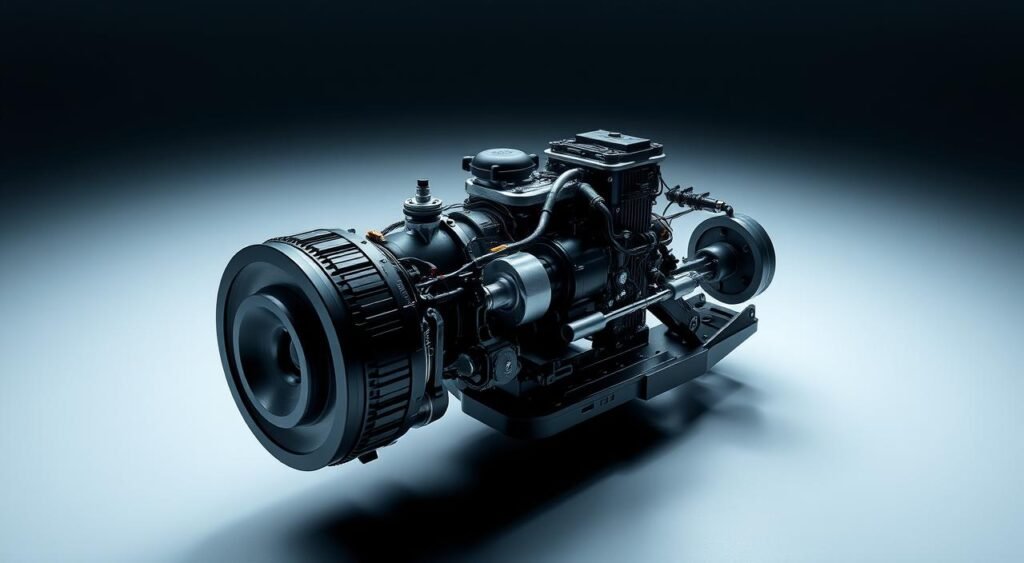
Range and Charge Time
The 75 kWh battery pack gives the Harrier EV a range of up to 627 km. This means you can go on long trips without needing to charge often. It supports both AC and DC fast charging.
| Charging Type | Charging Power | Charging Speed |
|---|---|---|
| AC Charging | 3.3 kW / 7.2 kW | 8-10 hours (0-100%) |
| DC Fast Charging | 120 kW | 25 minutes (20-80%) 15 minutes (up to 250 km range) |
Driving Experience and Handling
The Tata Harrier EV offers a smooth drive with instant torque. Its low center of gravity makes it stable and easy to handle. The regenerative braking system also boosts energy efficiency and allows for single-pedal driving.
With its strong performance, long range, and quick charging, the Tata Harrier EV is a top choice. It offers an exciting and eco-friendly driving experience.
Sustainability Initiatives
The Tata Harrier EV is a big step for Tata Motors in going green. It’s an electric car that helps cut down on carbon emissions. It shows Tata Motors’ dedication to making eco-friendly cars.
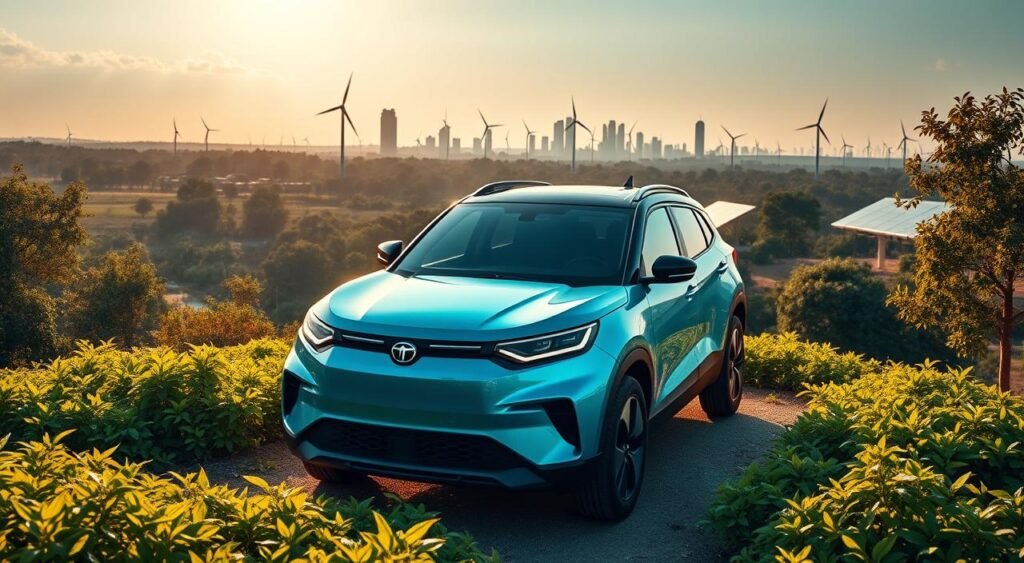
The Harrier EV uses materials that are good for the planet. Tata Motors picked these materials to be both green and strong. They use recycled and sustainable stuff to cut down on waste and save resources.
Eco-Friendly Materials Used
The Tata Harrier EV has many green materials inside and out. These include:
- Recycled plastics in the dashboard, door panels, and trim
- Sustainable fabric upholstery from recycled stuff
- Bio-based plastics from plant oils
- Lightweight aluminum and steel to make it more efficient
Tata’s Commitment to Green Energy
Tata Motors goes beyond just using green materials. They also focus on green energy for the Harrier EV’s whole life. This includes:
| Initiative | Description |
|---|---|
| Renewable Energy | Tata Motors is putting money into solar and wind power. They want to use less fossil fuel in making cars. |
| Charging Infrastructure | Tata is growing the number of EV charging stations in India. This makes it easier for Harrier EV owners to charge up with green energy. |
| Recycling Programs | Tata Motors has recycling plans for old car parts and batteries. This helps reduce waste and protect the environment. |
Tata Motors is making the Harrier EV a green choice for those who care about the planet. It’s a car that’s good for the environment without losing out on performance or looks.
Comparisons with Competitors
The Tata Harrier EV is set to shake up the electric SUV market. But how does it stack up against its rivals? Let’s dive into the Tata Harrier EV comparison with the Mahindra XEV 9e and the BYD Atto 3.
How the Harrier EV Stacks Up Against Rivals
The Tata Harrier EV shines with its impressive range and quick charging. The Mahindra XEV 9e has similar features. But the BYD Atto 3 leads with its longer range and faster charging.
Yet, the Harrier EV’s sleek design and roomy interior give it a comfort and style edge.
| Feature | Tata Harrier EV | Mahindra XEV 9e | BYD Atto 3 |
|---|---|---|---|
| Range (km) | 400 | 380 | 420 |
| Fast Charging Time (0-80%) | 60 min | 70 min | 50 min |
| Battery Capacity (kWh) | 60 | 55 | 60 |
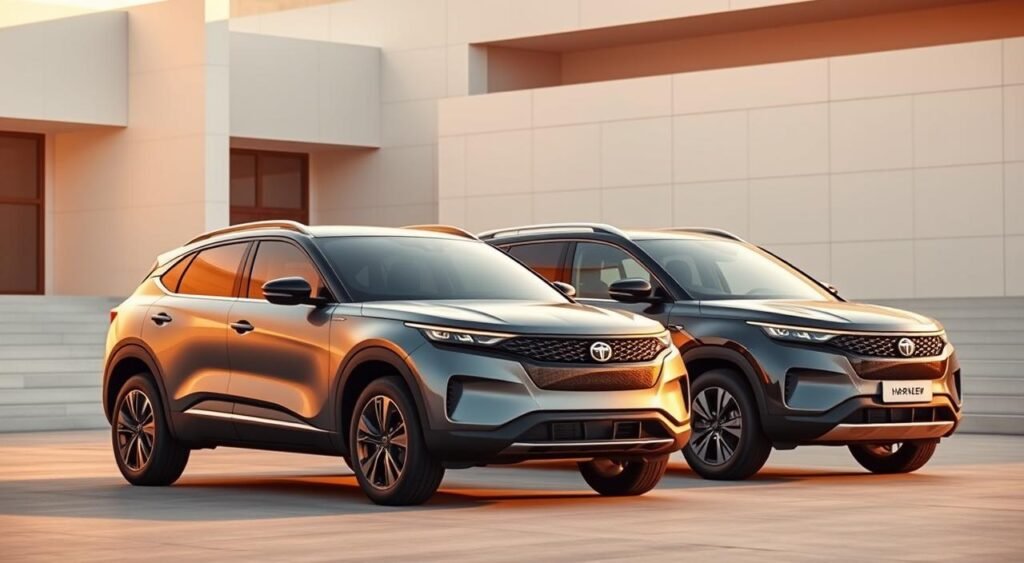
Pricing Comparison Overview
The Tata Harrier EV’s pricing is yet to be fully revealed. But it starts at Rs 21.49 lakh (ex-showroom). This makes it a competitive choice against the Mahindra XEV 9e and the BYD Atto 3.
Bookings for the Harrier EV open on July 2, 2025. This gives interested buyers a chance to be among the first to try this advanced electric SUV.
While we wait for more details, it’s clear the Tata Harrier EV is set to make a big splash. With its mix of performance, style, and price, it’s definitely worth watching for those looking at electric SUVs.
User Testimonials and Reviews
The Tata Harrier EV is making waves, with both early users and car experts sharing their thoughts. Their feedback and reviews give us a peek into what this electric SUV is like. They talk about its performance, features, and value.
Real User Experiences
Harrier EV owners love its range, design, and tech. They say it’s roomy and comfy inside, and easy to drive. People also appreciate how it handles different roads well, thanks to its suspension and electric power.
Expert Opinions on the Harrier EV
Car experts see the Tata Harrier EV as a big deal in electric SUVs. They say it’s a great mix of style, performance, and price. They like its long range, quick charging, and smart features, making it a top pick for eco-friendly buyers.
FAQ
What is the starting price of the Tata Harrier EV?
The Tata Harrier EV starts at Rs 21.49 lakh, ex-showroom.
What is the claimed range of the Tata Harrier EV?
It has two battery packs. The range is up to 627 km (MIDC).
How many variants and color options are available for the Harrier EV?
There are three variants and four colors. Plus, a special Stealth Edition in Stealth Black.
What smart features does the Harrier EV offer?
It has V2L, V2V charging, and a ‘Summon Mode’ for remote movement.
What are the interior features of the Harrier EV?
Inside, you’ll find a dual-tone cabin with leatherette seats. It has power-adjustable and ventilated front seats. There’s also a boss mode for the co-passenger seat and rear AC vents.
It comes with a 14.5-inch QLED screen, a 10.25-inch digital display, and dual-zone auto AC. Plus, a 10-speaker JBL audio system.
What are the performance specifications of the Harrier EV?
It comes with 65 kWh and 75 kWh batteries. The RWD version has 238 PS. The AWD version has up to 390 PS and 504 Nm.
It goes from 0-100 kmph in 6.3 seconds with Boost Mode. It supports 3.3 kW and 7.2 kW AC charging, and 120 kW DC fast charging.
How does the Harrier EV contribute to Tata Motors’ sustainability initiatives?
As an electric vehicle, it supports Tata’s goal to reduce environmental impact. It uses eco-friendly materials, showing Tata’s commitment to green energy.
What are the Harrier EV’s main competitors?
Its main rival is the Mahindra XEV 9e. The BYD Atto 3 is also a competitor.
When will bookings for the Harrier EV open?
Bookings start on July 2, 2025.
What are the initial user reviews and expert opinions on the Harrier EV?
Users love it for being an excellent electric car with great features at a good price. Experts praise its design, range, and smart features. They see it as a top choice in electric SUVs.
